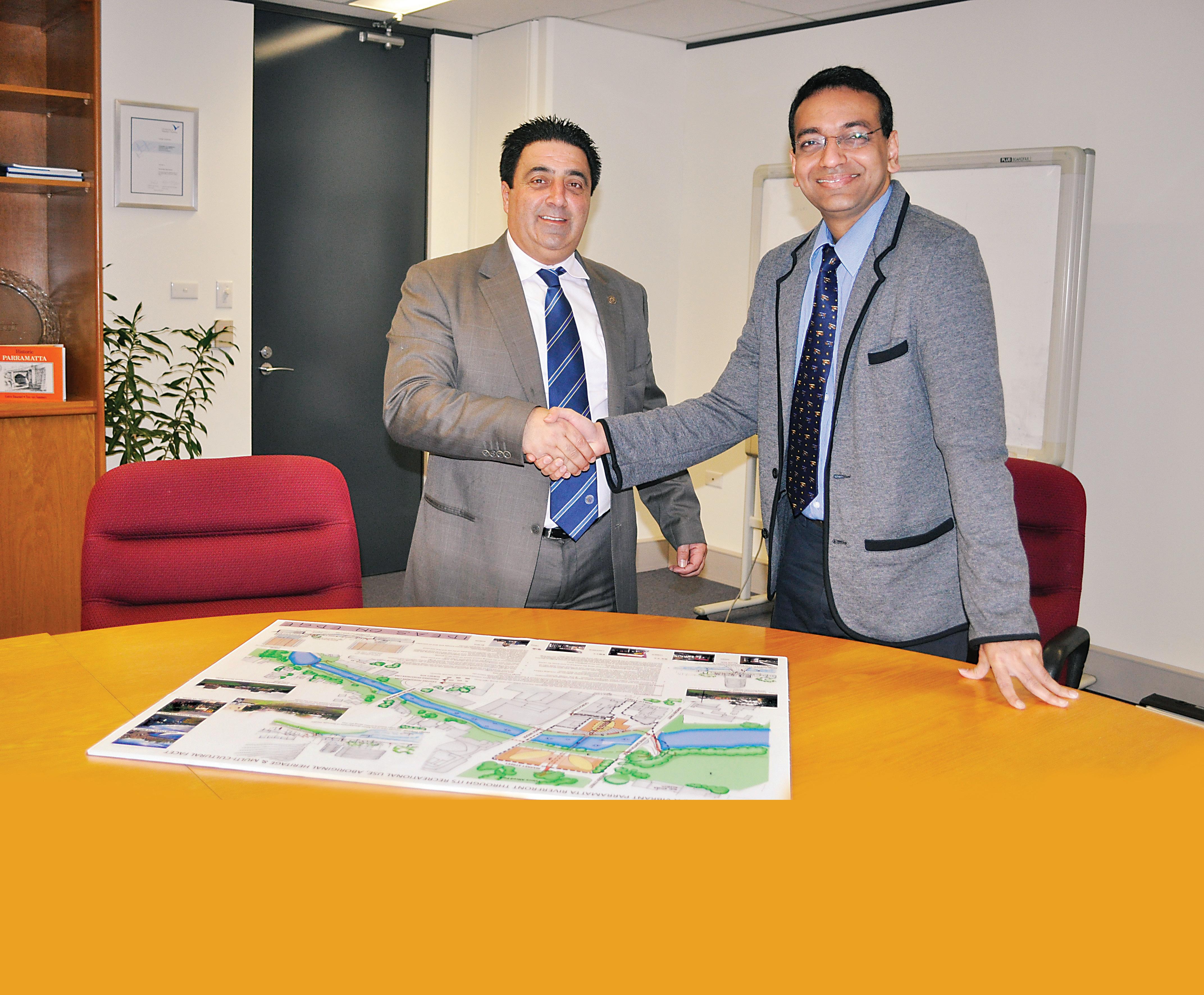

FREE Vol. 18 No.10 (2) • July (2) 2011 • www.indianlink.com.au • FORTNIGHTLY SYDNEY Level 24/44 Market St, Sydney 2000 • GPO Box 108, Sydney 2001 • Ph: 18000 15 8 47 • email: info@indianlink.com.au Sydney • Melbourne • Adelaide • Brisbane • Perth • Canberra Designed to win Architect Nilesh Munot shares his vision for Parramatta with Lord Mayor John Chedid Indian Link Radio 24/7 on the net Log on to www.indianlink.com.au Indian Link 24/7 Radio 18000 15 8 47

2 <> JULY (2) 2011 INDIAN LINK

JULY (2) 2011 <> 3 NATIONAL EDITION

4 <> JULY (2) 2011 INDIAN LINK
INDIAN LINK
PUBLISHER
Pawan Luthra
EDITOR
Rajni Anand Luthra
ASSISTANT EDITORS
Sheryl Dixit, Gaurav Pandey
MELBOURNE
Preeti Jabbal
CONTRIBUTORS
Usha Ramanujam Arvind, Pallavi Singhal, Sandip Hor, Roy Lange, Saroja Srinivasan, Dilip Jadeja, Noel G deSouza, Noopur Singhal, Anusha Menon, Pallavi Sinha, Rani Jhala, Shafeen Mustaq, Shraddha Arjun, Neelam Vasudevan, Astha Singh, Sumana Devi, Minal Khona
ADVERTISING MANAGER
Vivek Trivedi 02 9262 1766
ADVERTISING ASSISTANT
Nitika Sondhi 02 9279 2004
GRAPHIC DESIGN AND LAYOUT
Indian Link Design Department
Indian Link is a fortnightly newspaper published in English. No material, including advertisements designed by Indian Link, maybe reproduced in part or in whole without the written consent of the editor. Opinions carried in Indian Link are those of the writers and not necessarily endorsed by Indian Link. All correspondence should be addressed to
Indian Link
Level 24/44 Market St, Sydney 2000 or GPO Box 108, Sydney 2001
Ph: 02 9279-2004 Fax: 02 9279-2005
Email: info@indianlink.com.au


Media watch
They hacked into the message bank of a missing girl and deleted messages, giving hope to the anguished parents and police that she was still alive. This was but one of a series of abhorrent acts committed by people allegedly in the pay of tabloid media in the United Kingdom. Since then a 168-year-old newspaper has closed down, over 200 staff have been sacked, the editor has been arrested, the owners have had to face Parliament, senior police have resigned and there is even pressure on the British Prime Minister to step down.
Internationally, there have been calls for a fresh look into the power and influence of the media.
Having successfully established and run an ethnic newspaper for now almost 20 years and a 24/7 radio station for almost 9 years, I am very aware of the responsibility that a media organisation owes to its readers/listeners. Albeit at a very small scale as compared to mainstream papers, we still have a moral responsibility to meet the needs of our audience.
Media plays an important part in any society and over the years, differing forms of media have increased. From print to radio to television, to internet and social media, there are now not only many ways for a message to be publicised, there are also many different
BY PAWAN LUTHRA
types of media persons. A former editor of The Sydney Morning Herald once said that for him, a valuable journalist is not one who can write the story, but one who also has an effective narration style to voice the audio part, and one who is well versed in video skills to tell the same story in a 90-second video. While the skill levels of professional journalists have broadened, so has the manner in which government and institutions tell their side of the story. Public relation firms, spin doctors, advertising companies, all come together to corral the information through a tunnel of their own making, so that their side of the story is presented in a manner which is most suitable to them. Facts can be underpresented or hidden from scrutiny, and it is up to the media to sift through what is not said or presented so that they can impart the correct facts to their readers. Wikileaks is an important side of the media that can counter despicable acts, such as that of the News of the World. Wikileaks have boldly exposed issues of public concerns which were being
held back by various governments. While some observers have called these leaks damaging, others believe that the public’s right to know is more important.
At Indian Link, we strongly believe that our readers come first, and we have always striven to be respectful of their intelligence and integrity. Articles in the newspaper need to have the capacity to challenge them; it is easy to dumb down a paper by churning out press releases as articles, but the challenge is to research and present issues which will stimulate and educate. While we recognise the need to support our advertisers, this can be undertaken in an honest and transparent way by ensuring that this is clearly identified as separate from a regular article. As a community paper, we need to balance your needs seeking out those who are making us proud in this, our new homeland. Those who are abusing their positions need to be admonished; however, it is important to play the game, not the man. We are a small community and collectively we can prosper; individually, we will always be hampered by those communities who hunt in a pack.
Our readers are the sole arbitrators of our reason for being. By being true to them, we will be true to ourselves.
JULY (2) 2011 <> 5 NATIONAL EDITION www.indianlink.com.au EDITORIAL
What’s On
FUNDRAISERS
Bollywood and the Jewels of Bengal
Sunday 24 July Avijit Sarkar and musicians of Jazba band present a music concert in aid of the Australian Hindi Indian Associations Senior Citizens Group from 4 to 7pm. For details call Avijit Sarkar 0425 275 883.
Yaadon Ki Baarat
Saturday 20 August Vijay Jogia and Daxa Chauhan present a charity music night in aid of RAIN seniors group from 5:30 pm. Also featuring Bhangra, DJ music by Mayank and Dandiya Raas. For details email sdevmurari@ hotmail.com
The Light for Life trivia night
Saturday, 27th August, 7pm for 7:30pm start at the Don Moore Community Centre, North Rocks. Come join a fun filled trivia night with lots of songs and dancing. Tickets are $20, and includes dinner. All proceeds raised will go to Lifehouse at RPA, for the Chris O’Brian Cancer Centre. For tickets, sponsorship or to make a donation, please contact Swati Jain 0412 439 596 or swati86@ live.com.au or visit http://www.lifehouserpa. org.au/index.aspx
SPIRITUAL
Chinmaya Mission Programs
Friday 29 July (8pm) to Saturday 30 July (6pm) Local Youth Camp ‘Step Up and Meet the Infinite’ for the age group 18-30 years at Chinmaya Sannidhi, 38 Carrington Road, Castle Hill. For registration call Saumya Kandoi on 0400 999 907 or Chinmaya Sannidhi on 02 8850 7400.
Friday 12 August (8pm) to Saturday 13 August (6pm) Ladies Retreat
‘Madhurashtakam – Discovering Your Inner Beauty’ at Chinmaya Sannidhi, 38 Carrington Road, Castle Hill. For registration call Mahal on 0411 899 554. Last date Monday 1 August.
Ramakrishna Sarada Vedanta Society of NSW activities
Sundays, Special Lecture Series Celebrating 175th Birth Anniversary of Sri Ramakrishna, 10.40 am to 12noon at Vedanta Hall, 15 Liverpool Road, Croydon.
Sunday 24 July Universalism & Particularism: Aspects of Sri Ramakrishna’s Religious Teachings and Experiences. Talks by Prof.Raja Jayaraman and Rev.Pravrajika Ajayaprana Mataji.
Sunday 7 August Ramakrishna, the Spiritual Oasis. Talks by Cr.Larry Whipper and Rev. Pravrajika Ajayaprana Mataji
Sunday 28 August Sri Ramakrishna’s Advice to Householders. Talks by Dr. D.P.Chaudhri and Rev. Pravrajika Ajayaprana Mataji For details on above events call 9745 4320 or email vedantasyd@idx.com.au
STAGE
Twilight Concert Series
Friday 29 July, 7pm to 8pm (doors open at 6.30pm) at Prince Henry Centre, 2 Coast Hospital Road, Little Bay. Nirmal Jena and the Odissi Music and Dance Company present Soul to Soul, music for healing and meditation, Nirmal Jena, a
classical musician and composer is also a virtuoso of traditional Indian ragas and leads a vibrant contemporary musical movement by incorporating instruments and musicians from other traditions. Nirmal will be accompanied by vocalists Aiswarjini Tripathy and Nancy Rahman, percussionist
Tony Lewis and Mark Davies on strings.
Tickets: $11.20 and $8.20 (conc) including booking fee. Refreshments will be available for purchase. Call 1300 306 776 MCA Tix or visit www.mca-tix.com.au, or contact odcsydney@yahoo.com.au
MISCELLANEOUS
Sakhi Sangam
Sunday 24 July Sydney Sakhi Sangam will be held at the Croatioan Club. 921 Punchbowl Rd (Cnr Canterbury Rd), Punchbowl. For details call Nandini Thadani 02 9181 2204, Sushma Ahluwalia 02 9894 0070.
ANSA Open Day
14 August, 1pm onwards. The Applied Neuroscience Society of Australasia will run a conference and public open day at SMC Conference and Function Centre, 66 Goulburn Street, Sydney. ANSA is a not for profit membership organisation interested in promoting brain health and technologies to enhance brain function. Its approach includes diagnosis and intervention for those with brain disorders, and also encompasses peak performance for those wishing to make a great brain even better. Come and learn more about the brain and how to improve it. For more details contact Sue-Ellen Taylor on 0407 130 222/ 02 6688 8019 or email: sueellen.taylor@bigpond.com
Essay competition
Essay competition on ‘Relevance of Mahatma Gandhi Today’ is open for the year 2011. For details email info@bhavanaustralia. org
2011 Young Writers Competition
The Transcultural Mental Health Centre is calling for creative writers aged between 12 to 24 years across NSW to enter TranSCRIBE. The theme is ‘Half Way Home’. Last date Mon 1 August. Entries are to be emailed or uploaded to the TranSCRIBE website. For details visit www.dhi.gov.au/tmhc/transcribe
Crestwood Badminton Association
Crestwood Badminton Association has a 22 year long badminton playing history in Sydney’s Hills District and players of different ethnic backgrounds come to play here. The Association is looking for new members who would like play badminton regularly. The new members will be able to play on Wednesdays from 7.00pm till 10.00 pm and Saturdays from 7.00 am till 10.00am. For more details contact Basker Ratnam on 0459 183 644.
Sakhi Sangam

Sunday 21 August Sakhi G Sakhi, a Marathi community program for ladies by ladies will be held at Granville Community and Youth Centre from 10 am to 5 pm. Please visit www.marathi.org.au for details or contact Manjusha Ranadive on 02 9626 6566 or Shweta Pradhan on 02 9629 3319
Formal launch of legal centre, its website
four years
BY PALLAVI SINHA
The formal launch of Toongabbie Legal Centre (TLC) and its website took place recently at the church hall where it operates in Toongabbie. TLC is a community legal centre providing free legal advice, referral service and information. TLC started its operations on 13 October 2007 as a Saturday only community legal service. Since July 2009, TLC has offered a Thursday evening legal service in addition to Saturdays.

TLC also conducts community legal education seminar and contributes to law reform. “We wanted to hold a formal function after our feasibility has been tested and our legal service has been firmly established,” Honorary Coordinator of TLC, Susai Benjamin said. “We have established a track record of sustaining
The dedicated volunteers at TLC comprise of solicitors, migration agents, law students, educators, information technologists, social workers, financial experts and community activists
ourselves for almost four years with the support of over 60 volunteers and we feel this is good time to hold a formal launch and at the same time celebrate our success
Hon. Robert McClelland, Federal Attorney General; Laurie Ferguson, Member for Reid; Paul Lynch, Member for Liverpool; and Julie Owens, Member for Parramatta.
Speeches were given by the Hon. Justice Margaret Beazley, Patron of TLC, the Hon Robert McClelland and representatives of the Law and Justice Foundation and TLC. The Hon Robert McClelland stated that TLC is an example of access to justice at grass roots level. He paid tribute to the great work that TLC has done with the collaboration of volunteers, and noted the valuable funding provided by the Law and Justice Foundation. He highlighted that the involvement of lawyers in probono services is a third higher than it was four
experts and community activists. According to Mr. Benjamin, since its commencement, TLC has assisted over 800 clients with over 1000 client visits. Assistance has been provided in areas such as consumer and community law, criminal law including domestic violence and victims of violence, traffic offences, family and employment law, property law, debt collection, guardianship, neighbourhood disputes, discrimination and immigration. Appointments are not necessary and TLC operates a drop-in service on Thursdays between 6.30 pm and 8.30 pm and Saturdays between 10 am12.45 pm.
For more information about the TLC and their projects, see website www.tlc.asn. au or phone 1300 373 353.
so far.”
The formal launch of TLC was opened with a vibrant east African dance. Light snacks were provided to a huge crowd that filled the church hall and comprised of members of the community and social welfare groups. Federal and State Members of Parliaments were present such as the
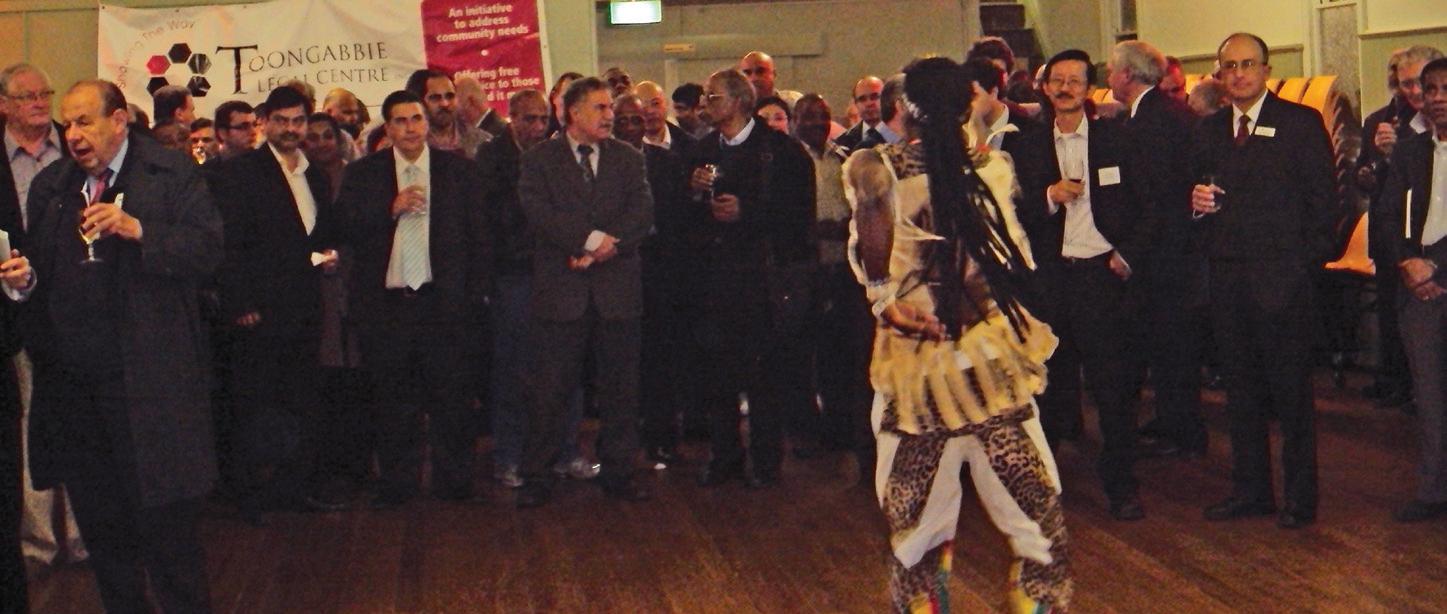
years ago. The Principal Solicitor of TLC, Michael Vassili, said that TLC has provided 2000 consultations to the community and operates with few resources.
The dedicated volunteers at TLC comprise of solicitors, migration agents, law students, educators, information technologists, social workers, financial
In relation to future plans, Mr. Benjamin said “I am optimistic of the future and hope that the Federal Government and State Government will see the rationale for the existence of the community legal service based in Toongabbie. We are now working on the proposal to open an Outreach Legal Service in Blacktown.”
6 <> JULY (2) 2011 INDIAN LINK
The Toongabbie-based centre has been providing free legal advice, referral service and information to residents for almost
“We wanted to hold a formal function after our feasibility has been tested and our legal service has been firmly established”
Susai Benjamin
The Honorary Coordinator of TLC, Susai Benjamin shaking hands with The Honourable Robert McClelland, Federal Attorney-General (right).
People enjoying an east African dance held as part of the event.
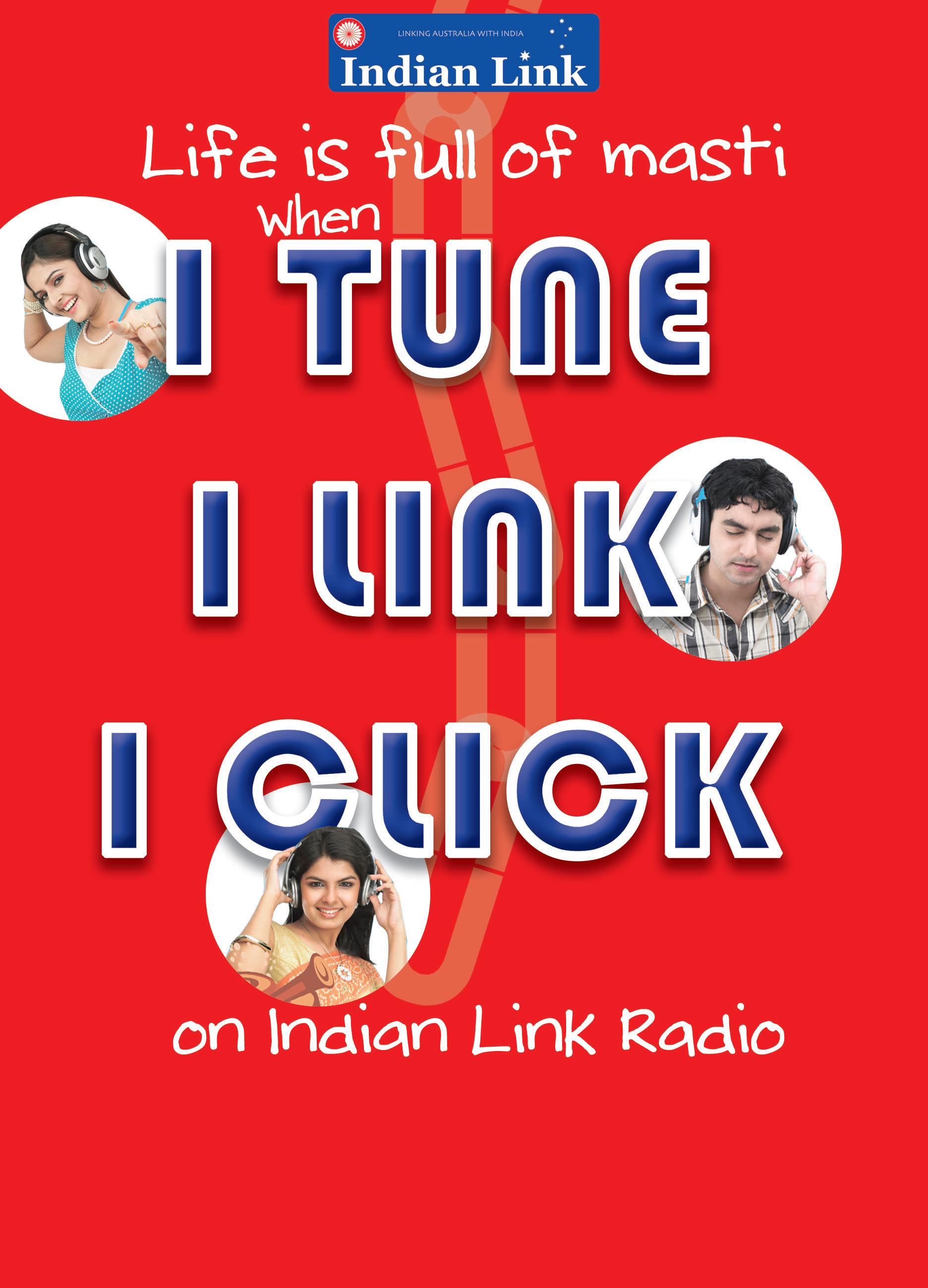
JULY (2) 2011 <> 7 NATIONAL EDITION online www.indianlink.com.au at home / in car Subscribe to Indian Link Radio for $9.95 each month * Conditions apply: Minimum 12 months subscription, $ 50 refundable deposite call us 1800 015 847 Hindi Music 24/7masti Talkback News
First-ever Indian presented Young Victorian award
Despite personal issues, Amit Menghani has strived to help his fellow students and has been justly rewarded for his efforts
BY DEVRAJ BHATTACHARYA
Meet Amit Menghani, a 24-year-old Aerospace Engineering graduate, who like many, came to Australia to study and seek a better life. Amit, who was born in Jaipur in Rajasthan, moved to Australia from Dubai in 2005. He appears to be a humble, downto-earth, hard-working person with a loving partner and a strong, supportive family back home. Despite all this, Amit is fighting quite a few battles of his own, and winning.
On July 1, Victoria Day, Amit was awarded the prestigious “Young Victorian of the Year” award by the Victoria Day Council, making him the first person of Indian origin to win the award in its history. The award is given to recognize those who have made the greatest of contributions towards the interest of the public.
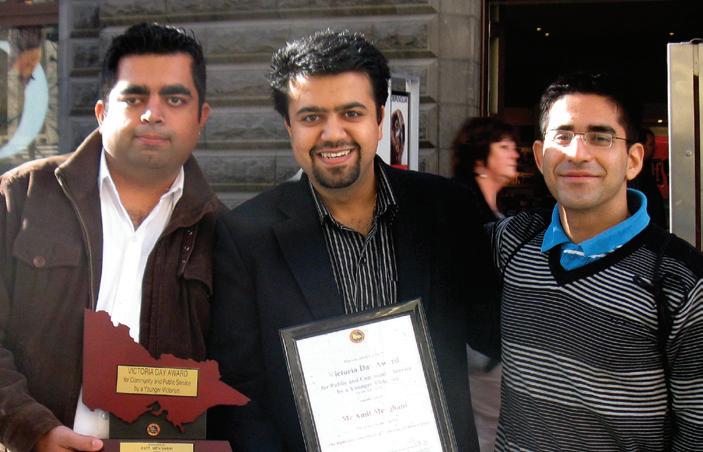
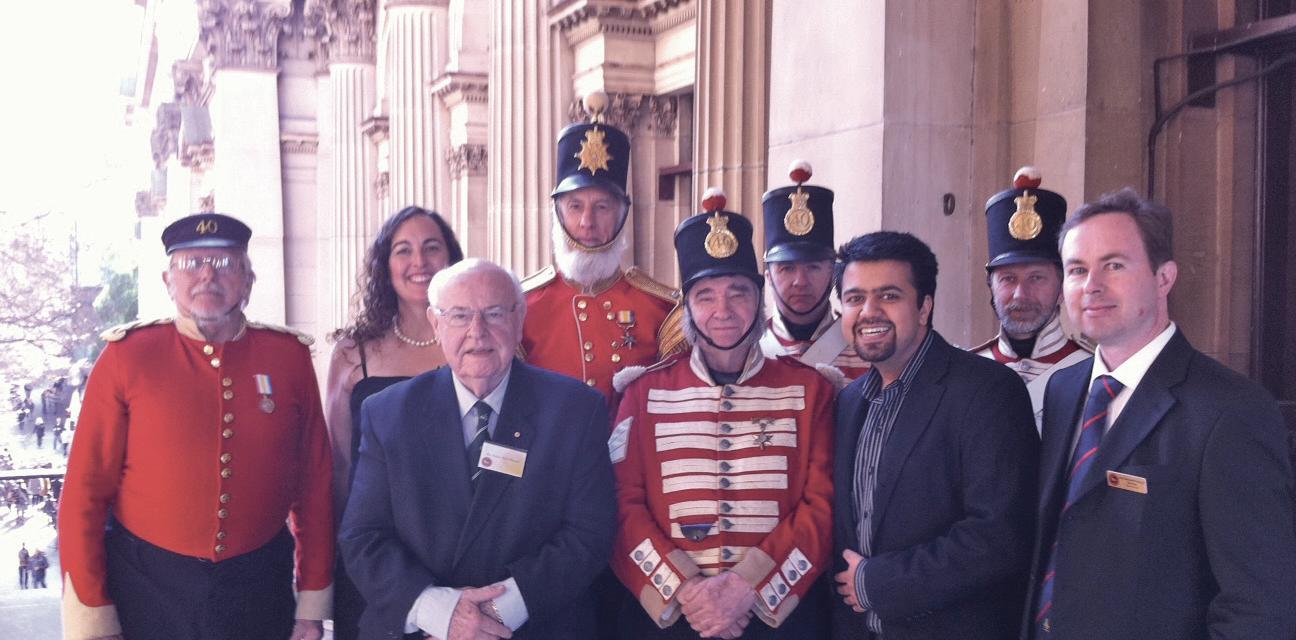

Amit is currently President of the Federation of Indian Students Australia (FISA), an organisation which has an official aim to integrate, represent and empower Indian students living in Australia. The organisation, conceived in 2002 by Gautam Gupta, was initially created to bridge the gap between Indian and Australian cultures, and help migrants coming to Australia to integrate into society.
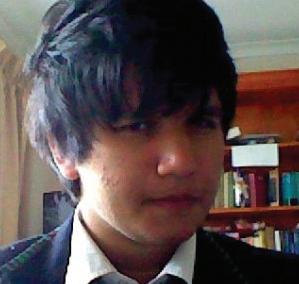
The spate of attacks on Indian students in the last few years has called for more solidarity within the Indian student community, resulting in Amit and his team working hard to channel these devastating events into something that can help current and future Indian migrants.
FISA is perhaps best known for its 2000-strong collective protest on the steps of Parliament House back in 2009, calling for stronger action against violence, particularly against Indians, which then seemed to be on an unchecked increase. Since that time, violence against Indian students does seem to have reduced significantly, but FISA still maintains an active role in assisting to bridge the gap between what seems to be two very different cultures.
Amit describes the group as “striving for equality among all students” and “helping to integrate Indian students” into Australian society and culture.
Speaking to Indian Link, he said, “We have followed many initiatives: we have tried to bring out issues and have tried to spread awareness of what students are facing. We have gone to the levels of integrating a lot of communities throughout Australia and Victoria, by hosting social events such as encouraging Indians to play AFL, and we have gone through senate enquiry to further put our cause across”.
Amongst other services, the group provides education information, guides to local areas, information about community events, and even emergency short-term accommodation assistance to students in dire need of help.
So what would be his recommendations to new migrants? Amit offers wise words of advice: “Students should keep an open mind and learn how different cultures work, take a step forward in building their careers, and socialize with others. Also, the most important
thing for them is to contribute to society”.
FISA has no doubt been a success, and has certainly been thriving, a fact that has made Amit and his family very proud. “When my mother heard of the organisation and its work, she was moved to tears of joy,” he reveals.
In addition to the FISA committee, Amit says that those who have been personally affected by the past violent attacks have been a strong motivation and inspiration to fight for the cause
Despite Amit’s success with promoting FISA, it has not been easygoing for him or his family. Back in India, they took a $100,000 loan to pay for Amit’s education and living expenses in Australia, despite their own financial difficulties, and they continue to pay it off at present.
Said Amit, “My family has sacrificed so much for me, and without them I would not be here. At one stage they took a large loan despite financial difficulties, God bless them. My parents have struggled, and my sister has been supporting my family whilst I cannot be there.”
A grateful Amit expanded on the sacrifices his family, recounting many episodes like how his mother has never eaten lunch outside home to save the extra dollar here or there, as every bit adds in paying off the heavy loan.
“My mother was literally in tears and did not want people to know of the sacrifices she went through, but I think they must be heard,” he states vehemently.
Amit’s journey has been and continues to be a struggle, but he is persevering. Despite his award and success at FISA, he remains incredibly modest and thankful to everyone who has helped him on his own journey and that with FISA.
He is also grateful to his partner, Swathi, whom he met after coming to Melbourne.
“She has been very supporting, helping me with my career and is responsible for what I’ve done today. She is one of the reasons I have been able to move forward,” he says.
Although Amit received recognition for
A grateful Amit expanded on the sacrifices his family, recounting many episodes like how his mother has never eaten lunch outside home to save the extra dollar here or there, as every bit adds in paying off the heavy loan
his involvement within FISA, he is quick to admit that the organisation is definitely not a one-man army. “I would like to thank the entire FISA team: Deven Pravin Tanna,
Raman Vaid, Gautam Gupta, Anu Bhardwaj, Ajay Unni and Hari Yellina for constantly supporting me and guiding me throughout my time as President. I would also like to thank former Consul General of India for Melbourne Ms. Anita Nayar for her constant guidance,” he says gratefully.
In addition to the FISA committee, Amit says that those who have been personally affected by the past violent attacks have been a strong motivation and inspiration to fight for the cause. “It was due to the blessings of all the victims and their families that I was able to continue doing the work of bring communities together. Due to them, FISA was able to promote peace and harmony and make Victoria safer, and Australia too,” he says in conclusion.
The Federation of Indian Students Australia is open to any Indian students living in Australia, planning to move to Australia, or the wider Indian community. For more information please visit http://www.fisa.org.au
8 <> JULY (2) 2011 INDIAN LINK
NEWSMAKERS
www.indianlink.com.au

JULY (2) 2011 <> 9 NATIONAL EDITION
Bold design for a new Parramatta
BY USHA RAMANUJAM ARVIND
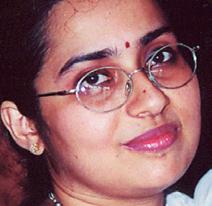
Sydney architect Nilesh Munot won the People’s Choice award at the prestigious Ideas on Edge design competition, which concluded recently. A finalist in the main category, the Gladesville-based urban designer received 3000 of the 5500 votes polled in this segment.
An initiative of the Parramatta Council, Ideas on Edge was established as part of Council’s “broader plan to revitalise the Parramatta River foreshore and build on the second CBD’s reputation as a premier events, shopping, cultural and dining destination”. Commanding panoramic views of Parramatta Park, as well as the north and south banks, the Ideas venue (located between Bernie Banton and Lennox bridges), which comprises 2.2 hectares, is one of the last undeveloped sites on the edge of Parramatta River.
The competition was aimed at stimulating a range of ideas for the commercially viable redevelopment of the iconic riverfront precinct to create a multifunctional space, including a broad spectrum encompassing both private and public domains.
Congratulating Munot, Parramatta Lord Mayor John Chedid stated, “Nilesh’s submission presented a unique vision of creating a vibrant Parramatta riverfront through recreational use, Aboriginal heritage and multicultural facet.” It also includes waterbased recreational activities including canoeing and row boats, he added.
Tough competition
The contest, which offered an overall prize pool of $70,000 for “the boldest, most innovative and creative concepts”, attracted 150 entries from all over the world. More than 40 per cent of submissions were international, including entries from UK, USA, UAE, China, Belgium and Netherlands and its promotional clip got more than 4,000 views on YouTube, a Council spokesperson indicated.
The judging panel chaired by Chris Brown, head of the Economic Development Committee, comprised Professor Janice Reed, Vice-Chancellor and President of the University of Western Sydney; columnist and author, Elizabeth Farrelly; Sydney-based architect and Executive Chairman of Hassell, Professor Ken Maher; and Roman Dechnicz, life member of Parramatta Chamber of Commerce.
The winners were chosen for their innovation, ability to leverage on the site’s waterfront exposure, river activation and viability for a commercial development. The shortlisted entries were exhibited at the Parramatta Riverside Theatre.
A strong sense of achievement
“Such prestigious awards give us (architects, artists, urban designers) a great sense of achievement,” Munot acknowledged.
“As a practising architect, I have to constantly tailor my

design to suit the client’s budget. Creativity thus gets restricted considerably. For me, this competition was a practical exercise without any budget restrictions,” he told Indian Link. Viability, innovation and integration were Munot’s guiding principles.
“As well, this is the first time that an Indian origin urban designer has won a ‘People’s Choice Award’ for an international design competition in Australia. So, I am truly honoured,” he stated with quiet pride. “Indian Australians have made their mark in many fields such as medicine, IT, accounts, but I have not heard of a migrant Indian architect winning an award in Australia so far,” he added.
Ironically, the Ryde Business Forum member chanced upon the competition, barely a fortnight before entries closed.
“Though very excited at the prospect, I was very unsure of participating,” he confessed. Being a former Parramatta resident of nearly a decade gave Munot enough confidence to get the design and drawing ready before the deadline. “I knew I could get it all done within a week,” he recalled “The adrenalin rush was exhilarating, reminding me of those memorable undergrad days and I am very pleased with this positive outcome. I am particularly grateful to my wife Sonali, brother Akshay, and Neha who put my drawing and proposal together,” he added.
The design elements
Taking into account Aboriginal heritage and diverse ethnicity of the precinct as well as its proximity to Parramatta’s landmark Eat
Nilesh’s design was boldly innovative while also being practical and environmentally sustainable, giving weightage for landscape character, particularly riverfront as well as solar aspects of the site
Street, Munot’s design was boldly innovative while also being practical and environmentally sustainable, giving weightage for landscape character, particularly riverfront as well as solar aspects of the site. His suggestion of reintroducing paddle boats was particularly well received by the Council and general public.
“My creative vision aims to incorporate the fundamental urban design principles of activation, permeability and pedestrian connectivity,” he explained.
One of Munot’s primary objectives thus, was to improve pedestrian connectivity through continuous physical and visual links. His winning proposal included semi-permanent and partially covered pavilion spaces for multicultural events, redevelopment of Riverside Theatre to include multi-tiered recreational facilities, two storey high lobbies and foyers, basement parking subject to flood mitigation findings, as well as residential towers that are oriented to maximise solar access, leveraging its north orientation. He has also proposed Aboriginal themed boardwalks and pedestrian



10 <> JULY (2) 2011 INDIAN LINK
www.indianlink.com.au
Sydney architect Nilesh Munot’s vibrant design for Parramatta river foreshore wins him the People’s Choice award at the prestigious Ideas on Edge contest
3D images by Nilesh of the proposed Meditation & Community Centre for a not-for-profit Indian community based organisation called Global Organisation of Divinity
Forecourt of Superdome (Olympic Park, Sydney) - an important project Nilesh worked on as a graduate architect with Cox Group during Sydney Olympics
bridges in line with the river network.
Besides the Council precinct, Munot has worked on number of local community projects and is currently designing a meditation centre for Global Organisation for Divinity (GOD) at Winston Hills.
The man’s motto
As an urban designer and town consultant for Wollongong Council, Munot has helped develop town centre masterplans, large scale subdivisions, new village centres as well as assess some key strategic sites from urban design point of view to provide the best built form outcome.

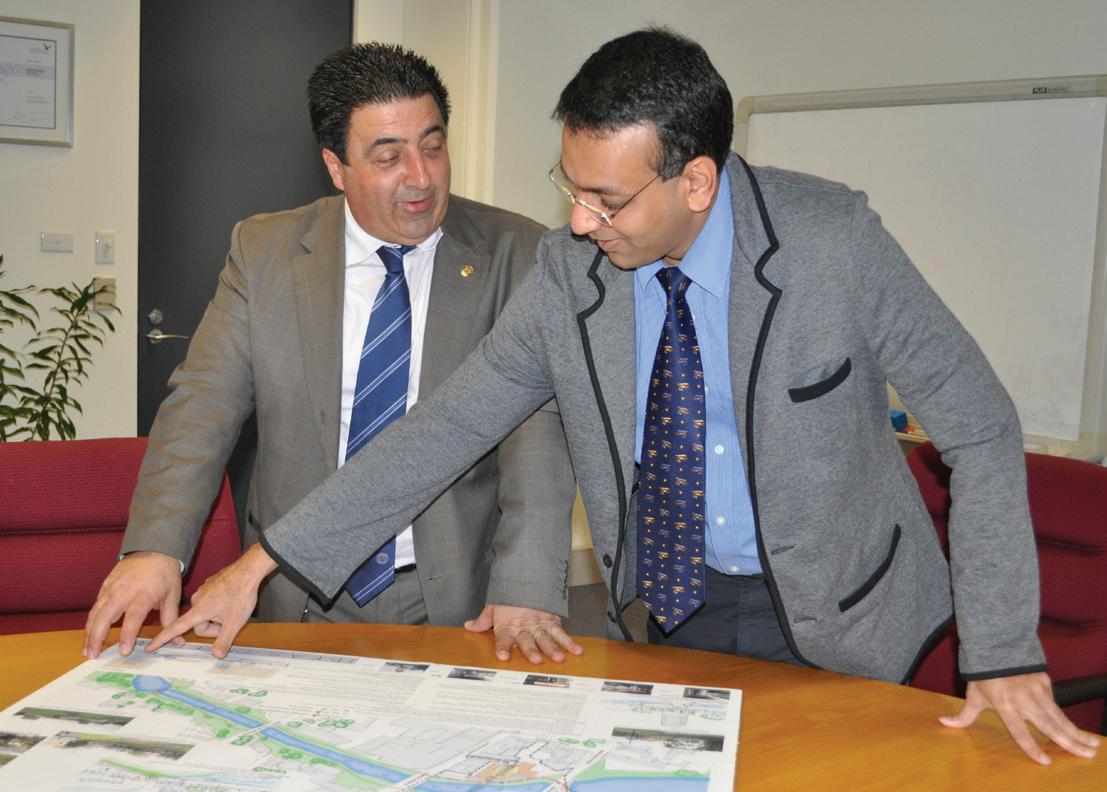
The Mumbai-trained architect came to Sydney in the late 90s to pursue his Masters in Urban Design at Sydney University, and has since called Australia home. As a graduate architect with the Cox Group, he was associated with several prestigious projects, including Super Dome in the lead up to Sydney Olympics. “This project gave me insight into large practices and high profile constructions”, he explained.
After gaining valuable experience with mainstream firms, he founded Shobha Designs with “a strong view to contribute towards the shaping of future development and create safe and enjoyable places for people”.
‘Shobha’ in Sanskrit means ‘brilliance, beauty and elegance’ and that’s what our design team constantly strives for, he explained.
“The principal offering of Shoba Designs, of course, is in the brick and mortar area of extensions and renovations, besides property development in midweight category. I also provide advisory services to those tapping into the gilt edged investment property market,” added Munot.

“Equipped with qualifications
and experience in urban design and architecture, I believe I am well placed to offer the maximum value to any project irrespective of how small or big it is, and whether it is an extension or renovation or new developments,” he claimed.
“Our team can undertake projects ranging from $100,000 to $35.0 million in construction costs. Direct involvement, clear communication and strong leadership accompany Shobha’s sound design principles,” Munot stated.
Winning this prestigious award has been an invigorating experience for Munot, and he is keen that the best is done for the Parramatta riverfront. “I’m hoping that the
future developers of Ideas on Edge site will take on board most of the design concepts from winning entries to come up with a great outcome. Ideally, I would like to see another competition in place for detail design among the 5 winners. The developer should then engage the winner for the project. It will be a shame if the real project goes to someone completely new,” he emphasised.
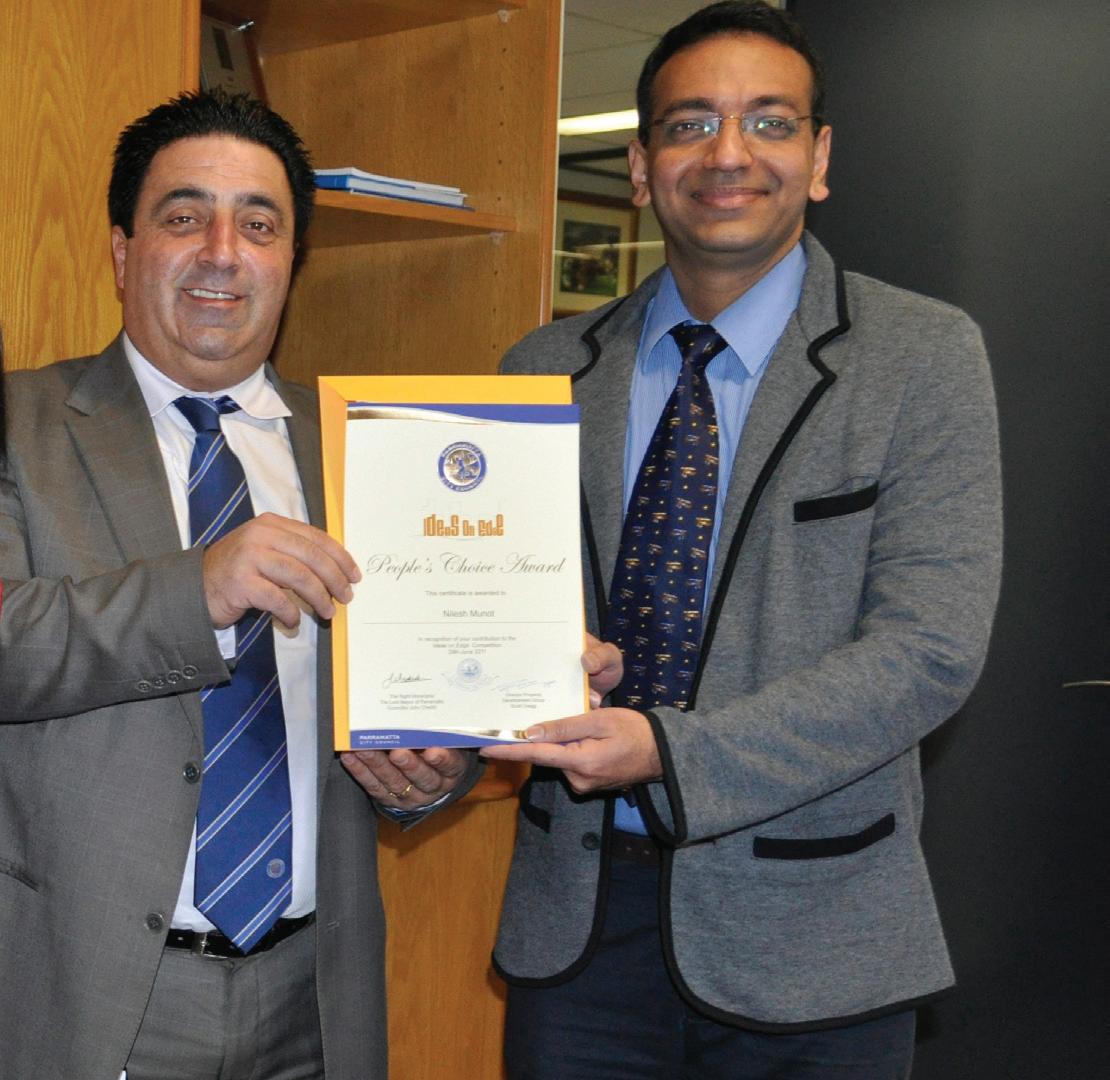
COVERSTORY
“The adrenalin rush was exhilarating, reminding me of those memorable undergrad days and I am very pleased with this positive outcome”
Nilesh Munot
Design of Nilesh’s submission
Neelesh with Mayor John Chedid
Photos: Nilesh Munot
Turnonthe radio!
John’s recommendation of having a broker to sort out your finances.
BY NEELAM VASUDEVAN
Indian Link Radio has been abuzz with activity once again in the past few weeks. For one thing, there’s been plenty of discussion - from India, we’ve thrashed out the Mumbai blasts issue (why Mumbai, again?!), the ongoing corruption scandals, and the public’s growing discontent with the government; from here in Australia, the carbon tax, Julia Gillard’s public appearances, and ok, with just as much gusto, Masterchef and the new Harry Potter movie, and from within the community, the Queen’s birthday honours, and the Indian-origin winner of the Young Victorian of the Year award.
And of course, our band of anchors and I have been keeping you entertained with our choice of music. Hope you’ve heard the new items on our songlist –numbers from Delhi Belly, Bbuddha…, Zindagi Na Milegi Dobara, not to mention songs from the yet-tobe released Singham and Ra.One.
SHRADDHA ARJUN
Subah Subah 7-9am (Mon-Wed)
Starting your mornings with devotion and a smile on her face is the very versatile Shraddha. From faith, rituals, vintage wisdom to newsmakers, current affairs and ‘Half Ticket’ – the energetic Shraddha kickstarts your mornings with a range of topics!
A highlight on Shraddha’s show in recent days has been her extended chat with guest Tim Blight, who spoke about his love for India. He recalled fondly, an experience at the Golden Temple Amritsar and how it moved him. Comparing it to the Taj Mahal, he added that in his opinion, the Golden Temple had a profound effect on him and was much more spiritually satisfying than the Taj Mahal. Tim spoke to Shraddha before taking up his new job, in Chennai!
Back from a recent trip to India, listener Ashaji talked about her visit to Shantiniketan, Kaalighat and Dakshineshwar. Evident on air was her love for all things Kolkata such as Tagore – as well as rasgullas, sandesh and other delicacies!
SAGAR MEHROTRA
SubahSubah7-9am
(Thurs-Fri )
Sagar, whose passion for the radio is just as large as the ocean that is his name, packs in just as much into his morning show. Topics from everyday life capture his imagination: from religion to philosophy, from science to mysticism, the all-rounder Sagar never fails to impress. Meet experts from various fields as they try to solve your problems.
Talking to Sagar, Sydney based Real Estate expert Josh John from Mc Grath Real Estate had some advice for those of our listeners who are out in the market looking at property. Listen to more about tenancy rights on the same show with Josh.
A talk with Pandit Shri Jatin Kumar Bhatt of Shri Mandir, Auburn explained about the necessity and ritual behind having Mundan and Janauu rites for babies. In another discussion, Sagar tackled the issue of how youngsters address their elders in our community. In India it’s always been “Aunty” or “Uncle”, but not here! What do you think?
Coming soon on Sagar’s show, a discussion on IELTS - in spite of having reasonably good English communication skills, many seem to be finding this a hurdle. Stay tuned to learn more.
A mortgage/finance broker will compliment Josh
An event organiser/wedding planner will talk about A-Z packages for oragnising functions like first birthday, graduation party, wedding party, hen’s night, stag party…
SHRADDHA ARJUN
SalaamNamaste10am-12noon
(Wed & Fri)
Wednesday mid mornings Shraddha’s back in a different mood, tracking down the latest on the tech front including tips on new apps for your phones, Bollywood quiz Star Yaar Kalaakaar, and travel to Indian destinations.
With the ability to talk to experts from many a background, Shraddha keeps you updated with your choices as a consumer. Ingrid Just from CHOICE regularly joins Shraddha with her advice. Recently, as part of its campaign for truth and accuracy in food labelling, CHOICE wanted food health claims to be subjected to pre-market assessment by regulators, to ensure the products deliver what they promise. Fridays packs in reading delights with Top 10 books, Restaurant reviews, popular hangouts, clubs and recipes and general masti
RASHMI CHAUDHARY
Mon, Wed and Fri 5-9pm
General masti, sawaal jawaab on life, debate, fashion food, our very own bharti behen…all up for grabs on this masti-based show that listeners have a blast listening to. With her sweet voice and lilting laughter, Rashmi is the much needed voice to help you unwind as you step into your homes after work in the evenings. Join her on debates and try to recognise the voices of the stars on Rashmi’s quiz show….
PRIYANKA TATER
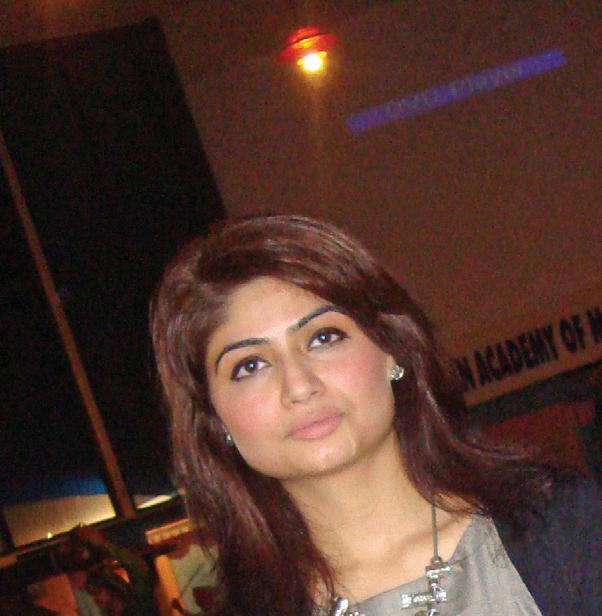
Tue and Thurs 5-9pm
Bringing a world of her own experience from the soundwaves back in India, is Priyanka Tater. A very professional and slick presentation with just the right balance you need from current affairs, travel music, reviews. In a well-researched and slickly presented show, Priyanka tackled the issue of the carbon tax - what does the newly announced tax mean for the average consumer? CEO of the Indian Link Group, Pawan Luthra spoke about the general feeling of anxiety with regard to the carbon tax. “An interesting situation with concern for the environment - the weather is changing, the climate is changing, but there should have been an ability for people to vote for this decision. If you are convinced it is for the betterment of the country, take it to the community, take it to the electorate and then let them decide. And if you are voted back into power…then majority rules”.
Mark Sharma opined, “This Labor Government since 2007 has a solution to all problems with a tax – you can go back to look at every major issue like binge drinking, smoking etc and see it as a cash grab. What are we going to achieve? Great danger of losing jobs and destroying the economy…”.
And yet Ingrid Just of CHOICE explained, “As a result of the Carbon tax, the impact on prices is estimated at $9.90 on average weekly expenditures in 2012-13, comprising $3.30 per week on electricity, $1.50 on gas and $0.80 on food. This is balanced against average household assistance of $10.10 per week”.
Priyanka’s recently produced show on Bollywood’s unforgettable moments Lights, Camera Action!!! turned out to be a huge hit according to listener feedback - hope there’s more of that in your armour, Priyanka!
PRIYANKA RAO
Sat 9am – 12 pm
Saturday morning brings on air the lovely Priyanka as she takes you through the very latest in music and



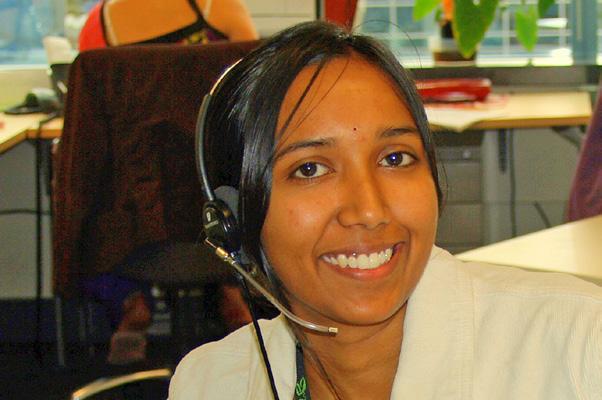


masti on your radio. Focusing on the events gone by in Australia and India Hafta Bhar; the TOP 10 of anything and everything; entertainment news; box office results for new releases, and focus on an artiste also features interview with local talents – all backed by some of the best tracks for easy listening. That’s Priyanka for you! “I see Love Song Dedications as a wonderful opportunity to highlight a common thread that runs through all of humanity. Almost without exception we are all either in love, have lost love, or dream of finding a special someone to share our lives with. It’s one of the beautiful, positive similarities between all people. There is also the aspect of hearing people expressing a little of what they’re going through in love and life and if you’re like me you would hear situations and feelings expressed that relate to your own life. This can be comforting simply from the point of validating your own feelings, particularly if you’re suffering the loss of love. When you’re going through a painful break up, the people around you may expect you to ‘just move on.’ Although they may have the best intentions, this lack of empathy can further add to your misery. Whereas on Love Song Dedications it’s about how you feel rather than what you should do.
Tune into our very own Love Guru Anup who infuses romance into the sound waves with pyaar ki baatein. Picking an emotion every week, Anup moves on to solve your problems too. So why not give him a call? Also keeping you updated on the show is the latest news, views, events and community updates from Fiji and Australia. And if you are fed up of zindagi ki daud aur dhoop, Anup’s Has Tu Hardam brings in some much needed laughter and light moments to keep you going till the next Saturday.
RACHITA SAINI
Sun 9am -12pm
Come Sunday mornings and our own Punjab di kudi Rachita brings in the life and banter needed to get you out of bed. If nothing else, her non-stop100-kms-an-hour chatter will wake you up! For gupshup, sports news, travel tips, DIY stuff, or just for movies to watch on the weekend Rachita’s the girl for you. Make yourself a cup of chai and let her take over your weekend morning….
MANOJ MENON

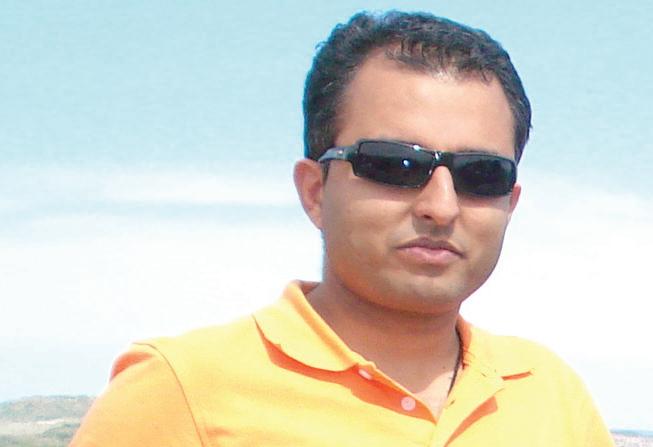
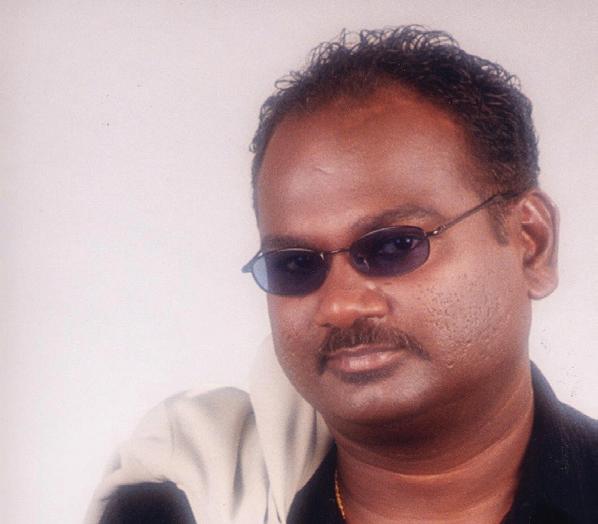
Sun 5-9pm
Popular for his Oh-so-sexy voice on the radio, Manoj charges the mood on Sunday evenings with his Lazy Lamhe. Featuring superhit naghme as well as kaam ki baatein, ghazal ki mehfil aur sher aur shaayari –Sunday evenings are best spent in Manoj’s company.
Talking to him recently was Australia-based singer-songwriter Shriram Iyer (who toured with Shankar Mahadevan who released his album Is Dhundh Mein). Shriram shared his passion for the recently released single Shayarana Si. The charity song aiming to raise $10,000 in 30 days for Japan and Christchurch. Having recently won an award for the Best Background Score at the PTC Punjabi Film Awards 2011 for the film Mitti, Sydney-based composer and arranger Ajay Bisht also joined in to tell us how the song came to be. It was composed in Melbourne by Shriram, arranged in Sydney by Ajay and went down to Mumbai to be mixed and mastered by Brendon Cooper. Having travelled all those miles, the Song is available on iTunes and Amazon. Can a song help a cause? For such a noble cause, we think so. The song is beautiful with some lovely words and great music. It’s how you would want your planet to be. Quipping in on Facebook was listener Ruchika Mangla “Manoj is really gud n a professional anchor... njoy his show... n yes, it was a gud interview!!” Way to go Manoj!!!
Tune in to Indian Link Radio 24/7 worldwide on web - www.indianlink.com.au or subscribe in Sydney and Melbourne for $9.95 per month.
www.indianlink.com.au
MUSIC
Indian Link Radio’s Creative Director gives us a peek into what’s been happening at Australia’s favourite Hindi radio station
SHRADDHA ARJUN
RACHITA SAINI
MANOJ MENON
PRIYANKA RAO
PRIYANKA TATER
ANUP KUMAR
SAGAR MEHROTRA
FREE BUSINESS BRIEFING
Potential to earn +$100,000 p.a. while keeping your present job

Are you like most people who have studied various material on wealth creation, then got “fired-up” each time and pledged to go into business for yourself someday, but NEVER got around to it because you
• did not have the (large amount of) start-up capital that was required?
• Just couldn’t afford to give up your full-time job to do so due to existing commitments?
• Simply could not find the right opportunity (one with minimum outlay and maximum returns)?

If you are a motivated, self-starter who would seriously like to attain financial independence, earning a residual income with the potential to exceed *$100,000 p.a. in 2-4 years, starting part-time with relatively no financial risk, then call
(02) 82302521 (24 hrs)
And we’ll introduce you (without obligation) to one of the most lucrative business ventures of our time. This is a genuine, legal and high-integrity opportunity that is attracting people from all walks of life, including highly skilled professionals such as doctors, lawyers and business executives. It is definitely not for those looking for a ‘get rich quick’ scheme or rewards without effort-such things don’t exist.
Understand that if you don’t have, it’s because you don’t act. Call Now. (Serious enquires only)
CONTACT : DEEPIKA SHARMA
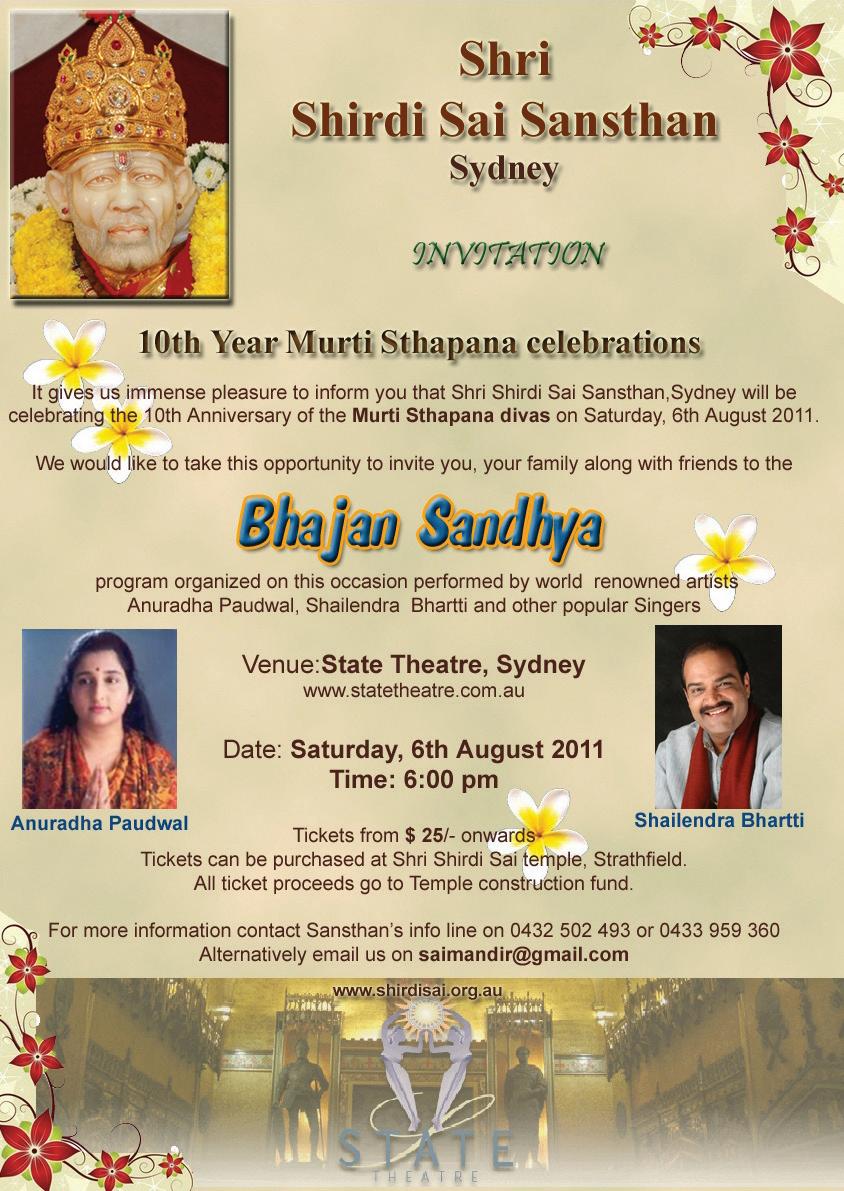
“Now Is The Time To Have Great Health Using Homoeopathic Medicine”
Warning: Don’t make another decision about your health until you have read this Free Report. Go to www.andrewjameshealingcentre.com/report.html
Homoeopathic medicine for strong, vital health and healing

Medical Homoeopath & Naturopath, Andrew Collishaw (ND, B Med Sci) has over 22 years experience & runs a busy practise in Newtown. He has helped 1000’s of clients achieve great health using classical homoeopathic medicine. Enjoy the health-benefits that homoeopathy brings. Be sure to read our free report
Andrew James Healing Centre 211 King St Newtown 2042
JULY (2) 2011 <> 13 NATIONAL EDITION
‘Uranium issue should not hold the relationship hostage’
The uranium issue holds centrestage as the Australian High Commissioner to India Peter Varghese discusses this and other key topics in a candid interview
BY PAWAN LUTHRA
The current view in India is that Australia is the place where Indian students get beaten up and that because it doesn’t trust India, it will not sell the country uranium for its nuclear energy needs. The man representing Australia at the very highest level in India is His Excellency Mr Peter Varghese, the High Commissioner of Australia to India, who has now been at his posting for two years. Mr Varghese succeeded Mr John McCarthy, Australian High Commissioner to India from 2004 and 2009. In April 2011, addressing a conference at the University of Sydney, Mr McCarthy confided that as he has now retired, he can be more candid with his views. “Not selling uranium to India is a mistake in principle by Australia, and especially after the United States’ nuclear deal with India, it does not make sense. Hopefully we get past it,” he stated.
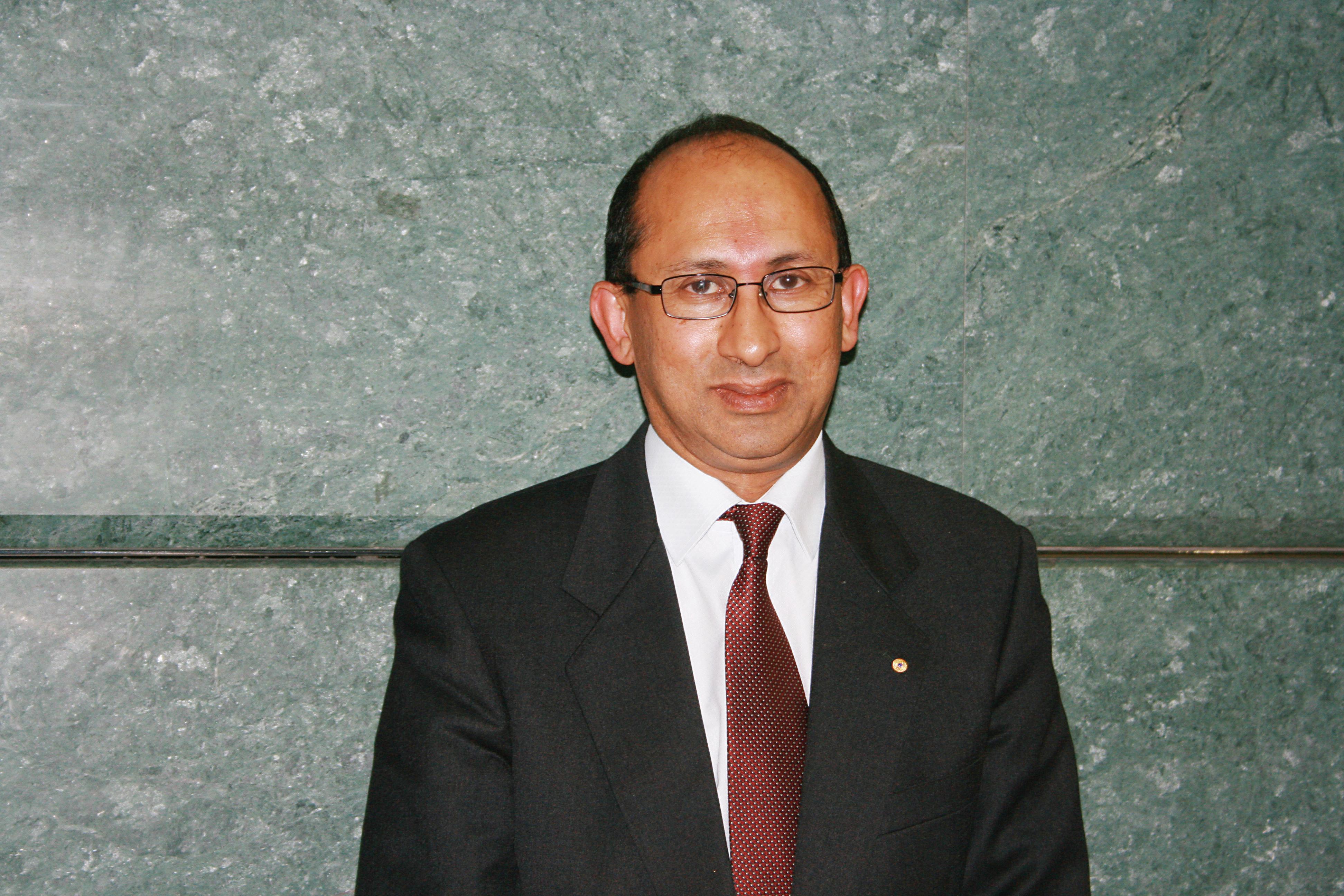
Mr Varghese who was in Australia recently, shard his views on the uranium sales issue and other topics, at the studios of Indian Link Radio, while firmly holding on to his diplomatic hat!
Pawan Luthra: Before taking up your role, you stated in an interview with Indian Link, that one of your priority tasks would be to reinforce the bilateral equations that had been shaken by the students’ issue. How have relations between the two countries changed under your watch?
Peter Varghese: It is always risky to be held accountable for something you have said in the past. The last two years have been both very productive for Australia-India relationships but also quite difficult at times, particularly in the first year due to the students’ issue in the Indian media. Since then, we have seen a calming of the waters due to steps implemented in Australia both at the Federal and State levels, which indicated that the government was taking this issue seriously. This assured the students both here and in India that their safety and well-being is important to Australia. Beyond that, the relationship has grown strongly, the converge of interest is at an all-time high with increasing economic and trade relationships, political dialogue, peopleto-people communication, etc. I am very comfortable with the way things are progressing, and am looking forward to strengthening it in the future.
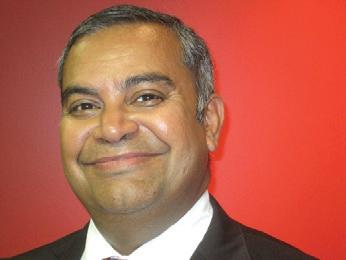
PL: But student numbers have decreased. Did governments on both sides handle the situation correctly?
PV: Yes, the numbers have gone down by about 30% on a year-to-year basis, but I do not measure the success of the relationship by just looking at quota on student numbers. The Australian government has made significant policy
changes on a global basis in both international students and labour market migration requirements. This has had a significant effect on numbers. The question to focus on now is whether we have put in place the right policy framework – in the interests of both countries. I believe we do, and this is going to have a greater emphasis on the higher education university sector in Australia and perhaps, delivery of more vocational training in India. This makes a lot of sense, as it helps bridge the education deficit whichIndia is seeking to cover.
I think it will provide a longer term sustainable basis for education relationships and that’s more important than the numbers.
The other issue to note is that it is important to separate the education objectives from migration objectives.
I am not suggesting we hermitically seal the two, but I think that if you come to Australia to study, that should be your primary objective. That is not to say that we will not welcome migrants from India, which is our second largest source of skilled migrants. The changes we have made to migration policy settings will see a very large contribution from India to our overall migration intake. I think we will meet both our education and migration objectives, but be a bit clearer on how we are pursuing it.
“I do not think that either side views this relationship from the prism of a single issue (uranium), nor do they hold the whole relationship hostage to one issue”
shapes opinion; in fact, I am actually very attuned to it and that does complicate the job which we have, to present a rounded and balanced image of Australia in India. We need to deal with the cards we are dealt and navigate our way through a complicated media environment in India. One big objective I have (you will hold me accountable to it in a year’s time) is to try and improve and sharpen the message we are getting out to the Indian public as to what Australia is all about. The students’ issue highlighted the fact that the general perception about Australia in India is very thin and outdated, and you can probably say the same about the general impression ofIndia in Australia. So, one of my tasks is to project a more rounded and contemporary image to India of Australia, including on the important issue of race and multiculturalism.
PL: What’s holding Australia back in selling uranium to India, particularly as the US is willing to overlook the Nuclear Proliferation Treaty (NPT) hurdle regarding technology transfer? Australia has just announced its carbon tax and has been exhorting the dangers of global warming. So why the refusal to sell uranium to India to promote clean energy, which will significantly reduce India’s carbon emissions?
PL: The press in India was deemed largely responsible for pushing the students’ situation to crisis levels, but with regards to the Commonwealth Games, wasn’t the media here doing the same thing to India?
PV: I have learnt not to complain about the media; it does not get you anywhere. The reality is that media in both countries is very robust, because it is not under the control of the government. Australia has very high quality media and tabloid media, and so does India. There are more 24/7 channels inIndia than in Australia, and the scale and saturation is different in both countries. There will always be times when small issues are made into bigger issues, where the media wants to see confrontation, or there may be a difference of view, or an interest in building everything up to a dramatic crescendo. That is just life these days, and we deal with it the best we can.
PL: But is there now, a more aggressive attitude in the media in both countries?
PV: Both countries have too much media chasing too few stories. It creates a competitive dynamic which can often lead to more sensational coverage than what you would like. I am not dismissive of the way in which media coverage
PV: This is an issue with a lot of history behind it, and it’s important to understand the basis of Australia’s policy. We have made it clear from the beginning that the Australian government’s position on uranium is not an anti-India position, as much as it is a pro-NPT position. It has been a long standing policy within the Labor party (and also for a long time was a bipartisan policy) that Australia will only sell uranium to non-nuclear weapon states who were party to the NPT. Now India is in a distinctive position at the moment because it is not a party to the NPT, but the Nuclear Suppliers Group has lifted the moratorium on trade with India. We were in support of this, but we made it very clear at the time that it was without prejudice to the long-standing national policy to not be an exporter of uranium to a non-signatory of the NPT, and that continues to be the government’s position. This is obviously an unresolved issue between Australia and India. India has made it clear that they would like us to reconsider our position and in putting that view to us, they have made the point that nuclear power will also contribute to a cleaner energy mix for the country in the future. We will continue to discuss this issue and at the very least, both countries understand the basis for the other’s point of view on this subject.
14 <> JULY (2) 2011 INDIAN LINK SPECIALREPORT
“Both countries have too much media chasing too few stories. It creates a competitive dynamic which can often lead to more sensational coverage than what you would like”
PL: Greg Sheridan, the Foreign Editor of The Australian wrote just last month, “New Delhi is too proud to make a public fuss about Australia’s uranium policy, and the hypocrisy of our selling uranium to China while we refuse to do so for India. But the Australian position is a huge road block to a real strategic partnership.”
Till Australia reviews its position on uranium sales to India, will it be a challenge for any Australian diplomat to take Australia to the front rank of bliletral partnership with India?
PV: We remain very committed to the objective of taking India to its front ranges of relationships; we have a good reason to do that when we look at the future and the role India is playing and will play, and the influence it will have on issues that matter to Australia. I do not think that either side views this relationship from the prism of a single issue, nor do they hold the whole relationship hostage to one issue. Each of us is in the business of building this relationship, expanding it and securing a strategic partnership, but along the way there will be points of disagreement between our two countries. Policy positions may want us to see a change on the other side, but I do not think that it is a crash-and-burn issue in the bilateral relationship. You only have to look at things being done now to see that the relationship is growing.

PL: Yet, this issue is a major stumbling block. If the rest of the world can trust India, why can’t Australia do the same? Are we really seeing each other’s points of view on this?
PV: I must make one point here: this is not an issue of trust, there is no talk of trust on the part of Australia to India –this is all about a long standing Australian position on NPT, which after all, we have considered as the centrepiece on international NP regime. I will respectfully disagree with the assumption in your question that our policy is driven by a lack of trust. It is driven by a perception of the need to shore up the NPT and as with all issues where we have a difference of views with another government, we will try our best to work our way through them and explain clearly where we are coming from. I expect this will be a part of our dialogue with India.
PL: Do you expect this issue to be resolved soon?
PV: I do not know and I can’t and will not put a timeframe on it; that depends on discussions which may or may to be taken which are above my pay grade.
PL: What drives your particular passion in pushing academic relations, such as between universities, scientific research, etc?
PV: To me, this is an important part of building a broadbased relationship. We talk about wanting a strategic partnership with India and this should be a broad-based one. I think education and academic linkages can play an important role as can connections between institutions, in bringing the two countries together. It is not just what governments or businesses can do together, but also what communities can do together. The stronger the community ties, the stronger the overall relationship.
PL: What have you learnt about India in the last 2 years that you did not know before?
PV: India is a country where you are constantly, constantly learning. I tell my colleagues in Canberra that India punishes impatience and sometimes rewards patience. I guess I am learning to be very patient.
PL: On a personal note, has India taken you back to your own roots? I believe your family hails from Kerala?
PV: Yes, my parents were both born and brought up in India, but they left for Kenya soon after they were married, and then migrated to Australia. I have been to Kerala a few times and connected with my relatives whom I have not seen for a long time. I enjoyed meeting them. I am very impressed by the beauty of Kerala especially the backwaters which my family and I have visited.
PL: With the Indian cricket team coming over in five months’ time, what do you think - Australia or India?
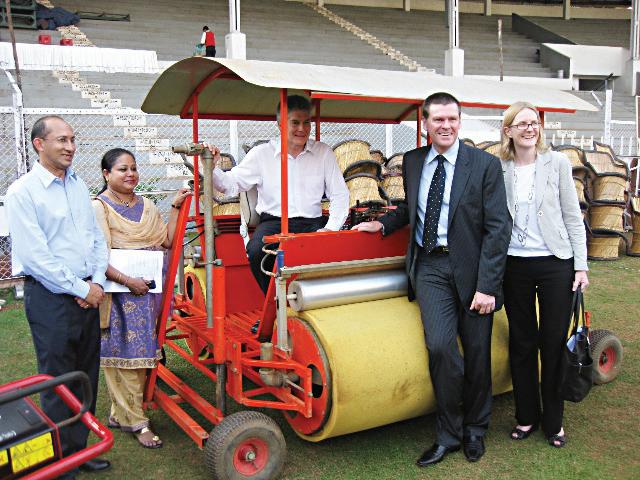
The full interview with His
Excellency Peter Varghese will be broadcast on Indian Link Radio on Wednesday, 27th July at 9 pm and repeated on Sunday 31st August at 12 noon.
JULY (2) 2011 <> 15 NATIONAL EDITION
PV: If I look at it objectively, India is a little bit ahead of Australia. I am hoping that the series might reverse that hierarchy. But the Indian team is playing well, they have the wind of the World Cup behind them and their level of confidence is obvious. I expect it to be a hard-fought series. Cricket is one of the things which can unite and divide India and Australia, and I am keeping my fingers crossed that the balance will be uniting rather than dividing. Tune in to Indian Link Radio on www.indianlink.com.au
Peter Varghese with Minister for Foreign Affairs Stephen Smith in New Delhi in 2009, making a demonstration of the Australian invention “Super Sopper” which soaks up rain water from sports grounds
Peter Varghese, Australia’s High Commissioner to India
Invest in tomorrow
By AMP Financial Planner Nalini Sankar*
For anyone thinking about what they want from tomorrow, whether it’s looking for an effective way to build long-term wealth or simply taking control of their financial future, investing could be worth considering.
While people adopt savings plans for short-term needs like buying a car or taking a holiday, investing is typically a longer term proposition, often used to accumulate assets and build security for the future lifestyle they want.
Understand the risks
For people considering investment as part of their overall financial plan, one of the first things they may need to consider is their risk profile. Assessing a person’s risk means taking into account things such as their age, the timeframe in which they are looking to invest, and how much of a risk they are willing to take with their money.
All investments involve some degree of risk. It’s important for people to strike a balance between the level of risk they’re prepared to accept and the return they’re aiming for.
What type of investor am I?
There are generally three types of investors –conservative, moderate or aggressive. Conservative investors are less likely to take
risks with their money. Their main priority is to keep their money safe, even if that means lower returns.
At the other end of the scale, the aggressive investor will be more prepared to invest in assets that have greater risk. The higher the risk, the higher the potential return. Moderate investors fall somewhere in the middle.
One way for people to combat risk is to diversify - in other words, not having all their investment eggs in the one basket.
There are four main asset classes for investing: shares, property, fixed interest and cash.
Shares
When a person buys shares, they’re buying part of a company. Shares increase or decrease in value depending on the company and the market, therefore there’s a risk that the value of the investment could fall. While generally considered higher risk than other asset classes, historically shares are the top performers over
Nalini Sankar AMP Financial Planner

Associate of Financial Planning
Association of Australia Limited
Principal WealthSmart Financial Services

Accredited Mortgage Consultant
the long term.
People could also consider diversifying their share portfolio into other strengthening offshore markets such as Asia.
Positive economic recovery in Asian markets can have the potential to offer relatively strong growth on investment, and there are products available that can allow the easy management of Asian investments from Australia.
Property
People can invest by buying property, or they can buy into “property trusts”. If purchasing an investment property, people should remember that the property needs to be sold or additional money borrowed in order to access cash.
Comparatively, property trusts are more liquid and offer diversification across a range of sectors including commercial, industrial, residential and retail. Property has historically provided the potential for higher returns than cash or fixed interest, but there is always the risk of a slump in the property market.
Fixed interest
Fixed interest investments provide a stable, regular income. This type of investing usually involves lending money to institutions such as governments and corporations for property mortgages. In return the investor receives a “bond”, like an IOU, which is an undertaking to pay the investor a set interest rate and to repay the debt at a set time.
Cash
When investing in cash, investors are actually “parking” their money with a financial institution that in turn pays interest on the amount deposited. Investors get a consistent rate of return. Investing in cash is accepted as a low risk, low return form of investment, often used over short time frames.
Before making any investment choices, people should consider potential rates of return of each asset class, and be aware of the level of risk involved.
Phone 0404 022 057 email nalini.sankar@ampfp.com.au
Web: www.wealthsmart.amp.com.au
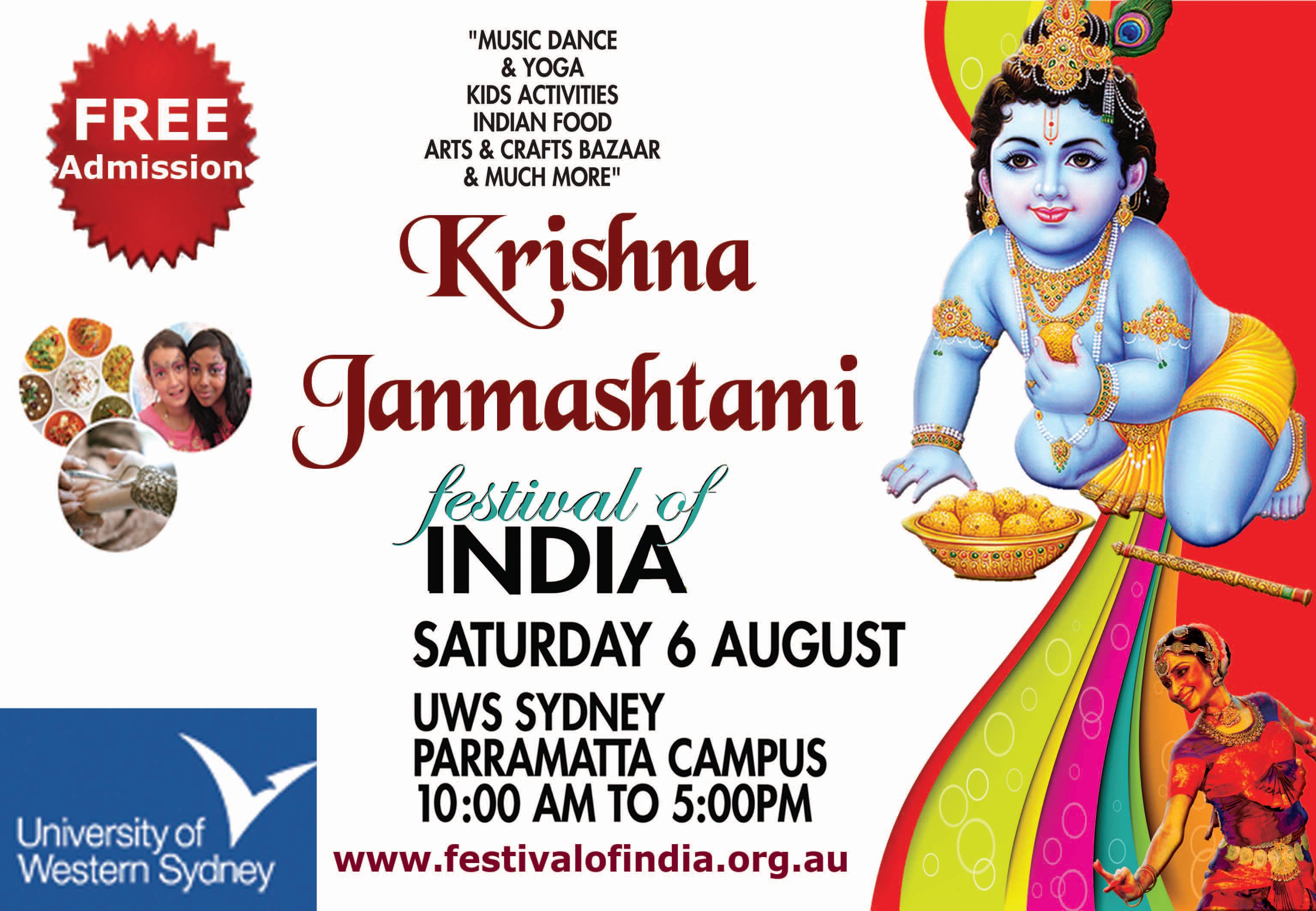
16 <> JULY (2) 2011 INDIAN LINK
Sankar is an Authorised Representative of AMP Financial Planning Pty Ltd, ABN 89 051 208 327, AFS Licence No. 232706.
advice given is general only and has not taken into account your objectives, financial situation or needs. Because of this, before acting on any advice, you should consult a financial planner to consider how appropriate the advice is to your objectives, financial situation and needs.
*Nalini
Any
A qualified financial planner can work with people to plan for their tomorrow. They can help people understand the risks and potential benefits of investing as part of an overall financial plan, and help them put effective strategies in place to fund the lifestyle they want now, and in retirement.
India trip for Premier

A week shy of his 100th day in office, NSW Premier Barry O’Farrell met with the Indian community at a specially organised morning event at Parliament House. Looking much more relaxed and comfortable than during those electioneering times when he made regular contact with the community, Mr O’Farrell was in his element as he delivered a light-hearted speech welcoming Sydney’s Indian-Australians and thanking them for their industriousness.
Amidst applause, he also announced plans for his maiden visit to India late this year.
Mr O’Farrell also put in a special word for “India’s hard-working Consul General Amit Dasgupta”, and said the community should be proud of him. Mr Dasgupta took office just before the students’ situation took on crisis levels, and gained the trust and respect of government officials here.
Mr.O’Farrell also complimented the Indian community in Australia on the hard work which they do and the high standing they have within the Australian community.
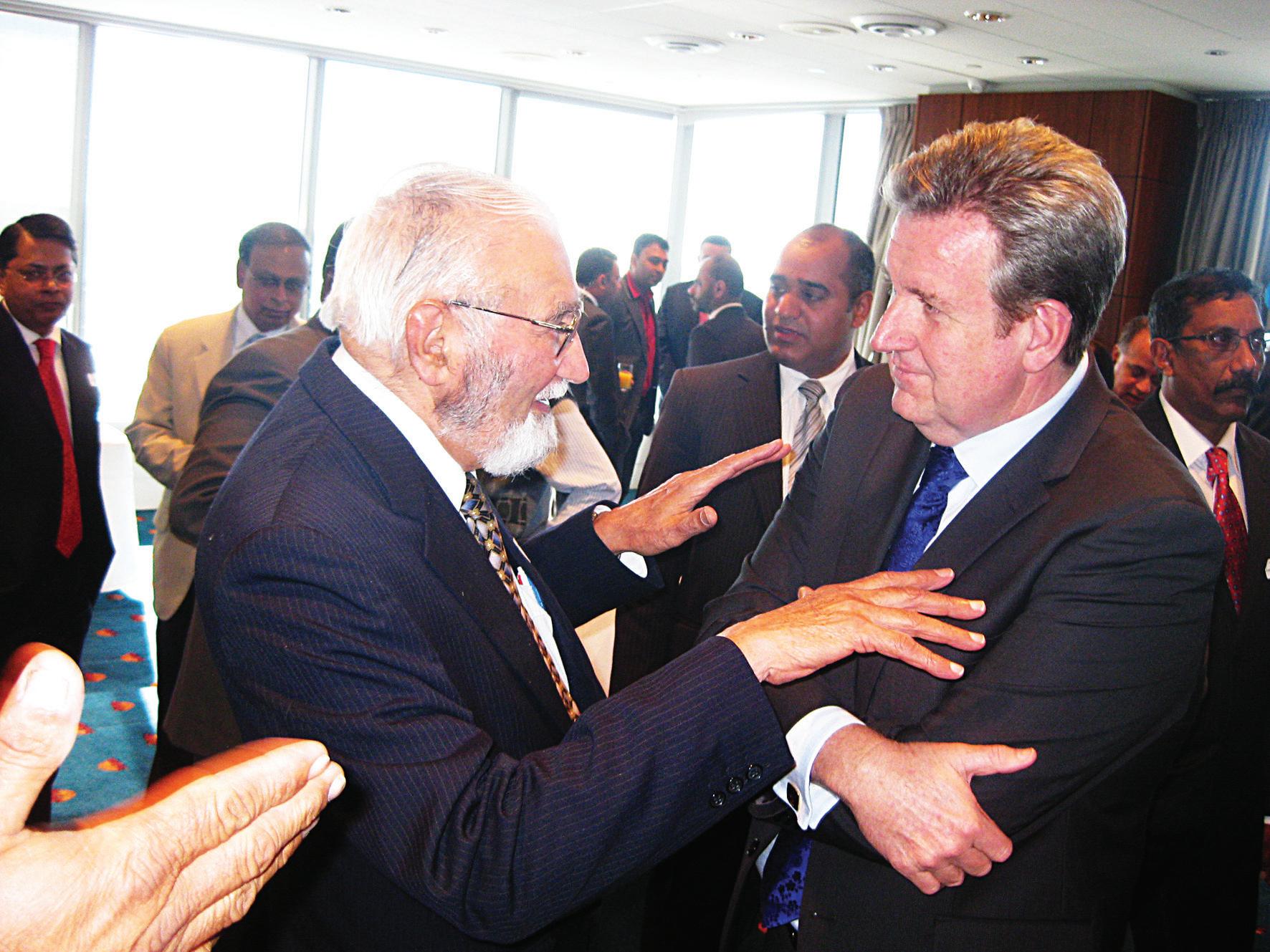
Victor Dominello, Member for Ryde and the Minister for Citizenship, Communities and Aboriginal Affairs was kept busy with many community members keen to speak to him about their particular problems and projects. He listened patiently. Mr Dominello had campaigned strongly within the community during election times and had successfully built inroads by visiting a number of them in their homes. He expressed an interest in the various
activities undertaken by the community. So much so, many times during his speech the Premier referred to Mr. Dominello as the first point of contact for the community.
Meanwhile first-time MP Matt Kean of Hornsby turned out to be quite popular with the camera-crazy. With many supporters in the Indian community, Kean looks set to become a permanent fixture at major community events. While his youthful good looks and bright personality certainly help, Matt seems keen to connect with the community who form a substantial portion of his constituency. He revealed to Indian Link that he is looking forward to his maiden visit to India himself in October.
“I’m going to New Delhi to participate in this year’s Asian Forum on Global Governance, held by the Observer Research Foundation and led by Shashi Tharoor,” he said. “46 lawmakers from around the world have been invited, and I am the lone Australian there. The conference is aimed at looking at different ways in which the world can connect with India. I can’t wait to bring back that knowledge and use it as part of my activities in this government”.
The engagement with India and Indians by the NSW government now seems to be gathering pace.
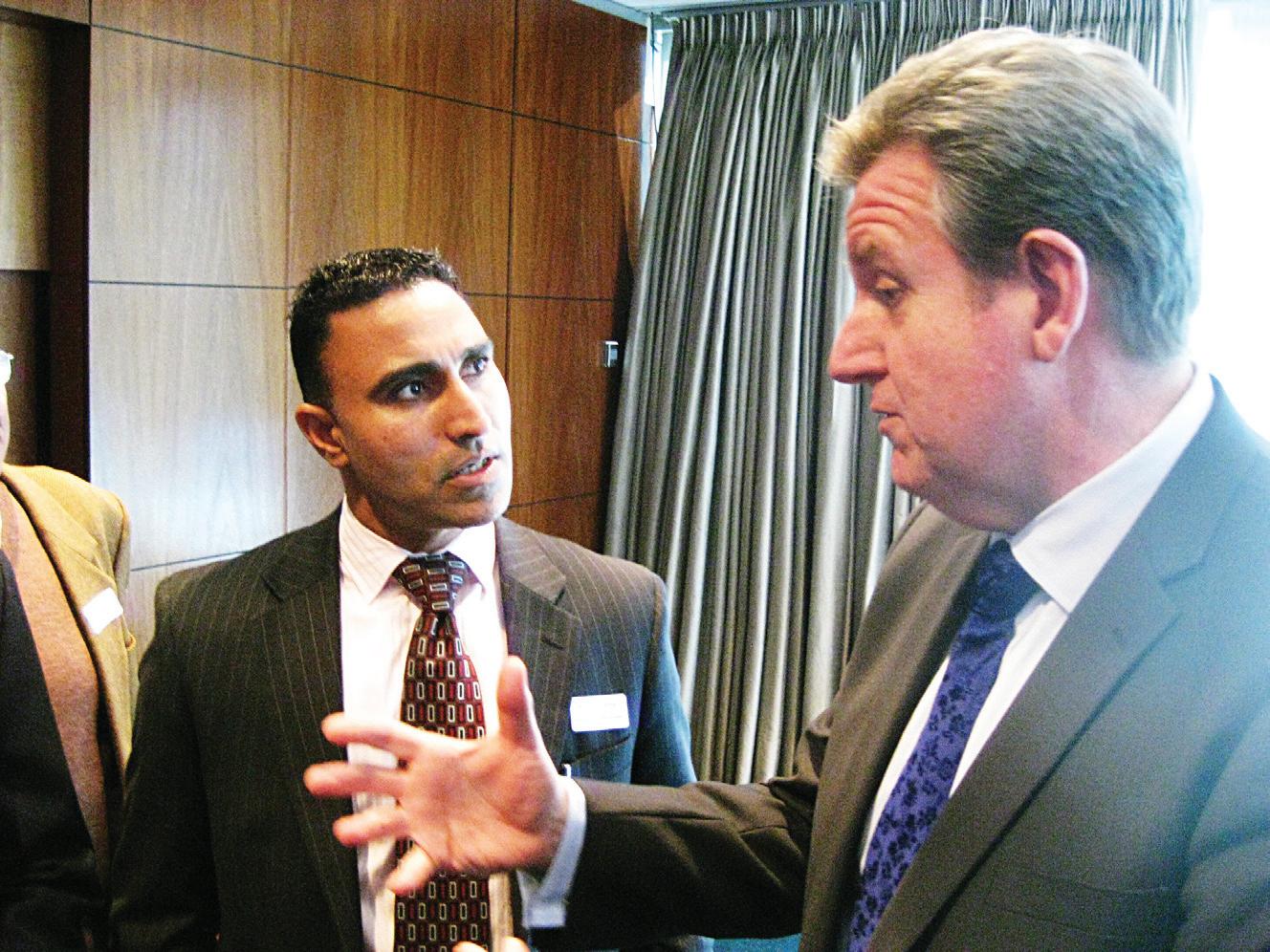

JULY (2) 2011 <> 17 NATIONAL EDITION
www.indianlink.com.au INDO-OZ
Rajni Anand Luthra
Premier O’Farrel chats with Dr. Gursharan Sidhu (above) and Gurtej Thind (below)
Your chance to have a business in India


Experienced, Successful Network Marketers who are looking for a Ground Floor Opportunity with a large, debt free, International Company soon to launch into the Sub Continent. This Company is present in 19 countries. Only one product, no warehousing, health beverage. We are looking for 3 leaders.
Must be Ambitious, Hard working, Honest and Teachable.
Give me a call. I am 79 years old
I am only looking for people who are genuinly seeking 'their Big Chance' in life and are prepared to work hard to get it.
Free sample of product given to all who attend the interview
18 <> JULY (2) 2011 INDIAN LINK 3D&2D Courses 3DS Max, Revit Architecture, AutoCAD, Rhino, Microstation, Photoshop CS courses available. Certificate and Reference provided, Job recommended. >>>>>>>> 0416 930 878
Call Helen on 0414461673
Singh Food and Spices

Quantity Quality Service
We beat the best with no less — TAI offers best Airfares and Packages to suite all budgets.
We Specialise in: Competitive airfares to India, Indian Sub-continent, Fiji, Middle East, Asia, Europe, South America, North America & Africa. TAI— offers Special Round the World Fares and packages to suite both individual and group travel. TAI is focused on Tailor made and prepackaged tours. Are you looking for air tickets from India our partnered offices within India can organize any travel or tours within India and prepaid tickets. Travel Air International now offers language support,
Languages: English, Hindi, Tamil, Punjabi, Arabic

Office
Phone: +61 2 9631-0206
Fax: +61 2 9635-3829
Email: sales@travelairinternational.com
Address: Shop 6 / 3, Aldgate St
Prospect Shopping Village
Cnr of Blacktown Road and Aldgate St Prospect NSW 2148
TOURS TO
Phone: +61 2 9734-9333
Fax: +61 2 9734-9322
Email: sales.liv@travelairinternational.com
Address: 50 Railway Street, Liverpool NSW 2170

JULY (2) 2011 <> 19 NATIONAL EDITION
Travel Air International—Branch Liverpool Office
Think Travel
www.travelairinternational.com
INDIA
you are visiting family or friends why not getaway and do a private tour. half day tours starting from
Per Person
Day Tours starting from $90 Per Person
us today take a pick from our range of city tours. Call 9633-2045 and find out today
while
$35
Full
Call
A spice shop with a difference 143 Stephen Street (cnr Sackville Street), Blacktown Phone 02 9676 4677 Fax: 9676 4688 enquiry@singhfoodspices.com.au : www.indianspices.com.au Blacktown

20 <> JULY (2) 2011 INDIAN LINK
Mumbai at the crossroads

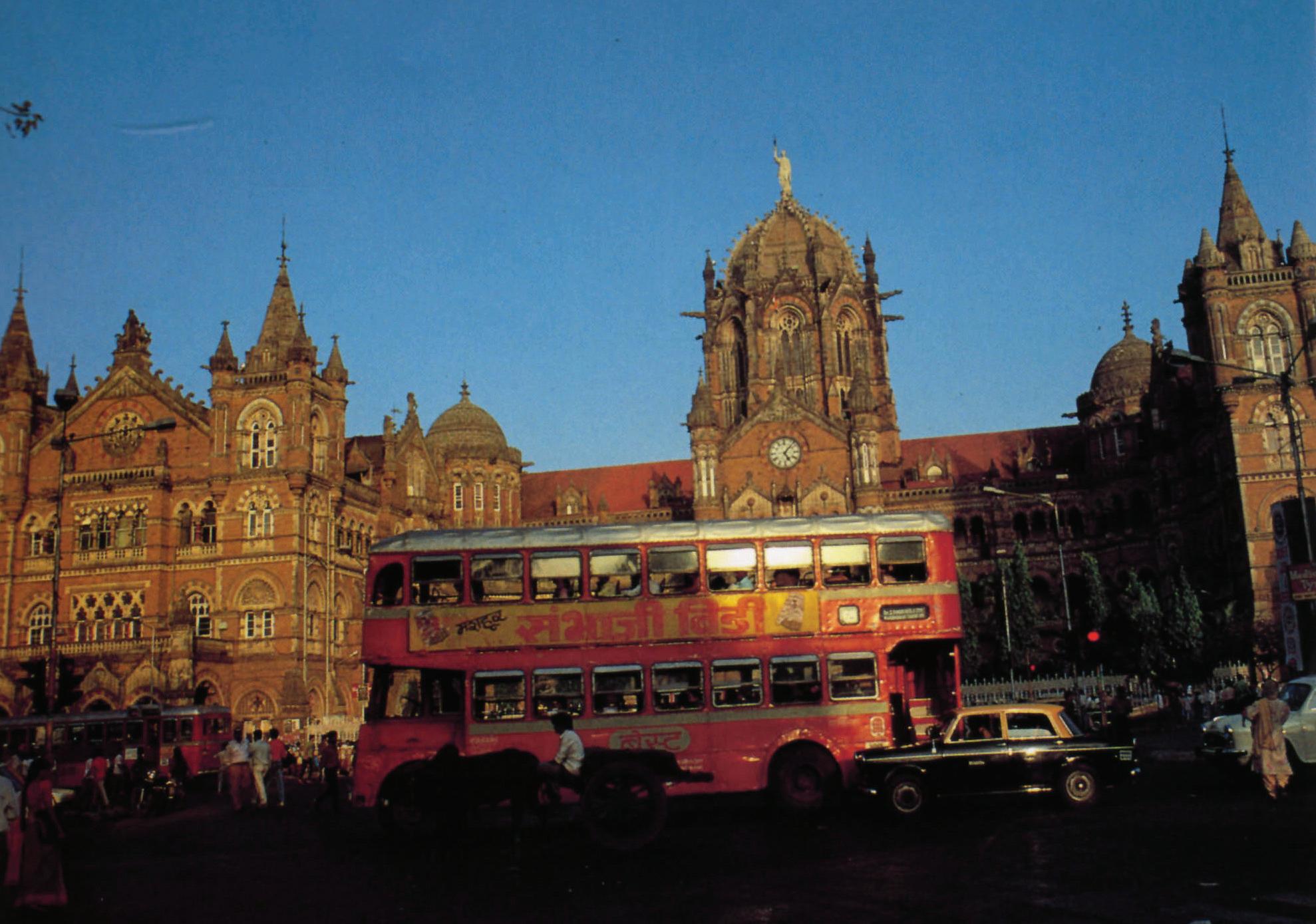 BY SHERYL DIXIT
BY SHERYL DIXIT
“Bomb blasts in Mumbai” shout the headlines, and I feel a brief, overwhelming sense of raw fear. My thoughts instantly fly to the family and friends back home, specially since we live very close to Dadar, where one of the bombs went off. I have to curb my anxiety, telling myself that if any of them were affected, I would have known by now. And then an instant search on the net for details fuels a kind of bizarre relief that the count of dead hasn’t crept past the 50 mark, and that the injured are below 200. Fortunately the toll hasn’t increased, as we are assured by the media a few days later. In this teeming city, detonated to go off at peak time, it is almost a miracle that
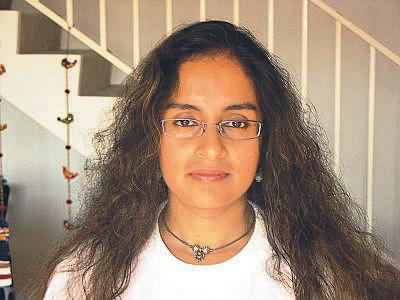
For all its national cosmopolitanism, Mumbai still simmers beneath the surface with suspicion, hatred and the need to cause pain for past slights
the explosions haven’t caused the carnage one would expect as we have seen in the past.
Tinged with my dubious relief was a strong sense of anger and disappointment that Mumbai has taken the rap again. News reports state that the bombs were only strong enough to cause panic and mayhem, and they certainly seem to have served their purpose. And of course, as usual, Mumbai woke up the next day and a majority of its denizens went right back to their routines, albeit with a sense of the suspicious. Local tabloids took pride in lauding the city’s ‘resilience’, Bollywood’s citizenry inundated Facebook and Twitter with their comments and support, and I guess the one thing that truly tugged the heartstrings was an outpouring of sympathy and aid to the injured and the families of the dead.
My family back home reacted in much the same way. My sister claims that after the initial shock and surprise, people rushed home that evening and preferred to stay indoors while keeping updated with the news and perhaps in fear that there may be more blasts. But the next day, things were back to normal. Children were sent to school, their parents followed their travel routine to get to work and although there was an air of nervousness, life went on, almost as usual.
Almost, but not quite. Because once the dust settled down, leading questions were being asked. With the Government’s
Or simply some warped psychotic trying to create chaos and panic, and enjoying its brief success?
Certainly, such an incident would cause widespread panic, but something much worse inevitably rears its ugly head. Mumbai has its share of strong communal feeling, and it takes only a few moments to insist on a call for vengeance. An eye for an eye, a tooth for a tooth, and lay the blame, without thought or reason, to the people who are most likely to be responsible, simply because they share the same religion as the world’s major terrorists. When I was last in Mumbai, I bumped into an
hint that retaliation was unnecessary until the true culprits are identified.
Everyone has something to say on the blasts that shook Mumbai. There are the ones who had ‘narrow escapes’ as they were almost three kilometres away from the spots in which the bombs exploded. Others had ‘divine premonitions’ to avoid those spots at the time. Yet others captured the horrific moments on their phone cameras, hoping to make a quick buck from the ever-ravenous media. Sometimes our sense of what’s right gets lost in the magic of the moment. Right now, the media is full of speculation, the government is full of reassurances, but one can sense a feeling of rising anger at the incompetency that has made this city a target of attack yet again. When will it end, seems to be the question that everyone’s asking. And how long
sophisticated defense equipment and its numerous intelligence agents who, it’s been reported, have permeated the very core of India’s underbelly, how could these attacks still happen without prior knowledge, without an inkling of their cause and effect coming to the notice of the powers that be? Could it be that the coils of corruption have finally strangled whatever vestiges of conscience existed in these perpetrators, as we know that sometimes money can be a much more powerful argument than the lure of religious righteousness? Was this actually a terrorist attack, or was there some other motive? A minor underworld entity trying to make a statement, perhaps?
old colleague, who, despite his greying hair and increasing medical problems, still burns with the fervour of a ‘warrior for Maharashtra’, as he calls himself. At the first sign of trouble, he informed me, “We gather together all the possible weapons we can, from stones, sticks, sometimes knives, and man our illakas at strategic points. We make sure that other unspeakable community is kept in its place and if they attack us, we’ll be ready!” For all its national cosmopolitanism, Mumbai still simmers beneath the surface with suspicion, hatred and the need to cause pain for past slights. It wasn’t surprising to see the government appeal for calm and
will it be before these incidents become commonplace and trite, almost as trite as “Mumbai’s resilient spirit”. How much longer before the city’s inertia matches that of the government? How much longer before we tire of hearing the same banal chants of solidarity with few or no results in actually doing something to prevent the situation from happening again?

Yes, Mumbai is a city with a heart, but surely, even its seemingly indomitable spirit seems to have taken a beating. It needs anger, righteous, justifiable anger against the people who do this and get away with it. It doesn’t need the anger born of resentment and directed at a certain community. It needs anger born of unity, to help its denizens feel safe, secure and proud of their city.
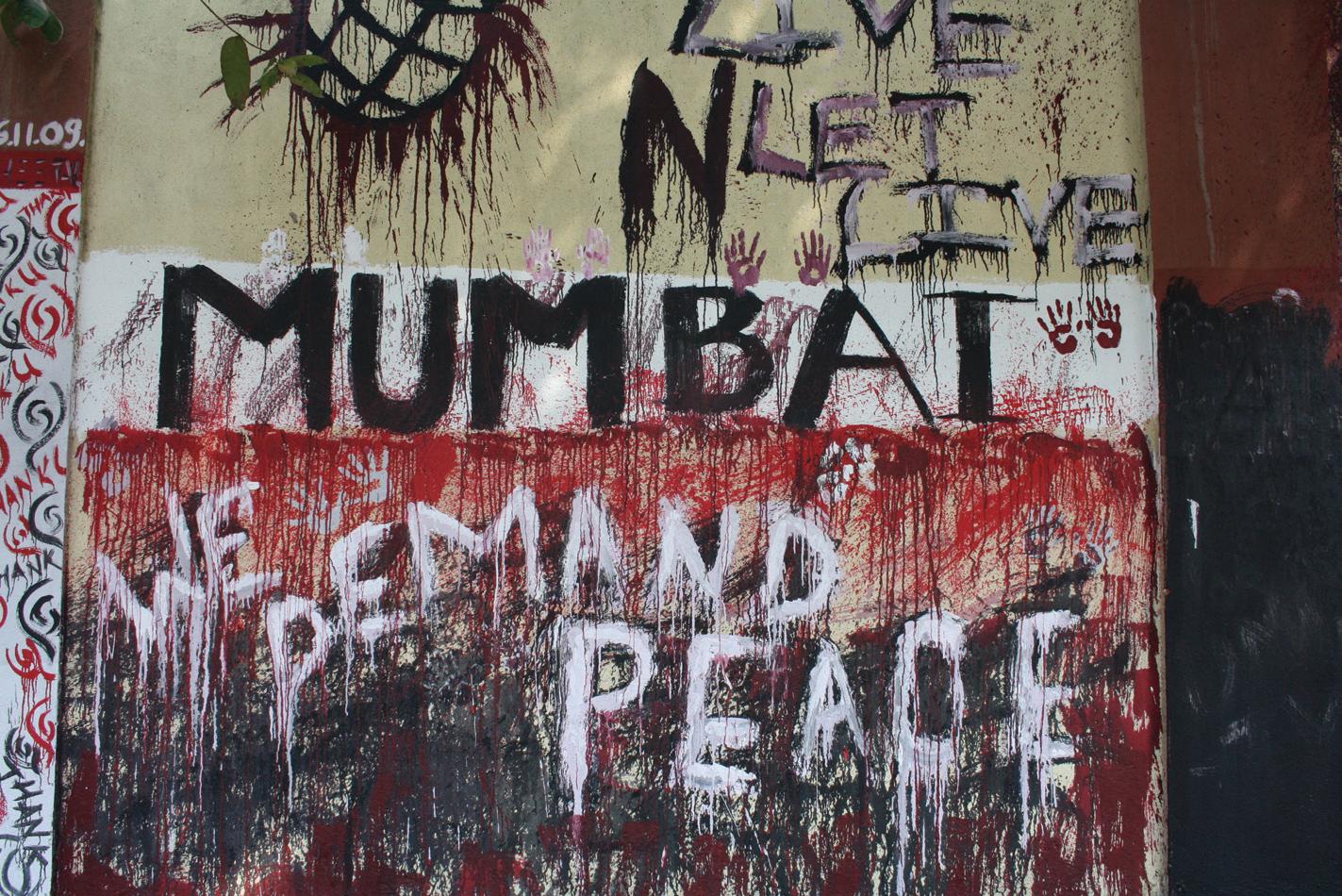
JULY (2) 2011 <> 21 NATIONAL EDITION
www.indianlink.com.au
INFOCUS
Right now, the media is full of speculation, the government is full of reassurances, but one can sense a feeling of rising anger at the incompetency that has made this city a target of attack yet again
As Mumbai scrambles to come to terms with yet another terror attack, it is obvious that mere resilience will not rescue the city gripped by a deepening undercurrent of communal tension
Discovering new perspectives
BY GAURAV PANDEY

Five science students from India took part in the prestigious Professor Harry Messel International Science School (ISS) 2011 – a two-week science education programme for Year 11 and 12 students held in the School of Physics, the University of Sydney from Nikhil Mahajan from Faridkot, a small town in Punjab, said he was “extremely happy” to be a part of the programme. He plans to join the Indian Administrative Service (IAS), and he may have already taken a step in that direction by securing 132nd rank in the extremely challenging IIT joint entrance exam. “It was great to interact with other participants and teachers,” he says. “For me, interacting with great scientists such as Professor John Pindry, the invisibility pioneer was the most rewarding experience.”
Lalith Kishore found the Sydney winter “too extreme a change” from Chennai’s hot and sultry summer, but that didn’t deter him from enjoying the city thoroughly. “The civic sense in people here is admirable, they are friendly people who open up to you,” he says. “Despite some of us being a little shy in the beginning, we all felt at home here.”
Jisha Kambo, the only girl among the five, comes from Shillong, a beautiful town in North Eastern India. She plans to go to Cornell University to pursue a Bachelor’s degree in science. “The best thing was that we could follow a lot of what the teachers were saying, despite a lot of those concepts being too advanced for students in our age group. I developed a deep interest in particle physics during the programme,”
she says, adding that the two weeks were a combination of lectures, sightseeing and interaction with people of different ethnicities and cultures.
Jyotesh Singh from New Delhi was another IIT-bound student in the group. For him the programme stood out for its “interactive environment” which allowed students to share and explore. “We took part in various science and social activities and learnt from one another,” he says. “I particularly enjoyed being a part of the various science workshops.”
Kochi boy Satyawageeshwar Subramanium wants to become a “technocrat scientist.”
His love for pure science found him a place at the prestigious Indian Institute of Science in Bangalore. Like many others, he too was pleasantly surprised to find out that not only did they understand a lot of the higher
concepts being discussed, their thorough understanding of the fundamentals of physics allowed them to contribute to many discussions. “The Indian education system is very good up to class 12. We study everything in depth. But I feel the Australian education system is better as far as flexibility in choosing your subjects is concerned. Here they can choose a lot of electives, which we only can expect to do in college,” says Satyawageeshwar.
The students recounted with pleasure their interaction with officials, including Amit Dasgupta, the Consulate General of India in Sydney at a reception he hosted for them. “ For me, that was the most memorable part of the trip. I really enjoyed the opportunity to talk to diplomats about their profession and its challenges,” says Nikhil.
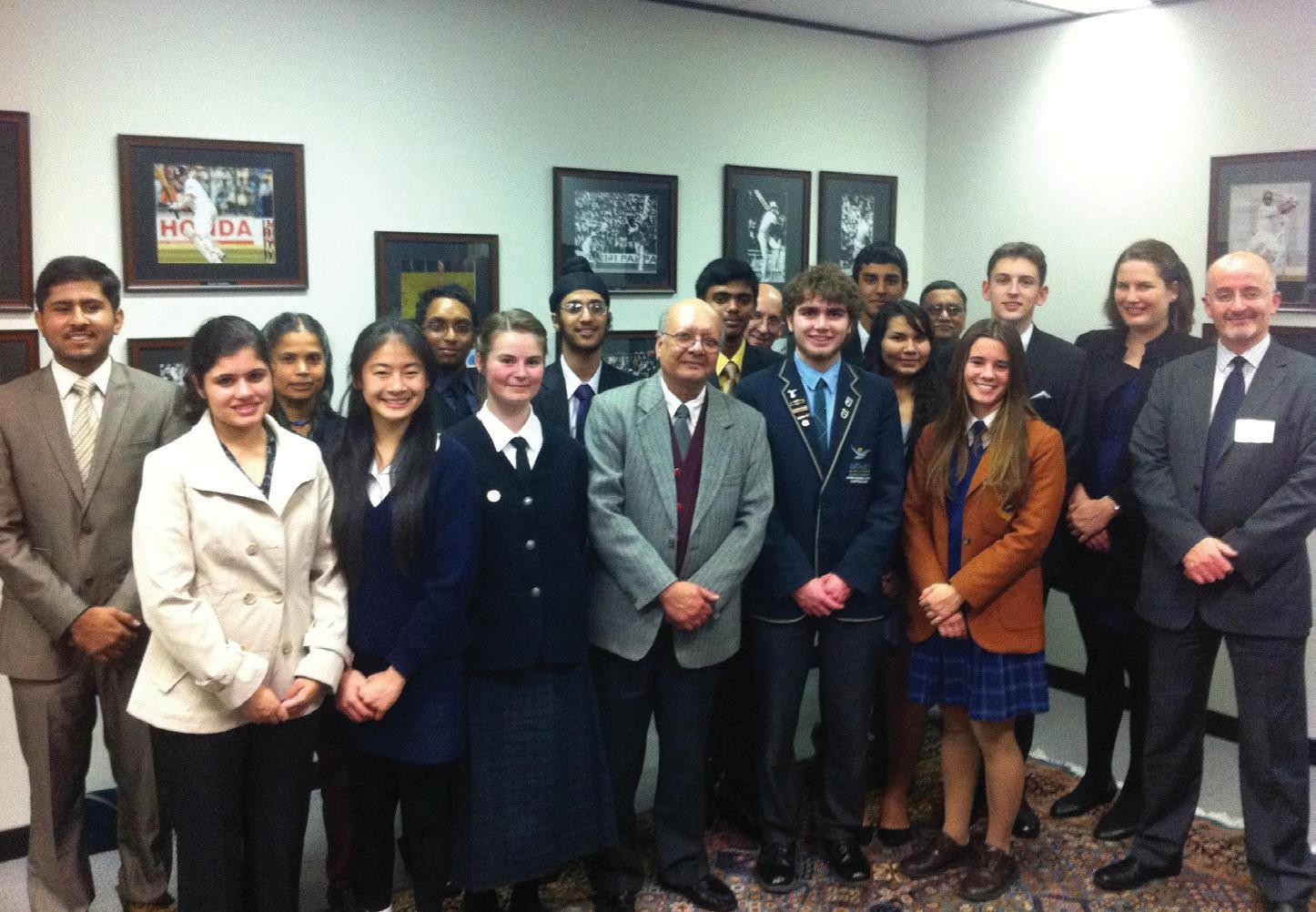
The fact that the students, who overcame stiff competition from tens of thousands of their peers, hail from across the country highlights the rising standard of education in even smaller towns in India. It is heartening to see talented youngsters from far-flung, lesser-known areas as informed as their counterparts from the traditional education hubs.
The ISS is a free 2-week educational programme run every two years by the Science Foundation for Physics, University of Sydney. It is regarded as the best of its kind in the world, covering a wide range of topics in science. One of the features of the programme is the lecture series. Past ISS lecturers include James Watson who won a Nobel Prize for discovering the structure of DNA, and Jerome Friedman, also a Nobel laureate his for work on particle physics. The ISS is the brainchild of Professor Harry Messel who has dedicated his life to the pursuit of excellence in education, and that’s the message he had for ISS participants. “A life lived in pursuit of excellence is a life well lived,” he said at a reception hosted for the students at the University of Sydney. “Learning is exciting, and one should never stop asking questioning in life, because that is what scientists do,” he added.
Dr Chris Stewart, Manager, ISS, said in a press release, “It’s great to have an international programme as it promotes good global citizenship. After all, any potential challenges our world will face in the future will have to be solved, and possibly pre-empted, by individuals of the calibre that attend the ISS all working together. We know that the students that attend the ISS today, are the future leaders of tomorrow.”
Can the environment keep bouncing back?
The Faculty of Agriculture, food and natural resources at the University of Sydney organised its annual symposium recently. Speakers of International repute presented their views about environment’s resilience at this forum.
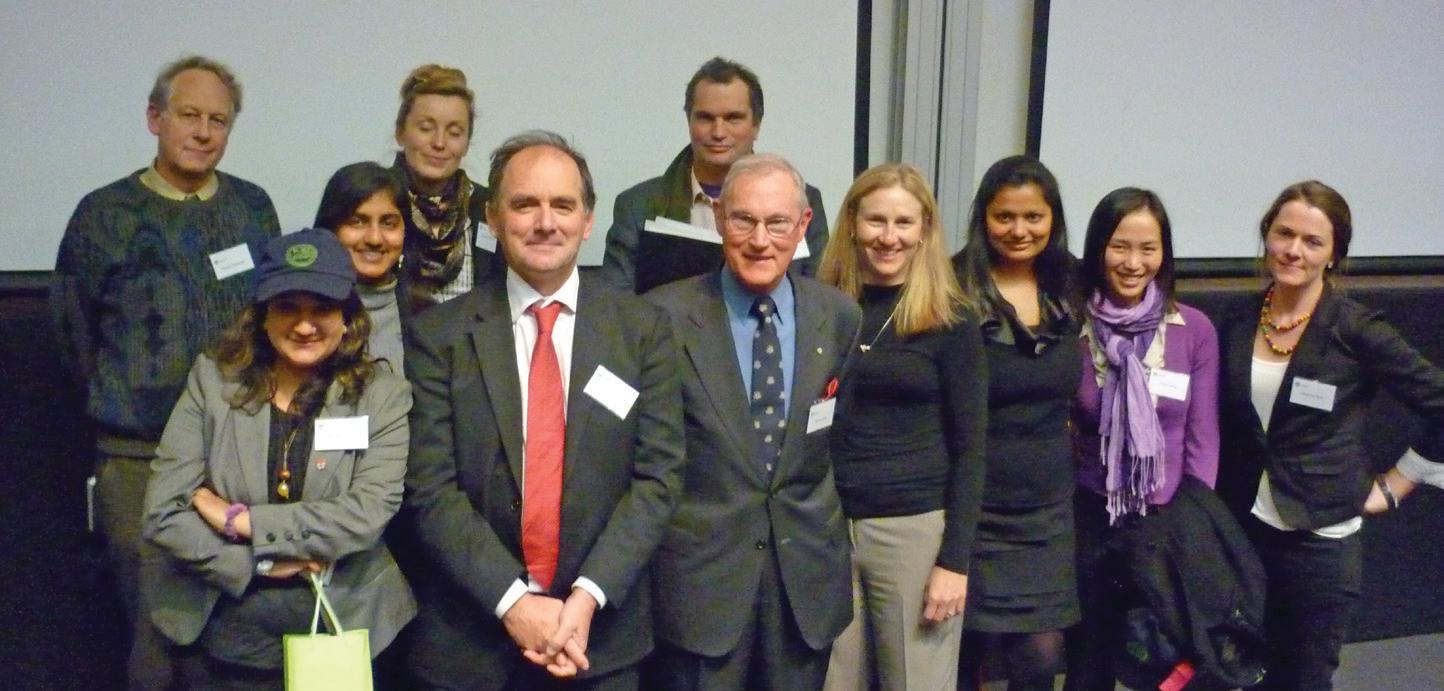
Various scientists and guest speakers such as Professor Mary O’Kane, NSW Chief Scientist; Professor R. Quentin Grafton, Director, Centre for Water Economics, Environment and Policy (CWEEP); Professor Karl-Göran Mäler, Director, The Beijer Institute of Ecological Economics, The Royal Swedish Academy of Sciences; and Dr Jayne Belnap, Research Ecologist, United States Geological Survey, expressed their views on the occasion.
Faculty Dean, Mark Adams, other faculty academics and researchers also spoke about resilience including Ichsani Wheeler, Adrienne Ryan, Deviga Vengadasalam, Chun Liang, Robert Pallasar and Indian PhD students Kanika Singh and myself.
Most of the research scholars presenting at the symposium have finished their research work and are in the process of thesis writing. Above named were the faculty finalists who spoke about their research at the “Three
Minute Thesis Challenge”.
The symposium focused on answering questions such as: Can we produce enough food for the expected world population of 10 billion later this century? How are scientists addressing threats such as cereal rust that can wipe out entire crops? Will forests stop regenerating eventually if more forest wild fires as seen on Black Saturday occur?
Professor Amthor from the University of Sydney presented the argument that population models project a 33 % population
increase by 2050 which, when coupled with raised living standards in developing nations, indicates the need to increase crop productivity by 50 % in less than 40 years. My research focused on studying levels of an anticancerous phytochemical called glucosinolates which are found in crops such as broccoli and Indian mustard. I also looked at the interaction of the chemical with a fungal disease on the crops and biochemical pathways relating to production of the crop. This study revealed that levels
of glucosinolates increase due to infection/ plant stress and further studies on this can be beneficial to pharmaceutical research and agricultural crop protection research.
Kanika Singh, another budding soil scientist spoke about her work on carbon sequestering and management in soil. It was a complex yet interesting task to explain about the research work done in 3-4 years in a slot of 3 minutes. The real deal was to recite it like a story and keep the audience engaged at the same time. Another highlight of the day was the research poster presentation competition in which around 25 research students participated with the best poster award and the audience favorite prize. The audience favorite prize was selected by audience pole/voting.
The all day eye opening Symposium successfully closed at 5.00 pm after the prize distributions and commendations to the researchers and students. The Dean’s thank you note was followed by invitation to all guests and participants for canapés and drinks and informal discussions. There is nothing like a perfect Friday evening after a day full of brainstorming and innovative ideas about saving the environment.
22 <> JULY (2) 2011 INDIAN LINK
STUDENTS
For five Indian students, attending a prestigious science forum has given them precious exposure
The Faculty Dean at the symposium with participants and judges
The five Indian students with their Australian peers and organisers from the ISS, at a welcome event hosted by the Counsel General of India, Amit Dasgupta (centre).
Photo: Skaidy Gulbis Astha Singh

JULY (2) 2011 <> 23 NATIONAL EDITION
Two Indian films at Melbourne film festival
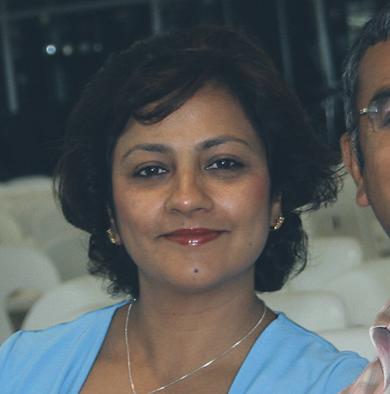
In

 BY RAJNI ANAND LUTHRA
BY RAJNI ANAND LUTHRA
While the Sydney Film Festival disappointed Indian movie buffs this year by not picking a single film from India as part of its lineup, desi festival fans in Melbourne will get to see two films from India.
The Melbourne International Film Festival (MIFF), to be held from 21 July to 7 Aug, will screen two offbeat films from India. This follows on from last year, when Peepli Live premiered at MIFF, bringing hordes of Indian film fans to the festival for the first time. Of course that the film’s producer Aamir Khan came to introduce the film probably helped in attracting the crowds. But then again, this is exactly the lesson that festival organisers should be
UK-based director Phil Cox’s ‘featuredocumentary’ TheBengali Detective has already wowed audiences at this year’s Sundance Film Festival
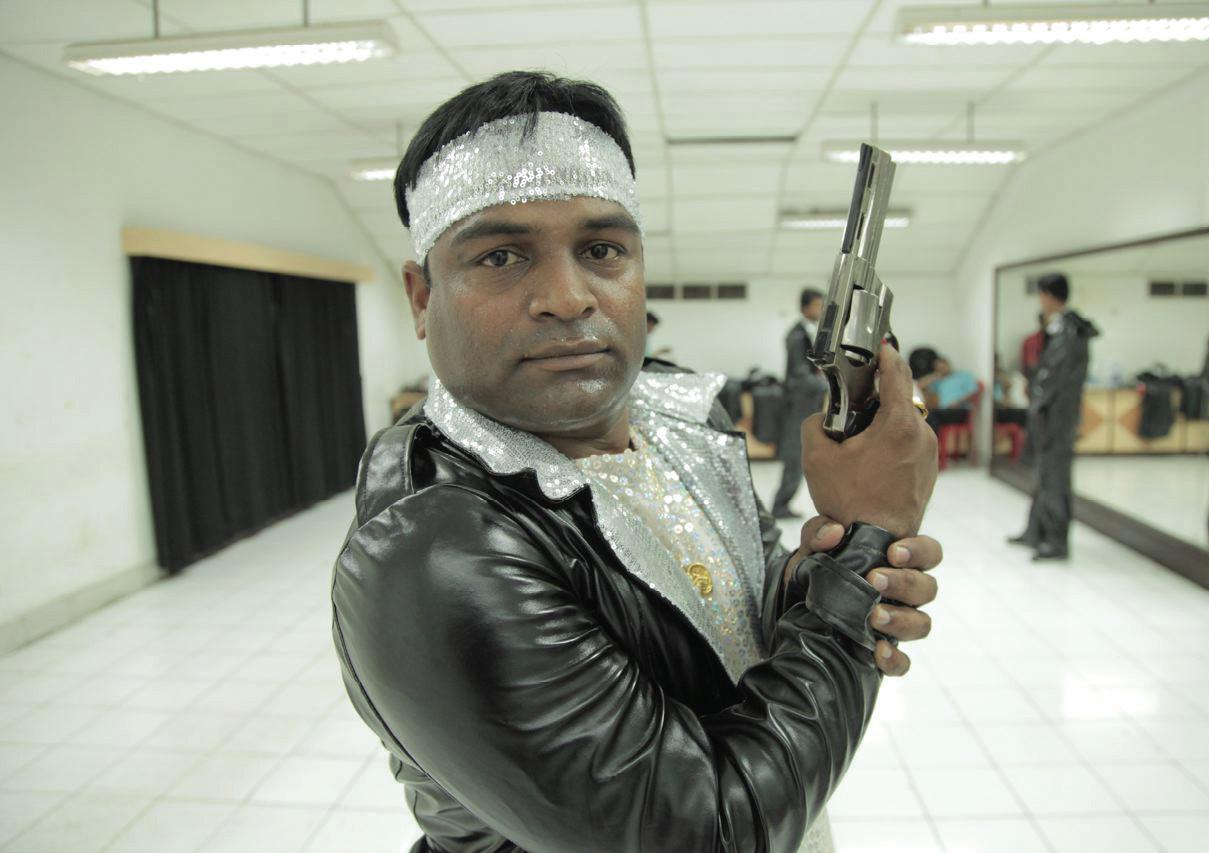
learning - book those Indian films, get the stars out here to introduce the films, and bingo, you’ll have the bums on seats you’re looking for!
UK-based director Phil Cox’s ‘featuredocumentary’ The Bengali Detective has already wowed audiences at this year’s Sundance Film Festival. It follows the real-life story of Rajesh, a small-town guy who moves to the Big Smoke to eke out a living doing what he loves best - investigating crime. Through his life at work, and outside of it, we are offered a look at contemporary life in India. The film follows three cases that his detective agency is investigating: counterfeiting, domestic abuse and adultery, and murderthree of the fastest growing crimes in India. Meanwhile, after hours, the dance-obsessed Rajesh and his mates want to enter a talent competition on national TV. And at home, Rajesh’s beloved wife is dying of diabetes –a fact that he can do nothing about – even though at work he’s hell-bent on “cleaning up India’s mess”. Check out details at www. thebengalidetective.com
The second film from India at this year’s festival is by another UK-based director. The theme in Kim Longinotto’s Pink Saris is quite familiar to Australian audiences. The film is based on the Gulabi Dal, a group of women activists in UP who campaign against the social injustices that women in rural India face. Led by Sampat Devi Pal, herself a child bride and now a mother of five who suffered much abuse at the hands
of her in-laws, the women - all clad in pink saris - have intervened in countless cases to stop child marriages, protest against dowry demands, or free women from abuse.
Together, the two films show a side of India different from the one we have grown used to in the recent past, that of a fastly-modernising culture ready to become an economic giant. Yet they promise to be experiences festival-goers will not forget in a hurry.
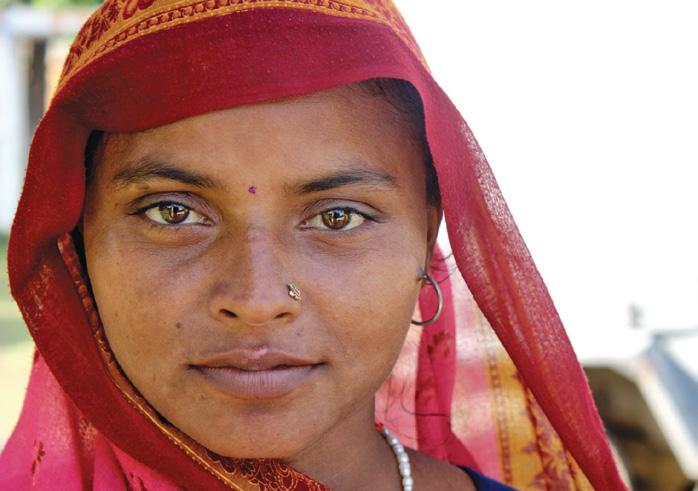
24 <> JULY (2) 2011 INDIAN LINK
www.indianlink.com.au
TheBengaliDetective and Pink Saris, moviegoers will have an opportunity to watch two honest films which show a side of India that continues to flutter beneath the euphoria of globalisation
CINEMA
Off the beaten track: TheBengaliDetective(above) and Pink Saris
A spectacular tribute
BY ANUSHA MENON

Australian youth of Indian and Sri Lankan backgrounds are becoming visibly more receptive to their ethnic identities. Multiculturalism has helped foster a greater appreciation and interest in the culture of their origin. If anyone should doubt this, they will surely change their mind after seeing Eastern Empire in action!
On July 2, a talented bunch of young musicians originating from the east who all call Australia home, came together as Eastern Empire and presented The Tribute, a concert celebrating the music of two great maestros of Tamil cinema: Ilaiyaaraja and A R Rahman.
In doing so, they successfully challenged the notion that youth of subcontinent origin struggle to satisfactorily embrace their ethnic culture in western society. Instead, the fresh young band demonstrated a promising aptitude for maintaining harmony between eastern and western cultures. Not only was the concert indicative of these young people’s genuine love and interest in their Tamil culture, it also displayed their engagement with global affairs and issues concerning the welfare of Tamil people as a whole. All proceeds raised from the show went towards the Global Tamil Forum, a democratic and inclusive body that seeks lasting peace in Sri Lanka.
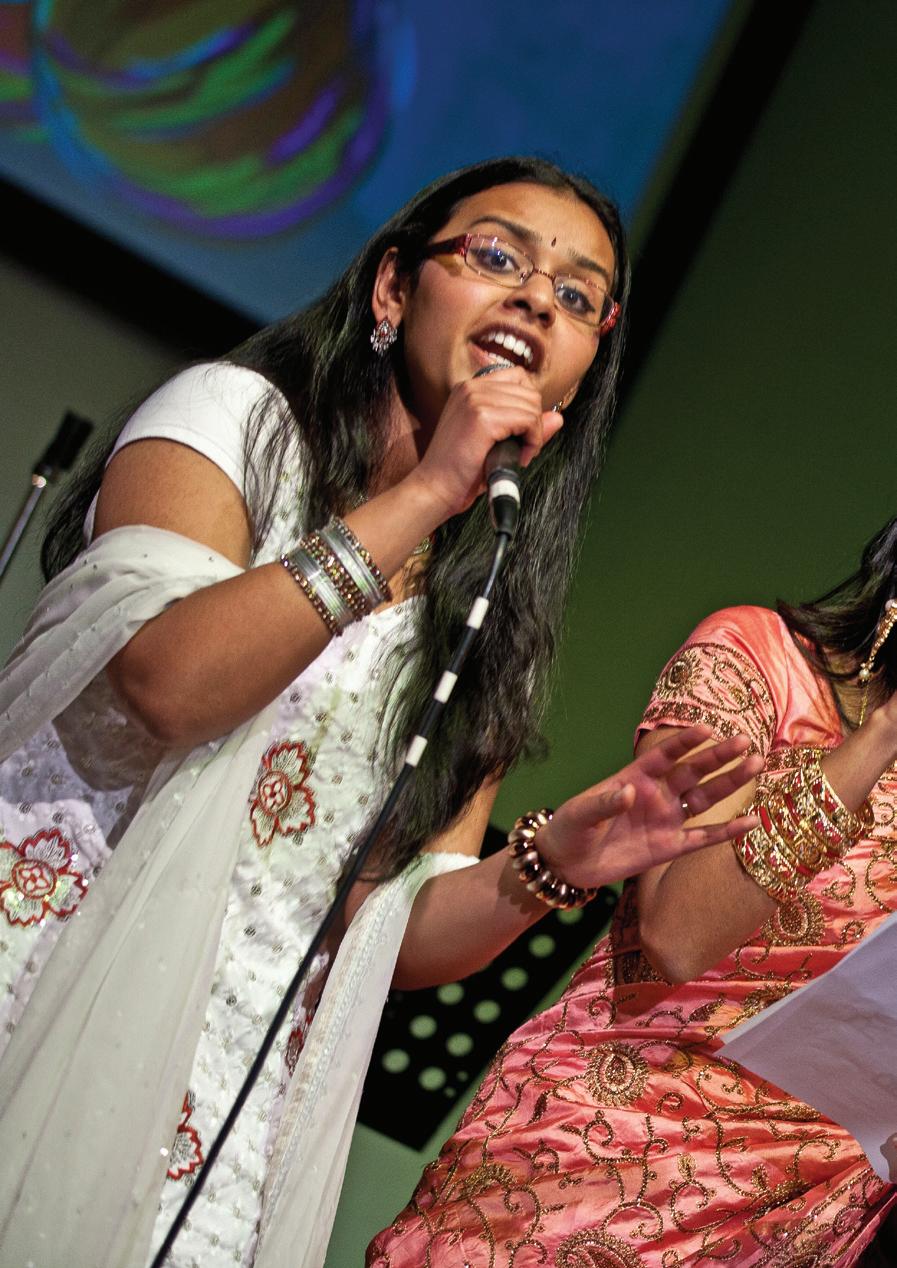
The band is comprised of both, classically trained and self-taught musicians from Sydney. While Eastern Empire call themselves a “cinemaband” on their Facebook page, this classification hardly limits them from showcasing their talents in a variety of other musical styles, including hip-hop and R&B. Often the band will skillfully fuse these genres with songs from Indian cinema, thereby synchronising the east with the west.
The Tribute was an overall spectacular event. Tickets sold like hot cakes and the C3 Church auditorium in which the concert was held, was filled to capacity. From the moment of commencement, the lines between this bunch
of youngsters with a penchant for performing Tamil cinema music and professional musicians from the subcontinent blurred substantially. Performing famous Tamil movie hits from some of Ilaiyaraaja and A R Rahman’s most popular soundtracks, one could easily be forgiven for assuming that these were playback singers brought directly from India to perform on stage. The band performed each song with poise and passion, their renditions uncannily close to the originals. Most
From the moment of commencement, the lines between this bunch of youngsters with a penchant for performing Tamil cinema music and professional musicians from the subcontinent blurred substantially
of the core members of the band don’t practice music for a living; some are university students, a couple work fulltime in other fields, and some are still in high school. The youngest performer on the night was Kaavya Jaishankar, a current Year 11 student, who left the audience in awe following her powerful rendition of Minsaara Poove, a notable A R Rahman hit which she performed with Sudhagar Sivabalan.
Each performer displayed confidence and genuine delight in being on stage and it was particularly heartwarming to see the band members interacting with each other in a close and friendly manner. On the night, eastern culture bound youth together, both on stage and in the audience.
The proficiency with which The Tribute was carried out indicated that the band had rehearsed extensively for the show.
“This production has taken about 2-3 months work,” says Janakan Raj, one of the band’s percussionists and a coordinator of the event. The band covered songs from the 70s to today, and hits performed included Ilaiyaraaja’s Endhan Nenjil and the poignant Thenpaadi Cheemaiyile from the movie Nayagan. Special mention has to be made of this song, sung by Tirukumar Thiagarajah, which was dedicated to all children, particularly those who are disadvantaged. During the rendition there was pin-drop silence as the audience listened intently to Tirukumar sing the difficult piece containing a single melody, which he managed to pull of brilliantly and without compromising the

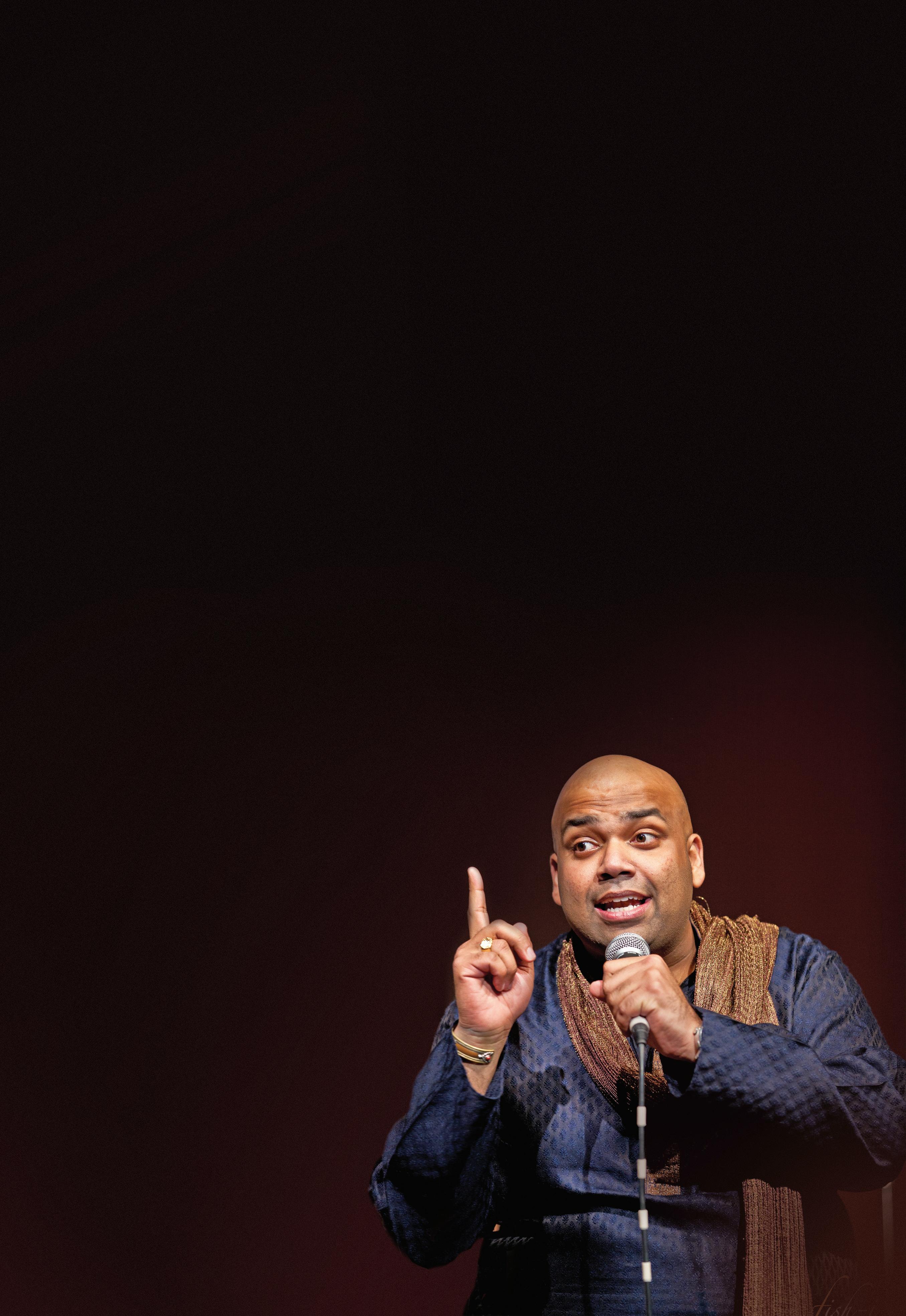
song’s sentimental value. The A R Rahman medley was another highlight of the show; each of the singers took turns in performing excerpts of some of Rahman’s defining hits, including Anjali Anjali Pushpanjali. Each of the performers brought a youthful exuberance to the concert; a couple of the band members showed off their dancing skills during the more up-beat songs and the hype of the show reached its pinnacle in the closing song of the night, Rahman’s Balleilakka from the movie Sivaji. This song was received with a standing ovation and an eruption of cheers across the audience.
Eastern Empire is an extremely gifted band and was an absolute pleasure to watch on stage. For the talented, enthusiastic young band, it is only onwards and upwards from here. On behalf of the band, Janakan Raj says, “We express our love of Indian culture through music. We hope that we can send a message to Australian youth to embrace their culture through any form, whether it be music, language, fashion or any other.” Hopefully, all Eastern-Australian youth will take heed to these words!
Watch out for Eastern Empire at the India Australia Friendship Fair on August 14, or check out their Facebook page. To find out more about Global Tamil Forum, visit www.globaltamilforum.org
1 Kaavya Jaishankar was the youngest performer on the night
2 Sudhagar Sivabalam performed the AR Rahman hit Minsaara Poove with Kaavya Jaishankar

3 Coordinator of Eastern Empire and percussionist Janakaran Raj playing the mridangam
4 Haresh Nair playing the guitar
Photos: Fish-i-Fotography
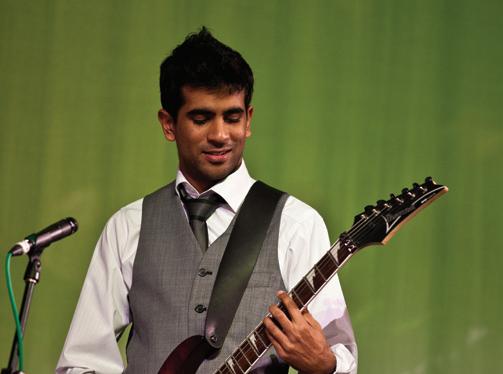
www.indianlink.com.au
A bunch of young musicians recreate the melodies of modern masters with amazing aptitude
4 3 1 STAGE
Tirukumar Thiagarajah's soulful rendering of Thenpaadi Cheemaiyile was immensely touching
Workshop proves to be a winter warmer




Be it cooking classes, art clinics, science workshops, adventure outings or even a day at the movies, school holidays have become busier than ever before; particularly so for Indian-Australian kids of Hindu lineage, with so much on offer from the cultural front as well.
Over the past few years, Vishwa Hindu Parishad’s winter holidays’ day camp has become quite a fixture for its well-structured content and efficient delivery. Run by a dedicated team of volunteers, it provides a sensitive balance of work and play that keeps both kids and their parents happy.
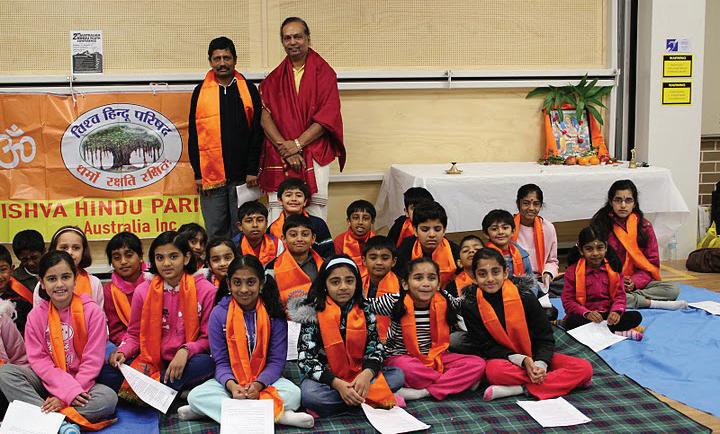

Bal Utsav, VHP’s Hindu cultural workshop drew many kids to Toongabbie Public School last weekend. Old-fashioned Hindu values were imparted to kids with generous doses of fun, making the experience an enjoyable one.
The day camp began with customary morning prayers to Lord Ganesha by
priest Ravi Gurukkal. Akila Ramarathinam, VHP general secretary then introduced the children to spirituality, explaining the importance of pooja and morning rituals. The quintessential Hindu shloka –Gayatri mantra (with emphasis on correct pronunciation and raga) was among the many simple but effective prayers that were imparted to the children.
Oral chanting, an ancient Hindu tradition not only strengthen the lungs but also improves memory and concentration.
The children were then initiated into another Hindu classic, which nourishes body, mind and soul - yoga. Yoga, no doubt, can be a little daunting for novices, but the volunteer teachers ensured the children were at ease with more complex postures, gently guiding them through the process. Several asanas like siddhasana, padmasana, parvatasana, vajrasana, bhujangasana, dhanurasana were taught during the course
of the session.

While sloka chanting helped to awaken their sleeping mind, yoga provided adequate fitness and flexibility to participate actively for the whole day.
Children were then served hot chocolate and biscuits, a welcome boost on a cold and wet day.
Fun-filled energetic games kept them occupied for the next few hours. Participants were divided into groups based on age and interest in games. Little ones also got involved in creative craft.
Delicious vegetarian lunch to fuel their body was served. Not only did the kids enjoy the sumptuous food, they also learnt to clean their own cups and plates.
Post-lunch session involved creative artwork. The children learnt about the Holy Trinity and Hindu pantheon. Particularly informative and enjoyable was the session on GOD – the Hindu trio of generator,
operator and destroyer. Kids enjoyed thoroughly making God family tree.
As the workshop drew to close, children displayed their newly learnt skills to the parents assembled there. Certificates and tokens for excellence were handed out.
The standout of the event, no doubt was careful planning, smooth running and efficient time management. The organisers Brij Pal Singh, Akila Ramarathinam, Saravanan, Kiran Guntur, Mehul Joshi and their dedicated band of volunteers deserve full credit for pulling off another successful event.
The next major event from the VHP stable is the 2nd Australian Hindu Youth Conference, which is slated for 7 August. A day night Kids camp has also been planned in October.
26 <> JULY (2) 2011 INDIAN LINK
www.indianlink.com.au COMMUNITYSCENE
Photos: Akila Ramarathinam Sumana Devi and Usha Arvind
BY NOOPUR SINGHAL
“Sydney through foreign eyes,” is how photographer Aditi Bhonagiri describes the exhibition Sydney Diaries: Urban Constructs Featuring the works of Jessica Angelina Rungkat, Christine Pizzuti and Aditi Bhonagiri, this exhibition is an exploration of Sydney’s urban landscapes through the
Sydney is captured in different aesthetics, representations and picture stories of its glory and ruins as the city that happened
multicultural eyes of three Sydney based photographers who were born in Indonesia, Italy and India. Their work pays tribute to the city they have come to call home, which has been instrumental in shaping their identity and beings, and as a place where many are alien, and yet part of the urban chaos.
The exhibition, hosted recently by Pine Street Creative Arts Centre Gallery in Chippendale, showcases the city in dreamlike colours and in more classic black and white images. Sydney is captured in different
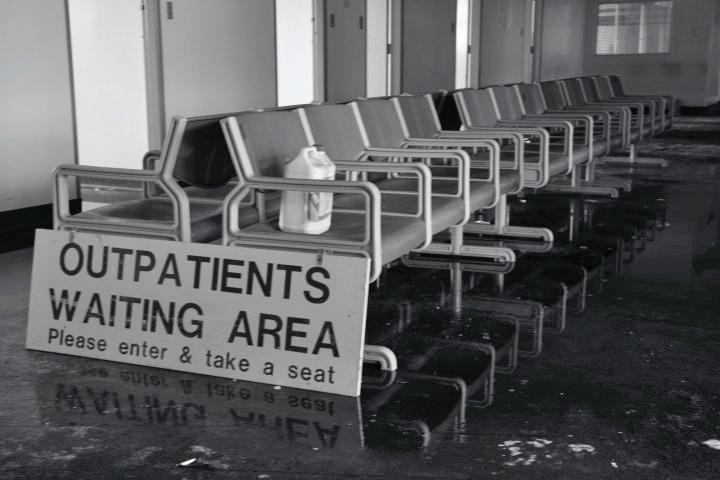
Viewers will also experience a sense of waiting in her work, a sense that the buildings are not ruined just yet, they are simply waiting to be restored to their former glory and loved once again


The soul of Sydney
aesthetics, representations and picture stories of its glory and ruins as the city that happened. Some places you may know and some places you may have never known, or some never known better. In celebration and admiration of the urban fabric of the city, Sydney Diaries documents three perspectives of the city, The Iconic Sydney by Christine; The Reminiscent Sydney by Jessica; and The Abandoned Sydney by Aditi.
Aditi Bhonagiri’s work captures old constructions that have contributed to the industrial and urban lattice of Sydney. These structures that once enjoyed a glorious past and represented Sydney’s economic, social and industrial hegemony are now reduced to symbols of ruin, decay, isolation, death, vandalism and more. In some cases, these structures have given solace to those seeking creative freedom, but most continue to revel in their lost glory and continue to remain abandoned by society with its figurative vultures flying above them.
When asked why she chose Sydney and moreover the vacant, empty, decaying buildings as her subject matter, Aditi says, “Having lived around Chippendale and Redfern for most of my life in Sydney, I was surrounded by it. And it was thrillseeking and more rewarding in some aspects. At least I will die knowing something that has lived a complete existence, from life to prosperity, to
decline to death, and finally afterlife.” Her work conveys these thoughts of degeneration and rebirth in their composition and tone. The Decaying on 94 Douglas Street, Camperdown is Aditi’s favorite work in the show because of “the symbols of sadness and isolation depicted in this image. It really shows the process of slow death”, she says. Viewers will also experience a sense of waiting in her work, a sense that the buildings are not ruined just yet, they are simply waiting to be restored to their former glory and loved once again.
Sydney Diaries came about when Aditi met her fellow photographers while
arts festival in Chippendale, and they decided to collaborate. For an artist not yet 25, Aditi’s work shows a depth of understanding that is beyond her years and the exhibition leaves

NATIONAL EDITION
SYDNEY DIARIES
www.indianlink.com.au
TheDeserted:DunlopSlazengerFactory,Alexandria
The Forgotten: Rachel Forster Hospital, Redfern
The Exhausted: White Bay Power station, Balmain
A young artist has captured the essence of this enigmatic city in its glory, decay and rebirth, through provocative visuals
Photos: Aditi Bhonagiri
‘Indian government a bunch of softies’
Expressing shock over the Mumbai bomb attacks, many Indian Americans have taken the Indian government to task for its failure to stop the repeated terror attacks on the country’s financial capital.
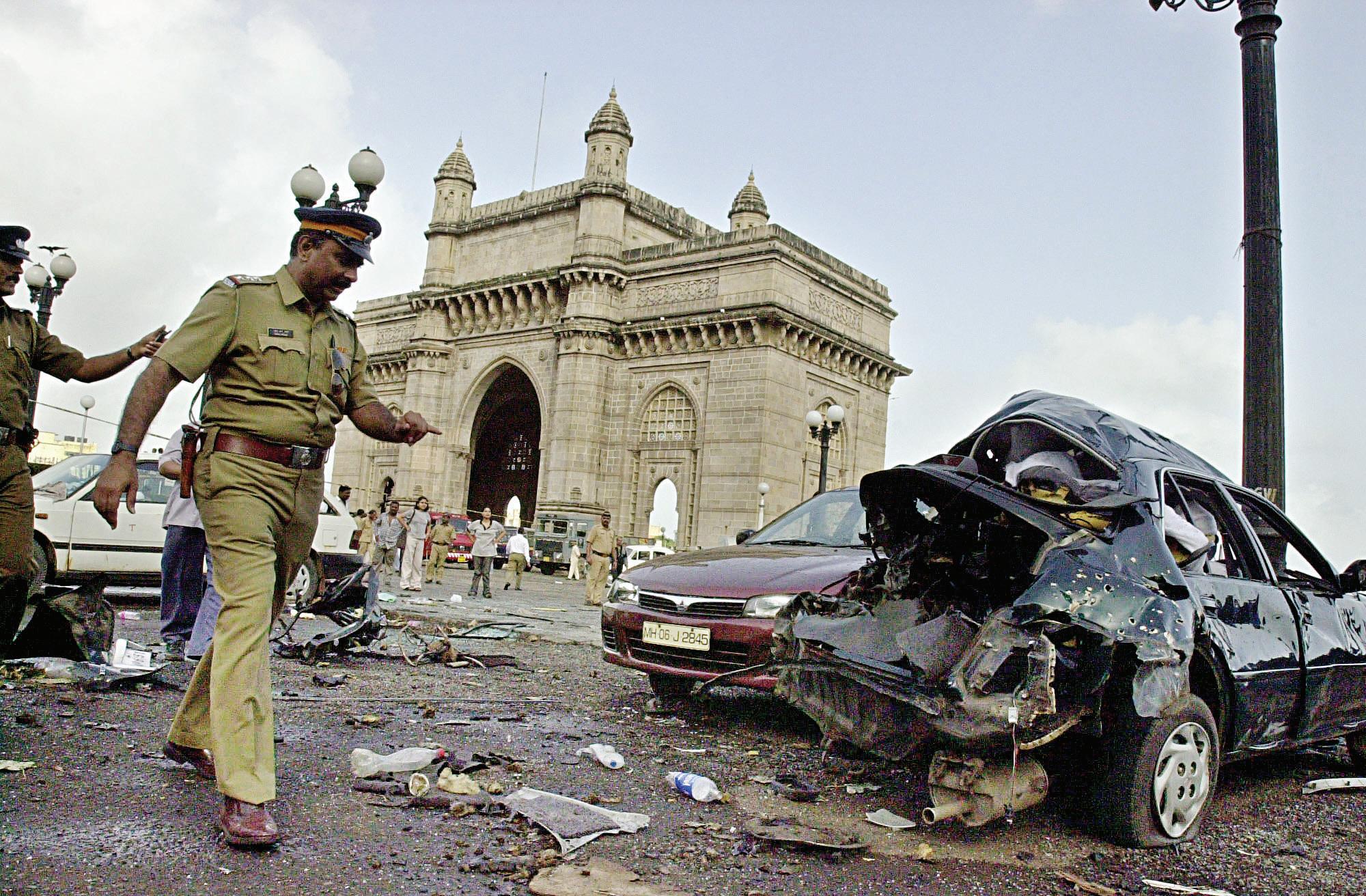
“Our government is a bunch of softies. They didn’t learn from the 2008 attacks. These politicians are bothered about winning elections and not interested in protecting people from terrorism. I am afraid these attacks will keep happening,” said Chicago-based IITian and businessman Ray Mehra.
Mehra, who also heads Pan-IIT in the Mid-West, said, “Unless the current generation of Indian politicians are serious about action against terrorism and corruption, India is headed for some kind of revolution because young people are absolutely fed up with the present system.’’
New York-based software architect Manas said, “Two days after the fifth anniversary of the July 11 serial train bombings in Mumbai, terror hit the commercial capital yet again on July 13. What is the government doing to secure us?
“The government does not care about these blasts or how many people lost their lives. Ministers are only concerned about getting into power. Find those behind these terrorist acts and hang them to death.’’
Ashok Singh, management consultant with Strong-Bridge LLC in Seattle, said the fresh terror attacks on Mumbai clearly indicate the lack of resolve by the Indian government to tackle terrorists head on.
“People are not just the victim of terrorism but also the victim of apathy and weakness of the Indian government. I hope the government will move beyond expressing concerns and take concrete steps to ensure security of its citizen. I truly believe India has the resources to create a deterrence against the evil designs of terrorists but not sure what the government is waiting on to wake them up,” he said.
The Global Organization of People of Indian Origin (GOPIO) expressed its “strong and unequivocal condemnation’’ of the series of bombings in Mumbai.
India largest source of skilled migrants to New Zealand India has emerged as the largest source
country for New Zealand with a 12 % increase in approval of applications under the skilled migrant category for the 2010-11 financial year.
Among the top source countries to New Zealand, Britain decreased by 17 %, China decreased by 11 %, South Africa decreased by 37 % and the Philippines decreased by 25 %, according to the Migration Trends Statistics (MTS) report for July 2010 to May 2011.
India’s increase was due to former Indian students who transited to temporary work and then on to permanent residence, it said.
“The drop in skilled migration has seen a decrease in residence approvals from all of the main source countries, with the exception of India,” the MTS report stated.
The report focused on three key areas - the New Zealand residence programme, permanent skilled migration and temporary entry.
With regard to student visas to New Zealand, as many as 69,448 people were approved in July 2010-May 2011 - a 3% increase from the 67,453 in the previous financial year. From July 2010-May 2011, the largest source countries of students were China (23 %), India (14 %) and South Korea (12 %).
Indian-origin MP Kanwaljit Singh Bakshi said as New Zealand was a peaceful country, it has emerged as an ideal destination for study. Its spectacular scenery and rich and diverse culture were the other factors that made it a favourite among Indians.
Richard Howard, honorary member and past chairman of the New Zealand Association for Migration and Investment, said: “These statistics confirm the clear trend that New Zealand is seen as an increasingly attractive study and migrant destination for Indian students.”
US Hindus to donate blood on 9/11 anniversary
Hindus in the US plan to donate blood to commemorate the 10th anniversary of 9/11 this year.
The Hindu Mandirs Executive Conference (HMEC), an apex body of about 600 temples in the US, has appealed to the Hindus who form majority of the approximately three million IndianAmericans in the US to join the effort.
The initiative is expected to benefit patients of Asian descent who require a
closer blood match than that provided by ABO positive/negative blood typing.
The HMEC, which is coordinating the initiative with agencies such as the American Red Cross, said it is extremely important to increase the number of available blood donors from the Asian communities.
This is for the first time that such an event will be held at temples across North America, the organisers said.
Just 5% of the total eligible population in the US gives blood, however less than 1% of the Asian community donates blood, HMEC said in a statement Friday.
According to the US National Institutes of Health, nearly 14 million units of whole blood and red cells are required every year.
Rahul M. Jindal, transplant surgeon at Walter Reed AMC and national coordinator for the event, has urged Hindus and IndianAmericans to donate blood on 9/11 or around that time.
About 3,000 people were killed Sep 11, 2001, in the US when Al Qaeda terrorists crashed hijacked commercial jets into the twin towers of the Word Trade Centre, the Pentagon and in a field.
Punjab’s runaway NRI grooms lose passports
NRI grooms who believe “holiday marriages” are an easy way to make some money can think again. In just two months, the regional passport office (RPO) here has confiscated the passports of 48 men who married, allegedly got dowry, dumped their wives and attempted to flee the country.
In Punjab’s Doaba area, an NRI groom is a prize catch. But many women have had a bitter experience. There have been numerous instances of men settled abroad coming back to marry and abandoning their wives after taking away their money and valuables.
To stem this exploitation, the RPO, which functions under the Ministry of External Afairs, initiated a women’s grievance cell in February.
“We have established a ‘women’s grievance cell’ to hear complaints from women who have been duped by their NRI husbands. So far, we have confiscated 48 passports of errant husbands by invoking a legal provision of the Passport Act, 1967,” Parneet Singh, the passport officer of the Jalandhar RPO said.
The complainant has to submit the marriage certificate, copy of the First Information Report (FIR) filed with the police and documents detailing husband’s name, date of birth and address.
“Over 100 complaints are still under our scrutiny and we would soon take appropriate action,” the official said.
Once the complaint is received, he said, a show cause notice is issued. If there is no response to the notice, the passport is confiscated when the NRI shows it at the airport.
“Then he cannot leave the country until the matter is resolved, either legally or through mutual consent,” he added.
“However, if he manages to flee, then we inform the Indian embassy in that country and he would be immediately deported to India, depending on the merits of the case,” Parneet Singh said.
According to the passport office officials, Section 10 (3) of the Passport Act says the issuing authority can impound the passport in the public interest after giving a show cause notice.
The Jalandhar RPO caters to Jalandhar, Hoshiarpur, Nawanshahr and Kapurthala districts.
According to an RPO official, around 15,000 girls from Doaba region, consisting of Jalandhar, Hoshiarpur and Kapurthala districts, were duped by their NRI husbands during the last few years.
Jalandhar has the maximum number of such cases.
The officials have also directed district marriage officers to provide details about marriages involving NRI grooms so that their wives’ names can be added to the passports.
The initiative has encouraged women to come out and voice their grievances.
At 100, Sikh marathoner yearns to read biography
At the ripe old age of 100, iconic Sikh marathoner Fauja Singh has one regret. He yearns to read his biography but cannot - he is illiterate.
As the book Turbaned Tornado, penned by Chandigarh-based author Khushwant Singh, was formally launched at the Attlee Room of the House of Lords here Wednesday evening by Lord Anthony Young of Norwood Green and retired judge Sir Mota Singh, Fauja Singh was all smiles.
“I want to read my biography but unfortunately, I am illiterate,” he said, lamenting the fact that he could not read his biography, published by Rupa.
“But on second thoughts, my life is in front of my eyes like a reel, so I don’t need to read it,” Fauja Singh said.
At the book launch, organised by the Britain-based Anglo Sikh Heritage Trail (ASHT), he appeared bright and inspired as he fondly hugged his biographer Khushwant Singh, 38.
“When I shifted to the UK I did not know that my life would take such a turn,” said Fauja Singh, who lives in London’s Ilford area and has participated in several international marathon runs.
“It is a matter of great privilege to have got the opportunity to write Fauja Singh’s authorised biography,” the author Khushwant Singh said.
“Fauja has given a new meaning to the words endurance, aspiration and will power. Dictionaries would have to re-explain these words since Fauja had added a whole new dimension to them,” Khushwant Singh said, addressing the gathering at the launch.
John Athwal, winner of the 2011 Asian of the Year, said: “Fauja Singh is an inspiration for everyone. Whilst there were countless professionals, entrepreneurs, doctors, accountants who have origins from Punjab, Fauja was unique among all.”
28 <> JULY (2) 2011 INDIAN LINK DIASPORA
Three explosions struck central locations in Mumbai on July 13, including the crowded Dadar neighborhood; the Zaveri Bazaar, a well-known jewelry market; and near the Opera House.
Born April 1, 1911, at Beas Pind in Punjab’s Jalandhar district, age has not been a barrier for Fauja Singh.
The death of his son Kuldip and earlier of his wife forced him to search for a worthwhile alternative in life. At 89 years, he took seriously to running and ended up in international marathon events like the London, Glasgow, Toronto ones.
Having become the world’s oldest half marathon runner at 99 in May last year when he ran the Inter-Faith Marathon in Luxembourg, Fauja Singh, whose name means a soldier, is a one-man army who wants to keep running till he drops.
ASHT director Harbinder Singh said: “Fauja Singh is the embodiment of so many of the enduring qualities which have defined the Sikhs. Fauja Singh’s contribution to elevating the profile of Sikhs is beyond expression and his feats have left an indelible mark on many lives.”
“He is a unique man. He started running at an age when people actually hang up their boots. It is unique that he could be the only man who is alive at 100 years to see his biography being published,” Khushwant Singh said.
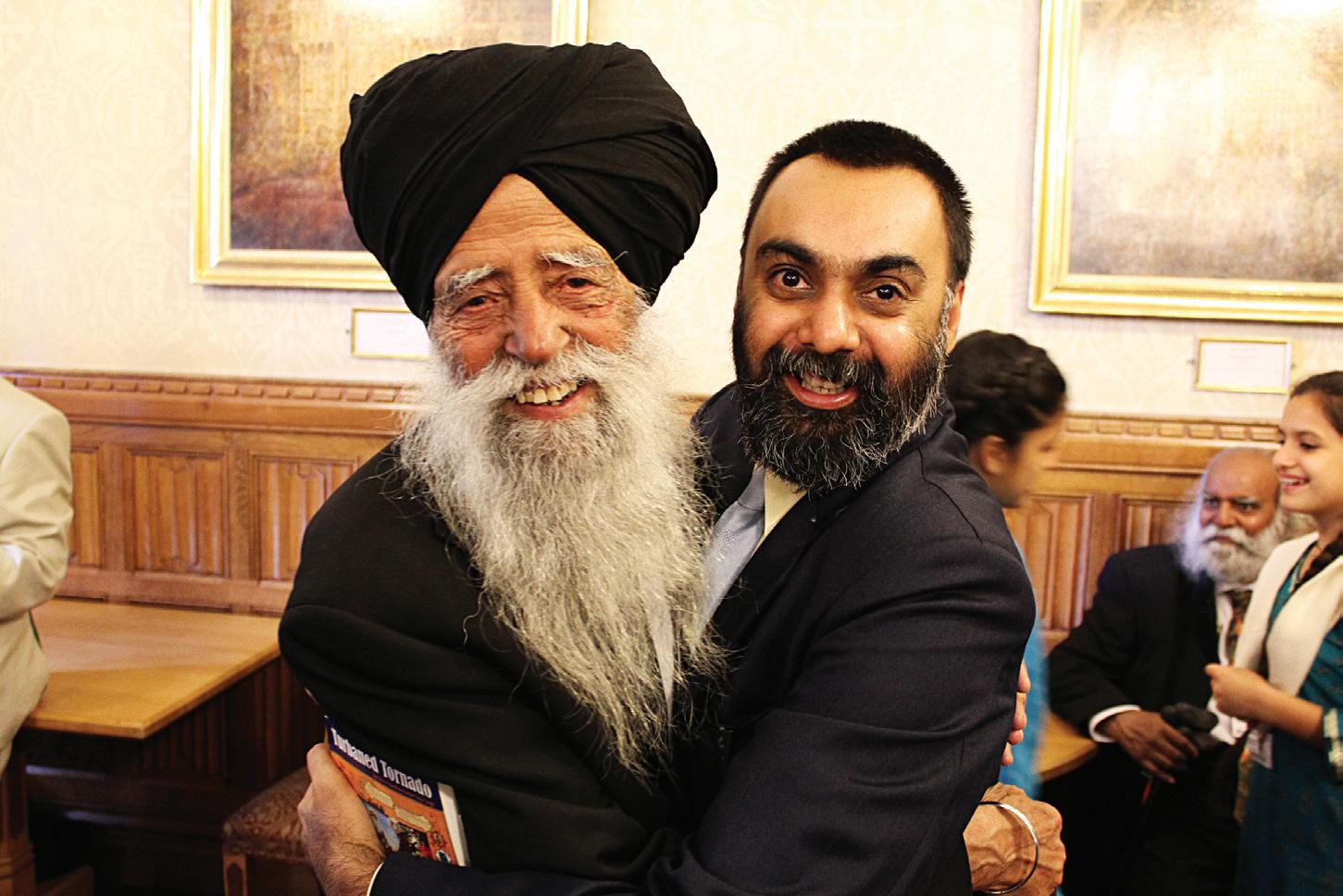
The book’s cover shows a smiling Fauja Singh running in his flowing white beard.
Mumbai textile worker now ‘best’ farmer in Ghana
Former Mumbai textile worker Harchavari Singh Cheema, who came to Ghana 40 years ago, is today a celebrated farmer and one of the most successful Indians in the west African country.

From an initial export of about 70 tonnes a year, today Cheema’s Param Farms exports 120 tonnes of vegetables a year. Ghana, a country of 24 million people, is known the world over for cocoa exports.
a manager for the then Glamour Stores - a supermarket chain - but some years later, the country’s economy started to go down and this affected the textile industry and I had to leave the chain to do something on my own,” Cheema, 64, said in an interview.
Cheema, who hails from Amritsar in Punjab, said: “I initially started a poultry farm at Gomoa Pamfokrom in the Central Region. I used to grow maize to use as feed.”
Unfortunately, the poultry sector also started having problems, so he started a small textile manufacturing unit in Accra, Ghana’s capital. “But this also suffered a lot because of the trade liberation that the government initiated in the 1980s.”
“Coming from a farming background, I had no choice but to get back to farming again. I decided to produce 25 different varieties of Asian vegetables for export to Europe,” he added.
He has been awarded by two presidentsas the Best National Farmer in the vegetable sector in 2006 and the Best National Farmer award in the food crop sector in 2004.
From a small farm in Weija in Accra, he moved to other areas outside Accra, including Bawjiase in the Central Region, Akatsi in the Volta Region, Old Akrade and Nsawam in the Eastern Region.
“The idea to spread was necessary because we did not want to become victims of the weather. Therefore, the spread of the farms enabled us to succeed even when the weather failed in other areas,” Cheema said.
Asked why he chose to remain in the country when Glamour Stores went down, he said: “Ghana is a nice place to live and my children were attending school which I did not want to disturb by returning back to India.”
and if you do a good job, pay your workers proper wages and meet your tax obligations, you would never encounter any problem.”
He said because of his success in Ghana other Indian investors looking for opportunities had sought his assistance to establish businesses here.
Cheema and a group of investors are in the process of establishing a packaging company at Tema, near Accra.
Why can’t India feed its people, asks Canadian media
In this Year of India in Canada, India is making news in the media here - not for the second highest growth rate in the world but for its “absolute poverty” and failure to “feed its people”.
The Canadian media has also likened “the boom in Bihar” to “a whimper”.
Writing under the headline ‘Why India can’t feed its people’, the country’s biggest daily Toronto Star reported from New Delhi, Sunday, “Food is an allconsuming crisis here. Waste is only one facet. Agriculture, infrastructure, inflation, innovation and corruption are others. It is a scourge and challenge for this country of 1.2 billion people...”
According to it, “40 percent of Indian children remain chronically malnourished” with this figure in some parts of India even higher than some sub-Saharan countries.
Citing reports of hungry children eating mud in parts of Uttar Pradesh, the newspaper story said, “Today, there is less food available for each Indian resident than there was 30 years ago. In 2008, the most recent year for which statistics are available, India produced 436 grams of food grains per person per day, a drop from 445.3 gms in 2006.”
The report said, “As much as 40 percent of all the fruits, vegetables and food grains grown in India never make it to the market. The country wastes more grain each year than Australia produces, and more fruits and vegetables than the UK consumes.”
Blaming the lack of R&D for the crisis in the Indian agriculture sector which has led to 200,000 suicides since 1997, the report said, “While China pumps $3.5 billion into agricultural research - Chinese farmers grew 6.2 metric tonnes of rice per hectare in 2008, double India’s output - India spends a fraction of that.”
In another story from Dharampur Mushahar Toll in Bihar, the national daily Globe and Mail reported Sunday that “the boom in Bihar sounds more like a whimper”.
Bihar, which has the lowest literacy rate, the highest child-mortality rate and the lowest life expectancy in India, has become a synonym not for intractable despair, but for turnaround under a new reformist government led by “a pot-bellied, teetotalling socialist engineer named Nitish Kumar”, the report said.
But “to travel in Bihar - in the rural areas or in the capital, Patna, where the streets are choked with garbage and the lights flicker out every couple of hours - is to see both how the place has changed, and how terribly far it has to go. And it is in this, more than anything else, that Bihar is emblematic of India - of its dark side of absolute poverty and exclusion, and how very difficult a task it is to change them”, the report said.
UAE keen to open consulate in Kerala
The United Arab Emirates (UAE) is looking forward to setting up a consulate in Kerala within the next one year, the UAE’s ambassador said recently.
Ambassador Mohammed Sultan Abdullah Al-Owais, who called on Chief Minister Oomen Chandy at his office here, gave him an official letter to this effect.
Chandy later told reporters that since the final decision will be taken by the central government, he cannot make a formal announcement.
“Since this is a diplomatic issue, I am not competent to make this announcement. Let the announcement come through the proper channel,” said Chandy.
Besides its embassy in New Delhi, the UAE has a consulate in Mumbai.
Al-Owais also told Chandy that investors from the UAE are keen to invest in the state.
“We are very keen for this because the state wants investment,” said state Industries Minister P.K. Kunhalikutty, who took part in discussions with the ambassador.
K.C. Joseph, state minister for nonresident Keralites, brought up the issue of fraudulent job visas.
“We have brought to the attention of the ambassador the numerous complaints of fake job visas, where innocent people from the state are being cheated. He has assured that this issue will be seriously looked into,” Joseph said.
The ambassador also put forward a request to Chandy to increase the frequency of flights operating from the UAE to Kerala.
According to a government study, over a million Keralites are working in the UAE.
Court allows extradition of NRI fugitive to US
The Delhi High Court Friday paved the way for non-resident Indian (NRI) fugitive Avtar Singh Grewal’s extradition to the US to face trial for allegedly killing his estranged wife in 2007.
The court dismissed his petition challenging a trial court’s decision to allow his extradition.
The division bench of Justice B.D. Ahmed and Justice Manmohan Singh said: “We find no infirmity or illegality in the order passed by the ACMM (additional chief metropolitan magistrate).”
Grewal, 37, challenged a trial court’s inquiry report which held that there was prima facie sufficient evidence for his extradition to the US.
The bench said: “We may also point out that we are not sitting in appeal over the report. The petitioner has invoked our extraordinary writ jurisdiction and, in doing so, we do not have to examine as to whether the inquiry order is right or wrong, but we have to examine whether the same are legal or illegal and whether the procedure prescribed in the Extradition Act, as also in the said treaty, have been followed or not.”
“We have already pointed out that we find no illegality in the order and we are of the view that the procedure has been correctly followed,” the bench said in its 24-page order.
“In view of the foregoing discussion, the writ petition has no merit and the same is dismissed,” said Justice Ahmed.
The fugitive, then working as manager with a firm at Vancouver in Canada, allegedly travelled to Phoenix in the US to meet his estranged wife Navneet Kaur and flew out of that country on a one-way ticket after killing her March 29, 2007.
“Once it is clear, prima facie, that the offence for which the petitioner has been charged constitutes murder under the Indian law, there is no question of invoking article 8 of the Extradition Treaty requiring the government of India to refuse extradition,” said the bench.
The court allowed the plea of A.K. Vali and Naveen K. Matta, special prosecutors of the external affairs ministry, that the offence allegedly committed by the fugitive was an extraditable crime.
Grewal was arrested on arrival at Delhi airport March 31, 2007 following an alert sounded by the Interpol.
JULY (2) 2011 <> 29 NATIONAL EDITION www.indianlink.com.au
Former Ghana president Jerry John Rawlings (in the green attire) being assisted to present Harchavari Singh Cheema (middle) the Best National Farmer Award
Sikh marathoner Fauja Singh gives a warm hug to his biographer Khushwant Singh at the launch of the book ‘Turbaned Tornado’ at the Attlee Room of House of Lords in London.
Photo: Jasvinder Singh Nagra
Photo: IANS
Terror, N-deal high on Clinton’s agenda
US Secretary of State Hillary Clinton is visiting India on a three-day visit during which the two countries will hold their second strategic dialogue to expand counterterror cooperation and seek to expedite implementation of their landmark civil nuclear deal.
Clinton, who is coming to India for the second time as President Barack Obama’s Secretary of State, was warmly received at the airport by Foreign Secretary Nirupama Rao, India’s ambassador to the US Meera Shankar and senior officials.

She co-chaired the second strategic dialogue with External Affairs Minister S.M. Krishna Tuesday before heading to Chennai, India’s southern city which has become a hub for American investment.
She will also call on Prime Minister Manmohan Singh and meet Congress president Sonia Gandhi.
Clinton’s visit takes place barely a week after the triple bombings in Mumbai that killed 19 people and injured over 130. Unlike on earlier such occasions, India has eschewed pointing finger at elements from Pakistan linking them to the blasts. However, terror networks that are active in Pakistan are expected to figure in the discussions.
At the second strategic dialogue Tuesday, India and the US will discuss an entire gamut of issues including strategic cooperation, counter-terrorism, energy and climate change, education, science and technology, health and defence, officials said.
India and the US are likely to sign key pacts in the areas of cyber security and civil aviation after the talks, said sources.
“The depth of the US-India Strategic Dialogue demonstrates the United States’ strong support for India as an important actor on the world stage,” a statement from Clinton’s office said before the visit which is expected to expand the US’ trade ties with India, a $1.6 trillion economy which has fared well in the aftermath of global recession.
With the July 13 Mumbai blasts putting the focus on increased security cooperation, India is likely to seek from the US assistance in probing the bombings. It’s not yet clear what kind of cooperation India may want from the US on this.
Top US counter-terrorism officials, including US Director of National Intelligence James R. Clapper and Deputy Secretary at the Department of Homeland Security Jane Holl Lute are among those accompanying Clinton to India.
The Indian delegation, headed by Krishna, would include Planning Commission Deputy Chairman Montek Singh Ahluwalia, Adviser to the Prime Minister Sam Pitroda, Foreign Secretary Nirupama Rao, Foreign Secretary-designate Ranjan Mathai, the secretaries of home, commerce and environment ministries. Nehchal Sandhu, director, Intelligence Bureau, will also participate in the discussions.
Hazare writes to PM on fast from August 16
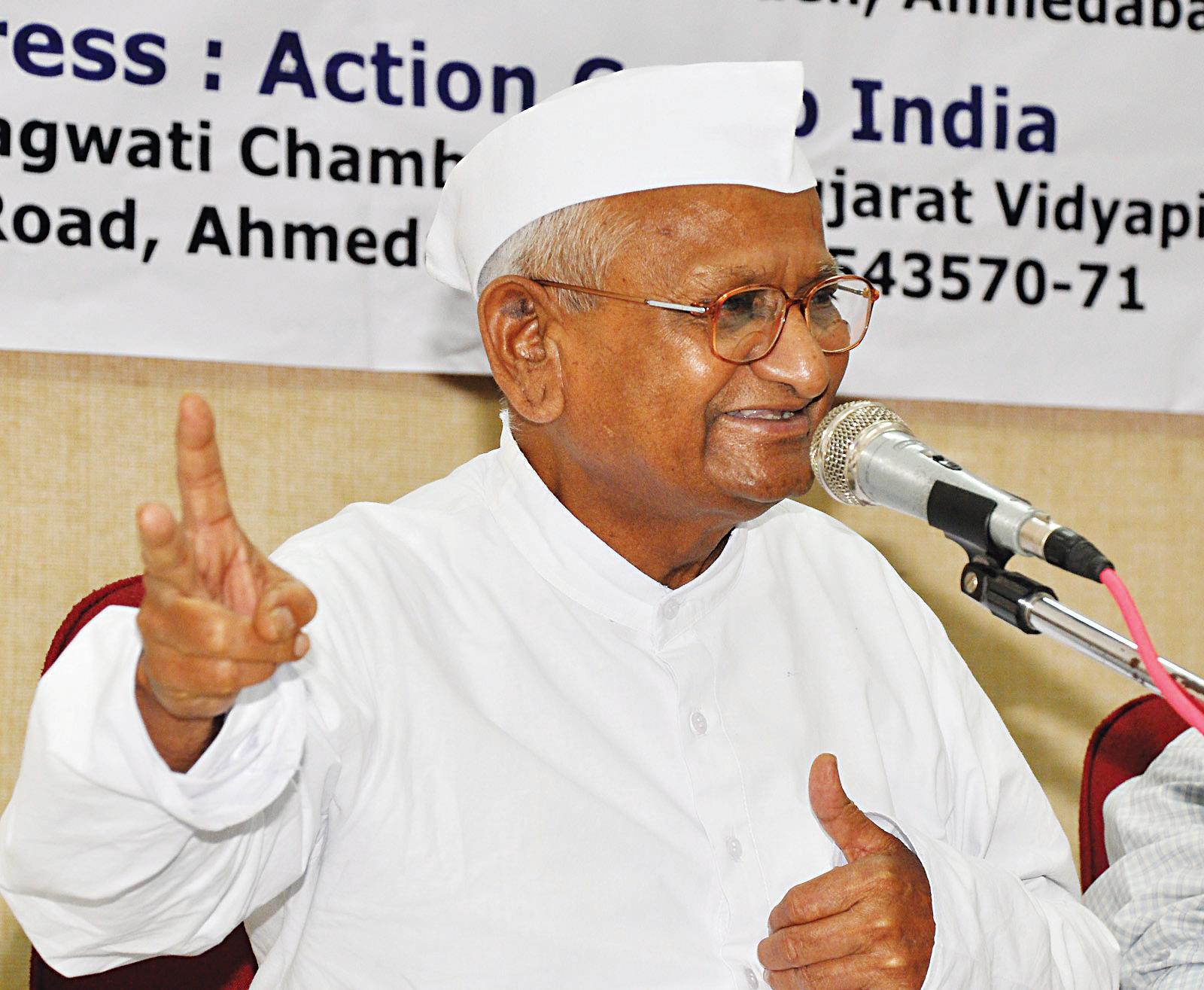
Social activist Anna Hazare said Monday he has written to Prime Minister Manmohan Singh informing him about his decision to go on an indefinite fast from August 16 if a strong anti-graft Lokpal bill is not brought in parliament.
“I have written to the prime minister
about our fast at Jantar Mantar from August 16. It is our constitutional right to protest, so when the government says that it will crush our andolan (agitation) like (yoga guru) Baba Ramdev’s, it is not right,” Hazare said at a press conference.
Calling upon the government to present the Jan Lokpal bill, drafted by civil society activists in parliament, Hazare said that if a strong bill is not introduced, he would not have any other option but to start his
indefinite fast.
“I hope the government will bring strong a bill in accordance with feelings of people,” he said.
He said the activists were willing to get arrested if prevented from going on the fast.
“We are ready to get arrested and be beaten up but we have had enough of corruption. We are ready to sacrifice our lives...that is what I have written to the prime minister,” he added.
The Congress, however, took potshots at Hazare and said that he should reply to comments of Justice P.B. Sawant panel about an organisation associated with him.
In his three-page letter to the prime minister, Hazare said that meetings of joint drafting panel had not yielded much and the civil society and government still continued to have two different drafts.
“The draft presented by five ministers of the joint drafting committee is a joke on people. Its mandate is so limited that it does not include corruption faced by the common man,” Hazare said.
He also referred to scams and scandals, including the 2G controversy.
Hazare said there was no need for the government to consult chief ministers on the bill. “You are throwing the ball at chief ministers and they are throwing it at you,” he said.
Rejecting the argument of the government that including all central government employees under the Lokpal bill’s purview would make it unwieldy.
He said that corruption was as serious a crime in the eyes of law as was rape or murder. “No government can say that we are incapable of ridding society of crime... your government will have to take strong steps to fight corruption and we are not ready for anything less,” he said.
Hazare said that some ministers and Congress party office bearers threatened that if he sat on fast from Aug 16, it would be crushed the way the agitation by Ramdev was.
“Such statements by senior office-bearers are unfortunate...peaceful demonstration is our right...but if your government crushes the agitation we are ready to face the situation. We are ready to court arrest, face batons. Our agitation will be peaceful,” he said.
Swami Agnivesh, a member of the Hazare team, sought to question Manmohan Singh’s
30 <> JULY (2) 2011 INDIAN LINK
U.S. Secretary of State Hillary Clinton with India’s Foreign Secretary Nirupama Rao on her arrival in New Delhi
Anna Hazare’s campaign against corruption continues
honesty, saying that he was elected to the Rajya Sabha after becoming a resident of Assam and renting accommodation in the house belonging to a former chief minister. He said the prime minister’s native state was Punjab. He said that people of Assam wanted bringing the prime minister under the Lokpal.
Congress spokesperson Manish Tewari took pot shots at Hazare and said he should reply to comments by Justice Sawant panel about an organisation associated with him.
Tewari said Justice Sawant committee raised some questions about Hazare’s organisation. However, he did not name the organisation.
“People who preach morality to the country need to see their face in the mirror... When morality is preached and when a probe panel raises questions then a reply must be given,” Tewari said.
Sources said Justice Sawant committee had listed improprieties in the running of Hind Swaraj Trust founded by Hazare.
The Sawant committee was set up by the Maharashtra government to probe Hazare’s allegations of corruption against four state ministers, but one of the ministers had made counter allegations against the social activist.
Hazare has said that the government should institute an inquiry against his trusts if it found these were corrupt.
Flood alert in Assam, 75,000 displaced
The Assam government Tuesday sounded an alert as 75,000 people were displaced following heavy overnight rains that triggered flash floods, breaching roads and embankments at several places.
“So far more than 75,000 people have been displaced and they are taking shelters in various makeshift camps,” a government spokesperson said.
Up to 800 villages in four districtsLakhimpur, Dhemaji, Sonitpur and Jorhathave been hit by the floods so far, he said.
“We have alerted all agencies. Relief materials and medical teams have also been rushed to the affected areas,” the official said.
A Central Water Commission bulletin said the Brahmaputra river and its tributaries were flowing above the danger mark in at least eight places.
An estimated 50,000 people are now displaced in Lakhimpur and Dhemaji, about 400 km east of Assam’s capital here.
“Most of the flood-hit people are now taking shelter in raised platforms, on railway tracks, and in government schools and offices, so far untouched by the floods,” he said.
The river island of Majuli in Jorhat district had a breach in a mud embankment late Monday, leaving thousands of people stranded.
Gushing waters have breached at least four vital mud embankments in the state, besides snapping road links. National Highway 52 in eastern Assam has been severely affected.
A vast stretch of the Kaziranga National Park has come under water, forcing forest guards to move out of the sanctuary and making animals run for their safety.
“The situation is worrisome and we are concerned about the safety of the animals and our forest guards,” a park official said.
New Darjeeling hill council given extensive powers
The Gorkhaland Territorial Administration (GTA), an autonomous hill council the decks for which was cleared Monday with the signing of the Darjeeling tripartite accord, will have extensive functional powers ranging from
the development of industry, tourism, education, healthcare to water supply, construction of roads and cultural preservation in the Darjeeling hills.
The tripartite agreement was signed Monday between the Gorkha Janamukti Morcha (GJM) and the West Bengal and central governments.
At the core of the agreement is the formation of a new autonomous elected Hill Council Gorkha Territorial Administration (GTA), which is armed with more powers compared to its predecessor Darjeeling Gorkha Hill Council (DGHC) formed in the late 1980s.
“The subject… covers the entire range of development from agriculture, industries, irrigation, food, education, water resources, culture, municipalities, land and land revenue, panchyats, public health, sport, tourism, urban development.
“Everything that concerns the people of this area has been given,” Union Home Minister P. Chidambaram said while addressing the tripartite agreement program.
West Bengal Chief Minister Mamata Banerjee said it is a complete economic package for the overall development of the hills.
“The new body will work with this economic package. The GTA will work for the construction and development of comprehensive water supply system in their authority area,” she said.
Besides, the GTA would be empowered to establish multi super speciality hospital and medical college, tourism institutes and cultural heritage institute.
It would also undertake research and development of Nepali language, mini and micro hydro projects, setting up of veterinary hospitals, construction of roads, ropeways besides founding colleges.
“They will also establish a Gorkha house in New Delhi. They will also establish research and development institute for tea, horticulture and floriculture, They will also construct polytechnic college,” said Banerjee.
Banerjee said the election for GTA - that would be formed by passing an act in the assembly - would be held within six months.
Offices of the School Service Commission and College Service Commission will also be set up in Darjeeling district as part of the agreement.
The GTA will also get a special financial package from the central government, while a nine-member high-powered committee, comprising four members each from the GJM and the state government and one from the central government, will be formed to study the GJM’s demand on demarcating Gorkha majority areas in the Terai (plains of Darjeeling) and Dooars (foothills of the Himalayas) for inclusion in the council.
The committee is scheduled to give its report in six months.
The new council would be formed through enactment of a law in the state assembly, and have administrative and financial powers besides being equipped to frame rules related to the hills. But the body would not have legislative powers.
Raj Thackeray again attacks north Indian migrants
For the second time in five days, Maharashtra Navnirman Sena chief Raj Thackeray Monday targeted north Indians and the migrant population and demanded a check on their influx into Mumbai.
“People from Uttar Pradesh and Bihar are involved in nearly 70-80 percent of all crimes committed in the city,” Raj Thackeray alleged at a press conference here. Daily 48 trains come here from those two states alone, he added.
From the security point of view, he
demanded that the authorities should pay
“In case anybody is found involved in any crime or guilty, then police and government must punish them. But without any evidence, it is not right on the part of Raj Thackeray to brand all people from UPBihar as criminals and spoil their image,” he said.
A day after the triple blasts in Mumbai last Wednesday, Thackeray had blamed the north Indians and migrant population for the terror attack which left 19 dead and 129 injured so far.
Lokayukta slams Delhi chief minister Delhi Lokayukta (ombudsman) Manmohan
Sarin Monday came down heavily on Chief Minister Sheila Dikshit, saying she misrepresented facts about the completion of 60,000 low-cost flats ahead of distribution in the run-up to the 2008 assembly elections. The Lokayukta has recommended President Pratibha Patil to censure her.
In his order, the Lokayukta urged the people to stand up against unethical practices and build strong public opinion to ensure that public functionaries adhere to “high standards of integrity and conduct”.
Dikshit refused to comment on the order. She said distribution of flats was a complex process and that the government was not trying to mislead anybody.
The Lokayukta alleged that despite knowing that 60,000 flats were not ready, Dikshit made the announcement to gain or favour to herself or her political party ahead of the elections. This is the second time this year that the Lokayukta has passed a strong order against a state government functionary.
In March, Justice Sarin recommended to the president to withdraw her “pleasure” in allowing Public Works Department (PWD) Minister Raj Kumar Chauhan to continue in the Delhi government for his alleged involvement in protecting a leading resort in a tax evasion case. The suggestion was rejected by the president.
Bedi wants to get Jammu and Kashmir closer through cricket
Former India captain Bishan Singh Bedi says apart from motivating cricketers in the state of Jammu and Kashmir, he would like to see the two regions get closer.
Bedi, whom the Jammu and Kashmir Cricket Association (JKCA) Sunday appointed the coach for three years, is allergic to the word “coach” and has always insisted that he is only a motivator.
“My job is to make the J&K players feel that they can compete with any other state team, they must stop thinking of just participating in the national championship,”
Bedi said on return to Delhi from Srinagar recently.
Some two decades ago, Bedi egged on the Punjab cricket team to win the Ranji Trophy and he did it in less than three years of taking over the reins of the side. A decade ago, he was with the Delhi team for a couple of seasons which, however, did not work out all that well.
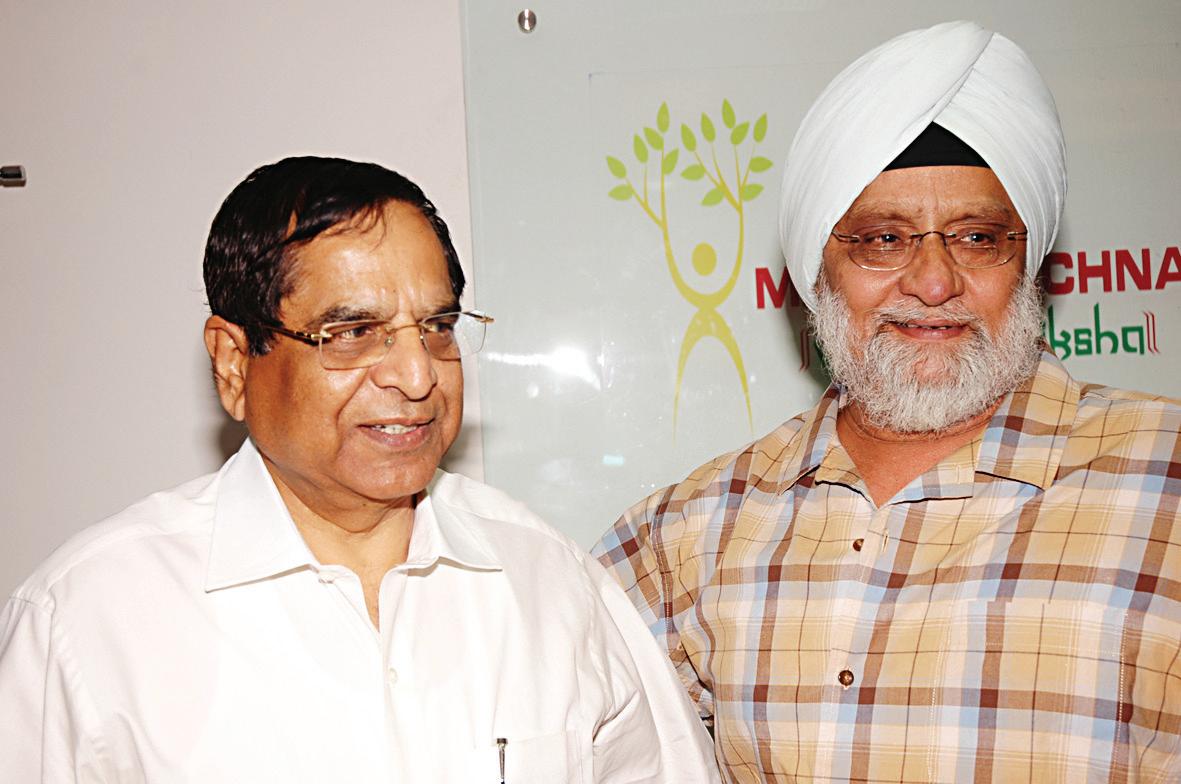
“My job would essentially be to provide the boys a direction and the right kind of exposure. What I could gather in the couple of days I spent before accepting the offer was that the JKCA officials and players are keen that they made a mark at the national level instead of just drifting along year after year,” said Bedi.
Bedi is clear in his mind that he has to provide the road map for the young cricketers who all look highly motivated and eager to learn how to go about it. For starters he wants the boys to realise that they can move up the ladder, from the Plate Division to Elite Group.
“I have to deliver before I ask boys to deliver. My immediate task is to move them from the Plate to Elite Division. I have to change their mindset, that they are not merely participating in an event but they are competing to get better.”
First things first, Bishan says, the facilities at the Sher-e-Kashmir Stadium are pretty good and he was pleased with the basic infrastructure.
“In my interaction with the officials and the ground staff, I found that they have a clear idea of the basic requirements. The pitch is good with an even bounce and the ball had a decent carry to wicketkeeper waist-high. I am pleased with their work.”
Bedi realises the enormous responsibility on his shoulders and he has started looking for a support staff, good professionals to assist him. He might go in for two assistant coaches, a trainer and a physio.
He will also have a free hand in selection of the team, co-ordinating with chief selector Abdul Rauf, a feared fast bowler of his time.
“I have three months from August 1 to prepare the Ranji Trophy team, though the junior events start in October. Just as the Punjab boys responded, I expect the boys here too will respond to me. They are all well built and physically fit. Remember, it is going to be the Jammu-kashmir team so I will scout for good players from both the regions,” said Bedi who played 67 Tests, claiming 266 wickets, and 10 One-Day Internationals.
JULY (2) 2011 <> 31 NATIONAL EDITION
IANS
India’s spin legend Bishan Singh Bedi
Are you suffering from any of the following problem: HEALTH FAMILY MARRIAGE WORK BUSINESS EMPLOYMENT HUSBAND & WIFE RELATIONSHIP PROPERTY COURT CHILDREN PROMOTION ETC
SRI SHIRDI SAI
ASTROlOGY CENTER
World Famous Astrologer from Indian Generations
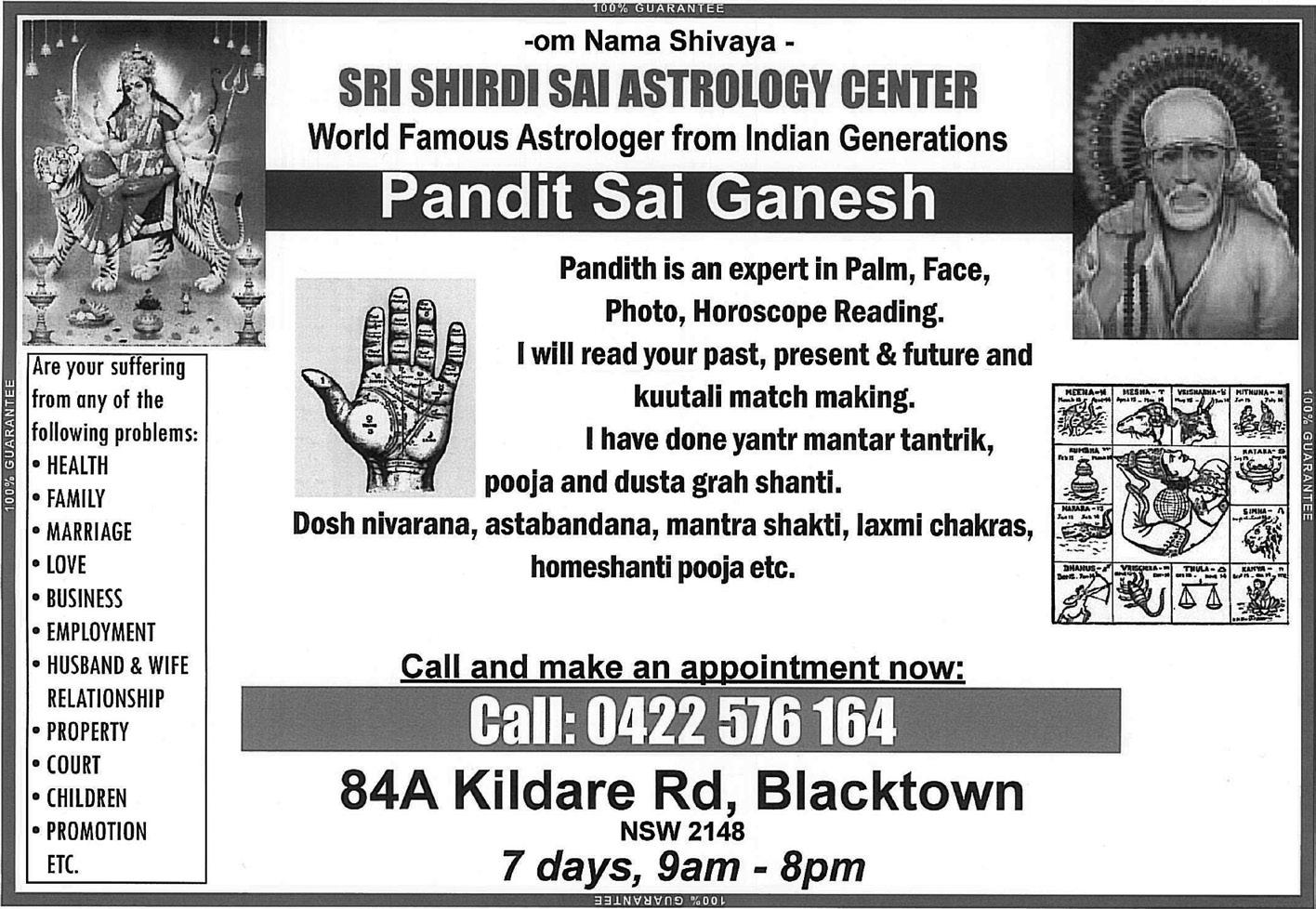


Pandit Sai Ganesh
Pandith is an expert in Palm, Face, Photo, Horoscope Reading. I will read your past, present & future and Kuutali match making.
I have done yantr mantar tantrik, pooja and dusta grah shanti. Dosh nivarana, astabandana, mantra shakti, laxmi chakras, homeshanti pooja etc.
Appointment now: Call: 0422 576 164 0412 350382
Email: adipavankalyan@gmail.com
84A Kildare Rd, Blacktown NSW 2148

7 days, 9am - 8pm
Indian chef Required
Vibrant new Indian restaurant in Bathurst requires hard-working and self-motivated Indian chef Get out of the city chaos, and enjoy a positive work environment, and showcase your superior culinary, leadership and organisational talents. Immediate start, full-time with award wages so apply right now. Must be experienced in North Indian/Tandoori dishes, and entrees. Located in Bathurst, NSW - 2 hours drive from Sydney. Only PR or Citizens need apply No student or work visa holders please.
DEHSABZI LAWYERS

Do you need legal assistance?
Criminal Law: Speeding, Drink Driving, AVO, Assaults. Compensation: Workers, Motor vehicle accidents.
Business: Purchase and sale of Business.
Property: Conveyance, mortgages, leases.
We also speak Hindi, Punjabi, Gujarati, Urdu, Farsi, Dari, Pashto, Tamil and Spanish. Solicitors & Consultants: Sayar Dehsabzi, Siddique Panwala, Dr. Jyoti
Family Law: Child custody, Divorce and Property settlement. Migration: MRT, RRT, and Federal Court work. Call us now for first free consultation: P - 9635 5566 • M – 0419 492 478 Suite 5, Level 4 – 91 George St PARRAMATTA NSW 2151 www.dehsabzilawyers.com.au
32 <> JULY (2) 2011 INDIAN LINK
resume to
Email
saffron_cuisine@yahoo.com
Bharti and Cesar Montenegro Migration Agent: Jay Hosur We YourDefend Rights

JULY (2) 2011 <> 33 NATIONAL EDITION



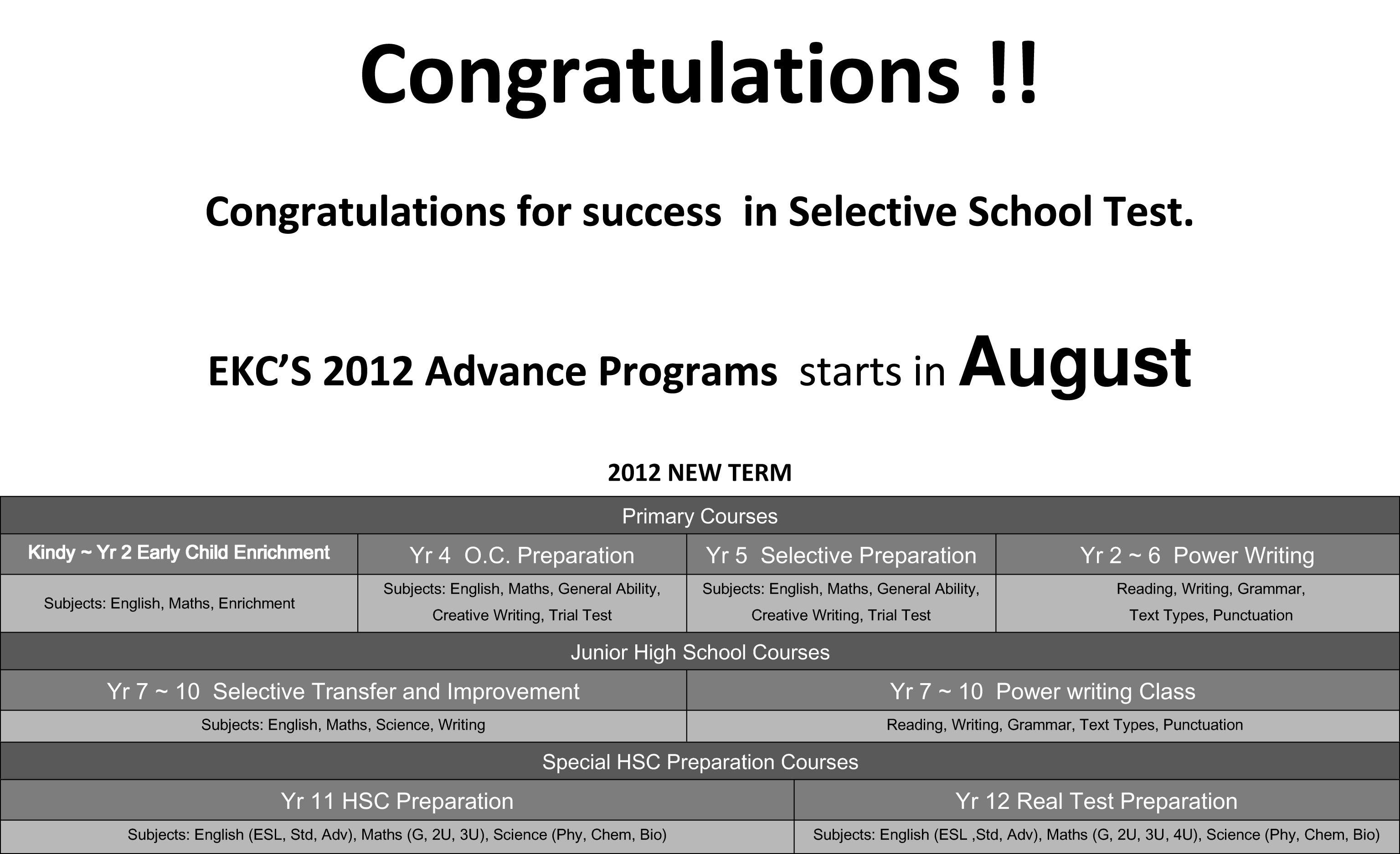




34 <> JULY (2) 2011 INDIAN LINK Commercial Cleaning Business’s Multi million dollars service industry Sydney area including Small/Big Offices, Schools, Starting price $15,600 2.5 years Contract guarantee Free equipment (Vacuum cleaners, Mob, Buckets……) Free Training (theory and Practical) Contact Sushil Gupta 02 9567 6388 Conditions apply Newly Opened. 482 Canterbury Rd Campsie Natural Gemstones, Crystal Quartz, Freshwater Pearls, Sterling Silver, Metallic Accessories, Leather Strings Ready made Necklaces, Bracelets, Earrings, Rings, Pendants, Brooches Jewellery Making / Remodelling Available Open 7 Days. 9:30am – 6pm. Ph: 0297878603 • JAY – 0416130688 Email: jjn688@gmail.com Retail/Wholesale Welcome



JULY (2) 2011 <> 35 NATIONAL EDITION For expert coaching in Lowest Fee Guaranteed IELTS ENGLISH GURU Suite -1, 71 A Macquarie St, Parramatta, Phone 0411 520 546, 9687 9741 www.englishguru.com.au • Power Packed Sessions. • One and Two Weeks Crash Courses Available. • Money completely refundable, if not satisfied with the first tuition session.
BY PALLAVI SINGHAL
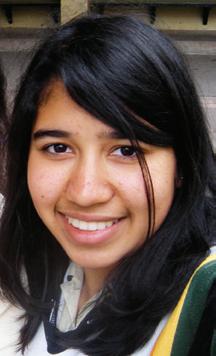

The lights start to dim and quaintly dressed witches and wizards armed with wands and quidditch sticks walk up and down the cinema aisle; it is 12:01am on 13th July, at the midnight screening of Harry Potter and the Deathly Hallows (Part Two). With Australia’s early release date, these are quite literally the first people in the world to watch the muchanticipated final instalment of the Harry Potter series.
The cliff-hanger ending of Part One left the audience half-way through Harry’s quest to destroy Lord Voldemort, the dark wizard who is slowly taking over the world with his Nazi-like policies to rid the world of Muggles (that is, non-magical folk). The latest film depicts the rest of this heroic quest, with the protagonists seeking to find and destroy parts of Voldemort’s soul in order to be able to kill the wizard himself.
Eye-catching
The panoramic shots of ice-capped mountains and crystal clear lakes set the scene for the whirlwind adventure. The breathtaking scenery is coupled with fantastic computer-generated imagery of majestic, mythical creatures, to truly bring J. K. Rowling’s magical world to life. The cinematography and special effects are a pleasure to watch.
As for the story itself, all the Harry Potter films have escaped the normally harsh criticism that accompanies film adaptations of popular books, and this one was no different. Yates creates a wonderful depiction of Rowling’s entire world, from the magnificent Hogwart’s caste to the strange Platform 9 ¾ and the maze-like Gringott’s bank. If anything, the magical world is even more impressive than ever before, with the castle becoming a fortress for the final battle, complete with precariously high towers, drawbridges and hidden rooms. The film manages to recreate every minute detail of the book, from the eerie hidden passageways to the Forbidden Forest,
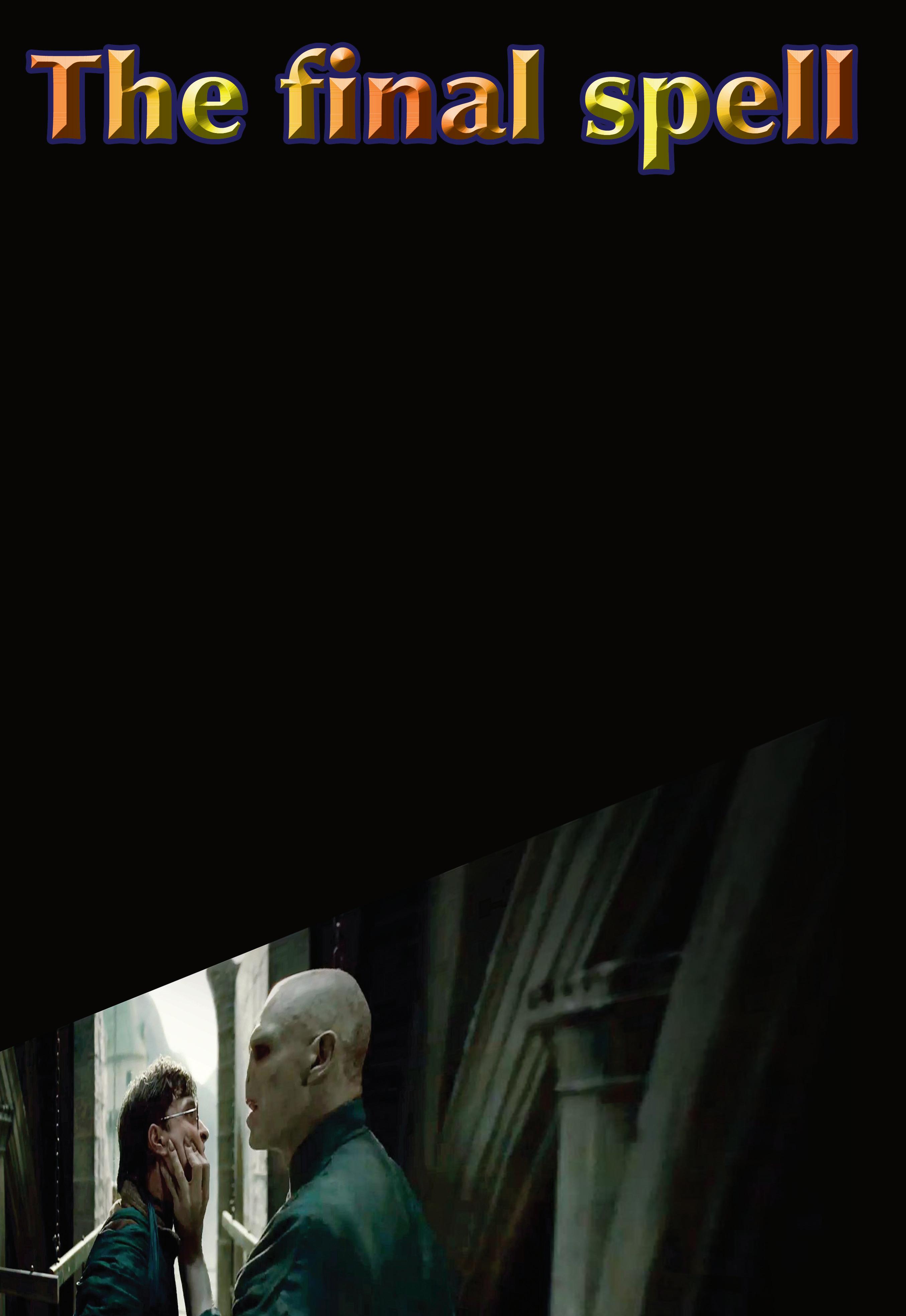
and even the dimension between life and death, which Rowling describes as a “cleaner” version of Kings Cross Station.

There isn’t a dull moment in the film as the three young characters keep finding themselves in near-death situations and facing the most dangerous witches and wizards in their world. They repeatedly face betrayal and have to confront their own loyalties and friendships as they discover the fine line between ally and foe, and the film keeps you guessing until the very end. The film’s darkness is offset by lighter moments of humour. The cast outperform themselves in this instalment – they are more talented, more intense, and funnier than ever before.
A thrilling ride
The film is an action-packed fantasy adventure and a coming-of-age story all at once. The never-ending plot twists maintain the fastpaced momentum of the film, until the final climax where all the subtle details and complicated chain of events come together to create the perfect ending to this epic series. The film’s only shortcoming is that the muchhyped final showdown does not contain as many explosions, noise or devastation as one may have anticipated.
The director, David Yates, has made a film similar in feel to the previous Deathly Hallows (Part One), with thrilling adventures interlaced with deeply moving moments capturing love and friendship. Yates faces the same dilemma as the previous directors of the book-turnedfilm series: the precarious line between catering for the rabid readers of the book who know everything about the storyline, and explaining the complicated plot-twists to those who haven’t read the books. He seems to have found the ideal balance, with the film successfully explaining the complex adventure plot without bludgeoning the audience with obvious points.
New dimension
The film’s 3D effects are surprisingly good, after the industry’s many uninspiring attempts at 3D technology over the past few years. There was an obvious attempt to bring the
entire world of magic out of its previous twodimensional form, with the effects running consistently throughout the film. The added grandeur to the splendid castles and colossal mountains, valleys and seas made the experience a little more magical. It added an extra punch to the fast-paced battle scenes, made the dragons, goblins and ghosts come to life, and brought a new poignancy to the film’s ending, as specks of ash curling in flames floated up and out of the screen.
The beginning of the film marks the end of an era. Millions of children all around the world have grown up eagerly awaiting the release of each new book, film, and their letter to Hogwarts. The first book, Harry Potter and the Philosopher’s Stone, was released in 1997, and its film rendition in 2001. Since then, six other books and films have been released, each even more successful than the last. Young children who went to watch that first film are almost adults with the release of the final film in 2011; the end of this franchise really does mark the end of their childhood for many. Not only have the books and films become a timeless tale, they also mean a lot more to many who were introduced to literature solely through Harry Potter. Book sales for the series went up astronomically after the release of each movie, and a new generation of book-lovers was created.
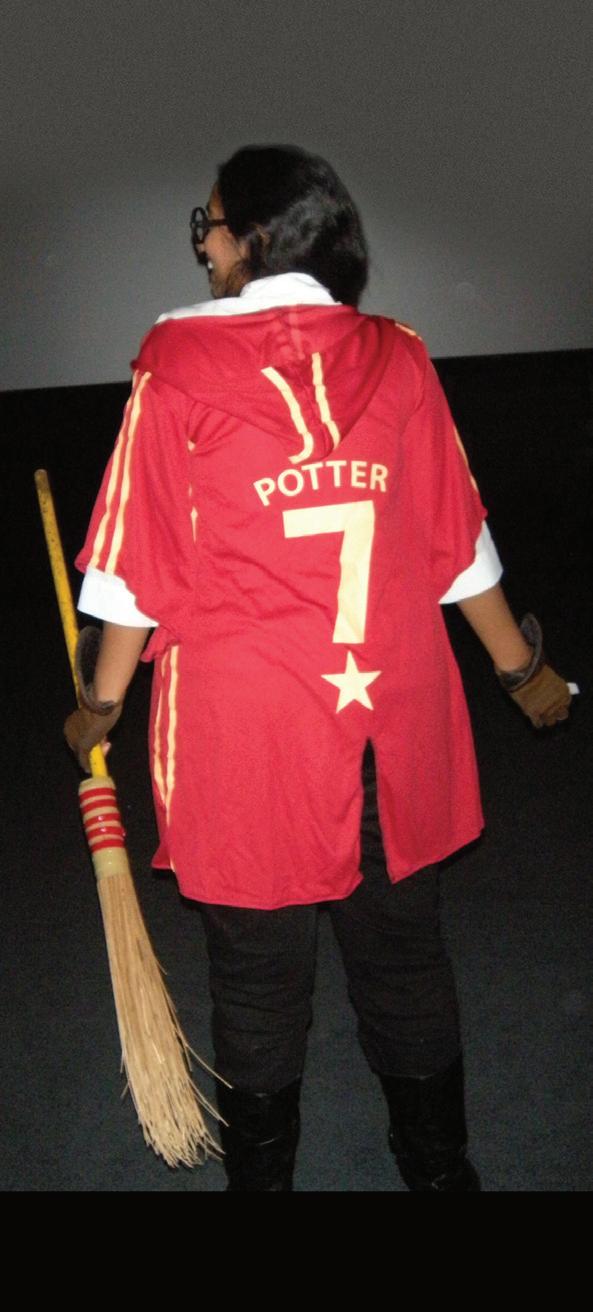
What makes the film different from the countless other children’s fantasies is that the lessons of love, friendship, and loyalty hold true for both young and old viewers alike. There is enough action to keep a younger audience entertained, but the film also contains a complex plot that is a delight to behold as it unravels. Its subtler aspects make it just as entertaining for more mature viewers.
The film’s surface messages upholding the immeasurable value of friendship are highly relevant for young viewers, but it goes beyond that to explore the nature of humanity through the challenges the characters face. Although it certainly promotes generic messages of love and tolerance, the film also delves into the fine line between good and evil, leaving the audience with the final message that your choices are what ultimately define you.
Harry Potter and the Deathly Hallows marks the end of an era; it’s a fitting final hurrah for legions of fans in love with J. K. Rowling’s delightful characters
I thought the film was quite well done. They made it as exciting as they could have - it was awash with dark tones, and there were plenty of climactic scenes.
Satvik Sekhar
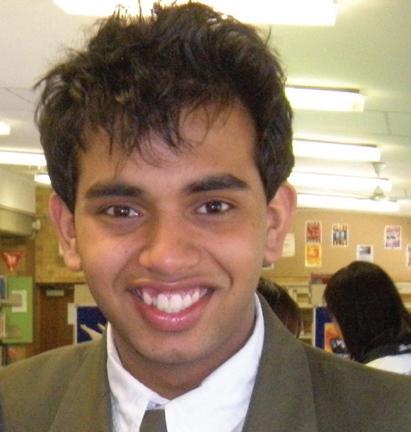
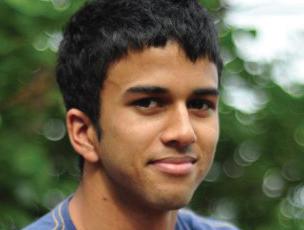
It was inspiring! It gives children hope that even at such a little age, they can make a difference in the world.
Juhi Agarwal
After the 8th movie I was struck with the shamefully melodramatic realisation that a 12-year journey that began with my first ride on the Hogwarts Express had ended - as the credits rolled up on the screen, it seemed as though the curtain had closed on my childhood.
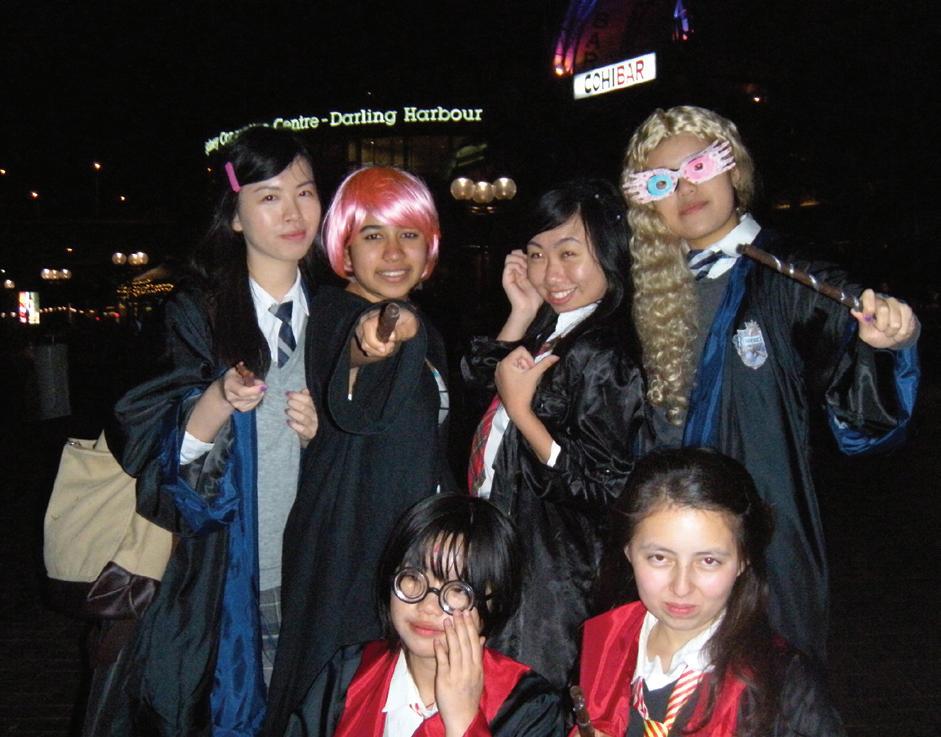 Ritam Mitra
Ritam Mitra
It was incredible and cool and I loved the character of Neville.
Shashank Singhal
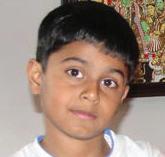

I thought it was the perfect way to end 10 years of magic.
Sasha Mathias
I really enjoyed the epic final, where Harry finally vanquishes the Dark Lord. It is action packed, humorous, exciting and of course a little scary, particularly Fenrir Greyback.
 Saarangan Arvind
Saarangan Arvind
Excellent movie; stunning finale to the series. Who was it who said “Expelliarmus” to JK Rowling? I’d like to vanquish him! And who was it who didn’t put Peeves in the movies? I’d like to say “Expelliarmus” to him….
Manan Luthra
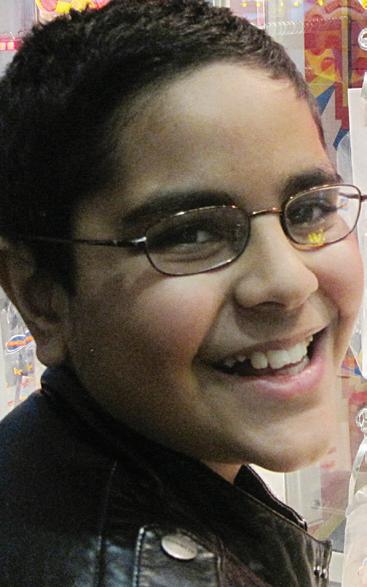
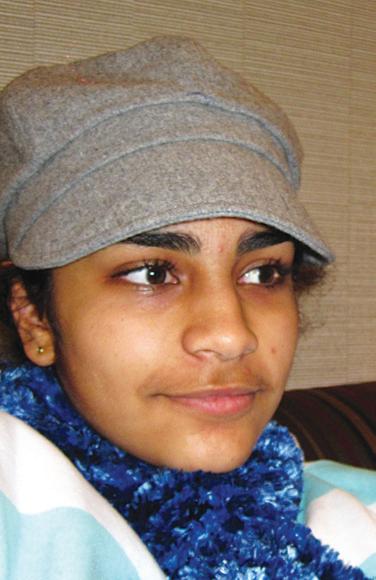 Varsha Srinivasan
Varsha Srinivasan
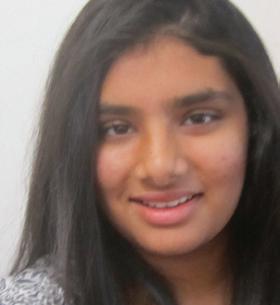
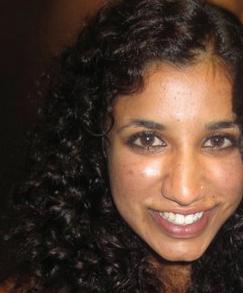

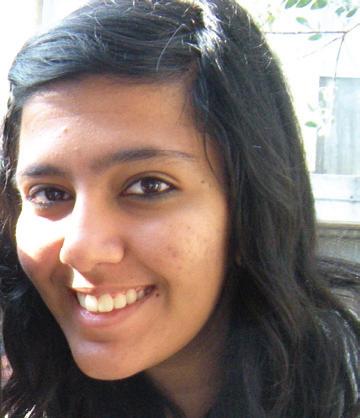

I really loved the final Harry Potter movie. Since the last book was distilled into two movies with the first one being the slower paced, groundwork-laying part, the second movie was able to be actionpacked and fast-paced while not compromising the emotional aspects of the story. Maybe because this was the last movie and I knew that, I was in a really nostalgic mood. I actually ‘prepared’ for this movie by re-reading the last two books and watching all the previous movies in the past 6 weeks. Cheesy, I know, but who cares, right? I am one of those people who rarely likes the movie over the book, but if I was to change my mind, this movie would be the one to do it. The mood at the theatre was fantastic! There were people dressed up everywhere. Surprisingly though, there were a lot more Rons, Hagrids and Bellatrixs than Harrys in the crowd.
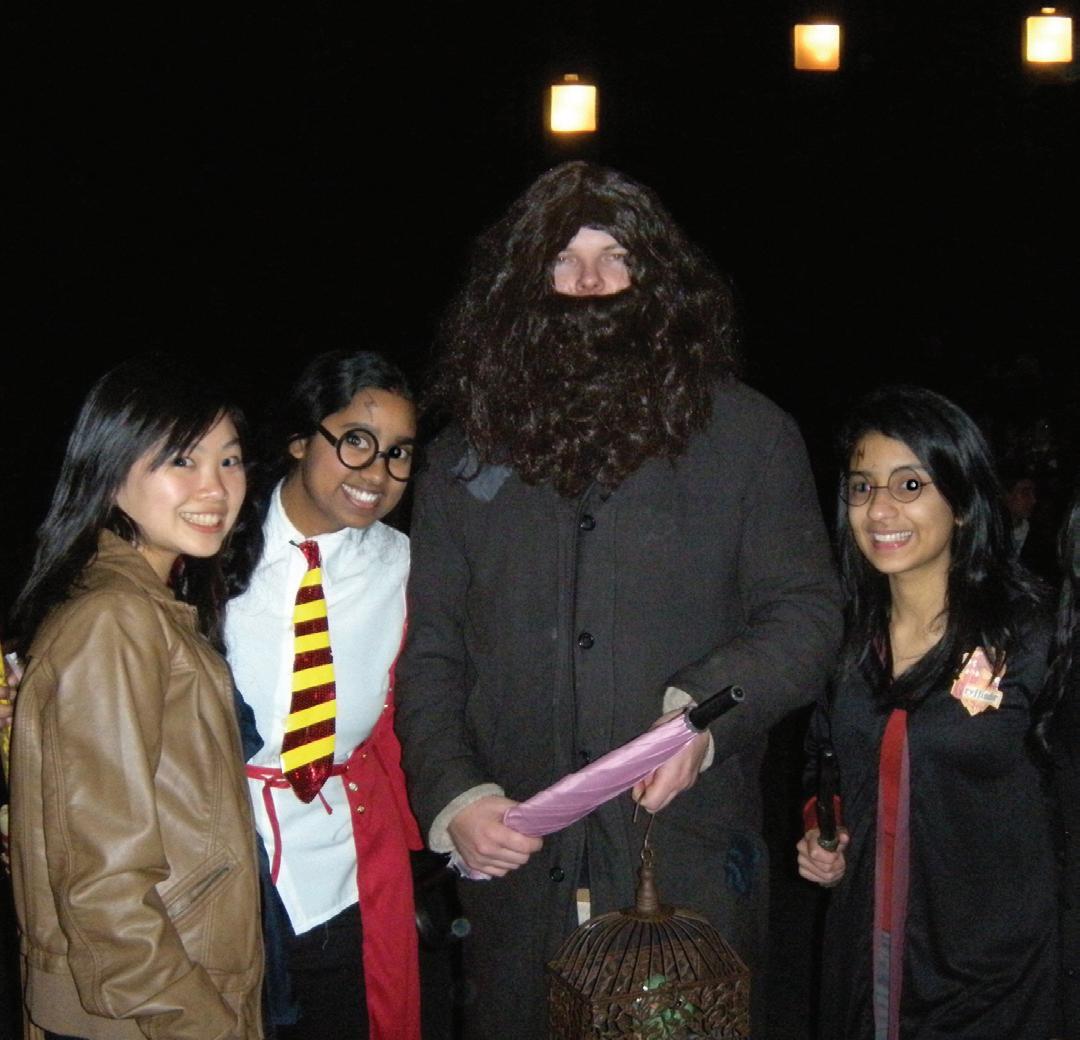
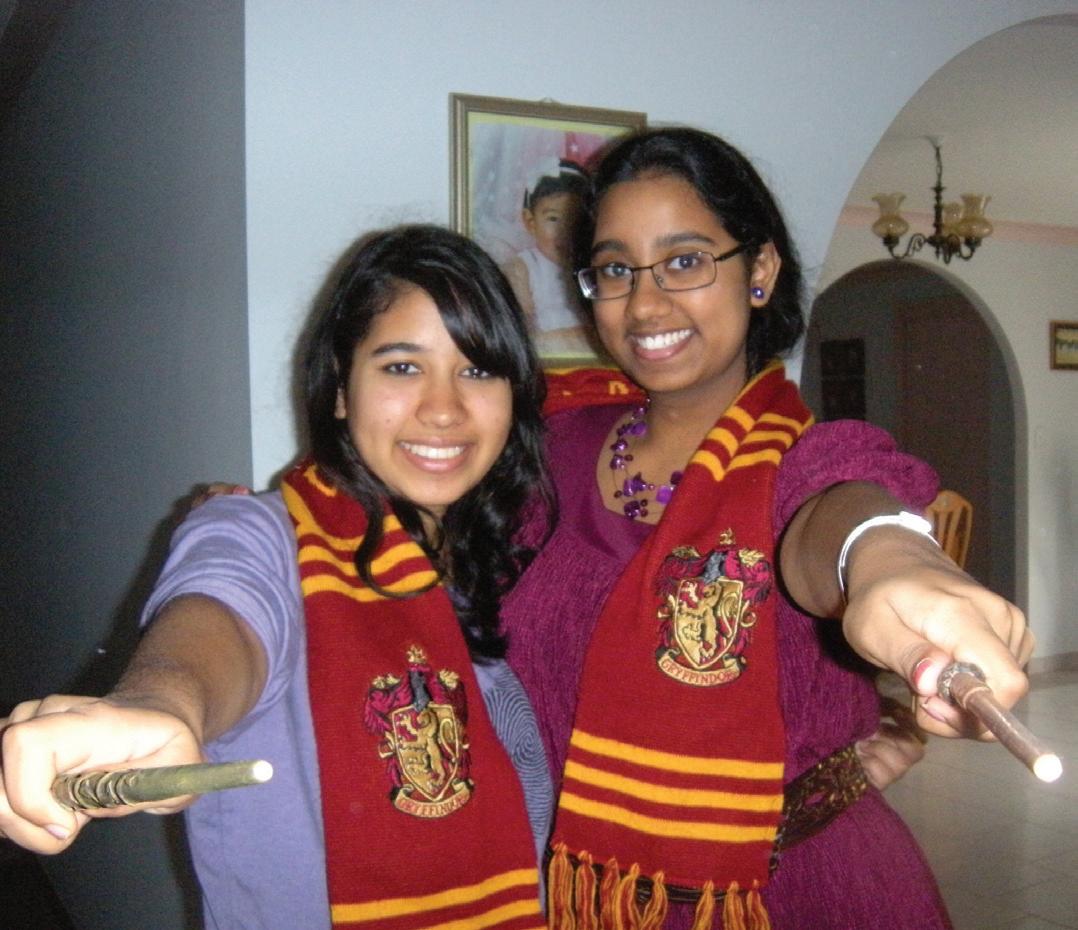 Noopur Singhal
Noopur Singhal
David Yates did a great job turning the book into a movie and how he kept some sections of the book exactly the same, I thought that was really important.
Sanduni Gunatilake
It was both happy and sad because we’ve grown up with it, and it hasn’t hit me yet that it’s over.
Jaspreet Dhillon


I thought it was a bit overdramatic in places, but Siriusly, I enjoyed every minute of it! Saw it a few hours ago and am still under the spell of it!!
Devna Luthra
While the film was not altogether faithful to the original storyline, the finale marked the close of the phenomenal saga with spellbinding action, emotion and drama.
Sudarshan Arvind

It is mind-blowing, visually dazzling, beautifully acted and just all over wonderful. What an amazing conclusion. The fight here between good and evil is more than satisfying - it’s thrilling.
Sarina Patel

A fantastic end that captures the scope and scale of a series that has defined my generation.
Tribal tribulations
Contentious issues still exist in the rural tribal community in both Australia and India, which need to be addressed
 BY NOEL G DE SOUZA
BY NOEL G DE SOUZA
In June this year, the Australian House of Representatives’ Standing Committee on Aboriginal and Torres Strait Islander Affairs released its report on Aboriginal crime entitled Doing Time. It is a severe indictment of Australian society. To quote: “It has been 20 years since the Royal Commission into Aboriginal Deaths in Custody Report and yet the incarceration rate of Indigenous Australians, including Indigenous youth, is worse now.….. This is a shameful state of affairs.”
Indigenous people (formed of numerous tribes) form 2.5% of Australia’s population, but its juveniles are 28 times more likely than others to be incarcerated. Despite programmes and policies to remove Aboriginal disadvantage, the results are yet to be seen.
In contrast to Aboriginal disadvantage, the land rights legislation enables Aboriginals to make land claims if they can prove continued occupancy. The process is slow and arduous, but where native title has been established, Aboriginals have legal clout to deal with other parties. Thus, significant revenue could be generated in future such as from mining companies in the Northern Territory.

The parallel with India is the condition of its tribal people. India’s tribals mostly live in isolated remote areas. The Indian Constitution, acknowledging the historical disadvantages that scheduled castes and tribes had undergone, reserved for them parliamentary seats and educational and job preferences. By doing this, India became a global trendsetter. But even though progress has since been made, it is insufficient to erase long-standing injustices.
Indians have for long accepted the western view that India is a dualistic nation, thereby meaning that it is made up of urban and rural zones. This fundamental error led to remote and forest areas inhabited by tribals, being ignored as a developmental zone requiring special attention.
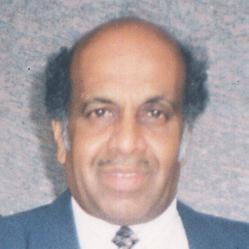
The Congress Party, following the lead of Mahatma Gandhi, believed in developing rural agricultural areas because that is where the bulk of India’s population lives. However, the very different tribal areas were included within that rural zone. When India was carved up along linguistic lines, the official language of the tribal areas was considered to be the language of the state into which the tribal areas fell.
In hindsight, the linguistic carving up of India was a hurried affair with scant regard for certain local requirements. As a consequence, we still see the demand for Telangana and
Vidarbha half-a-century later. In the case of tribal areas, it was as if by incorporating them into larger states that the problem would go away.
The first test of an erroneous tribal policy, or rather the lack of one, came in Assam. In this state, the language of its lowlands was considered as the language of the entire state which included the very different hilly tribal areas with different languages and cultures. The original state of Assam lay in a strategically sensitive area close to the then East Pakistan (now Bangladesh), Burma, China and Nepal.
The Naga insurgency led to the creation of Nagaland in 1963. This was followed by the creation of Meghalaya, initially as an autonomous sub-state within Assam, and later as a state in 1972. Nagaland and Meghalaya, neither having a developed language and not wanting Assamese, chose English as their state language. Much earlier, Arunachal (originally NEFA), a sensitive area bordering China, had already adopted English as its official language.
The demand for Gurkhaland in the hilly areas of West Bengal adjacent to Sikkim, lies in a similarly sensitive zone. Sikkim has no dominant language; its newspapers are in Nepali and English.
Moving into India’s heartland, two new states with substantial tribal populations (each around 30%) were created in 2000. Jharkand was carved out of Bihar and Chhattisgarh out of Madhya Pradesh. These new states also have large numbers of scheduled castes and other backward groups.
Neither of the new states were created for linguistic reasons. There are numerous local dialects, but Hindi and its variants like Chhattisgarhi are the main languages. Though backward, both these states have substantial natural resources by way of timber and minerals. Jharkand is very rich in minerals and has important mineral based industries such as iron and steel plants and thermal power stations. Chhattisgarh is also mineral-rich.
The main issue in these two states is the equitable spreading of the fruits of mineral and forest wealth amongst their various groups. Indian tribals have no title to natural resources. However, tribal and other backward groups have representation in the state legislatures and often hold ministries. Unfortunately, both these states are currently plagued by Naxal insurgencies, and tribals and other village dwellers get caught in-between the Naxals and law enforcement agencies.
It is essential that the gap be bridged between the developmental aspirations of historically disadvantaged groups such as Aboriginals in Australia and tribals in India, and the achievements of the mainstream.
38 <> JULY (2) 2011 INDIAN LINK
In contrast to Aboriginal disadvantage, the land rights legislation enables Aboriginals to make land claims if they can prove continued occupancy
www.indianlink.com.au OPINION
The Indian Constitution, acknowledgingthe historical disadvantages that scheduled castes and tribes had undergone, reserved for them parliamentary seats and educational and job preferences
Expectations from education
BY DILIP JADEJA
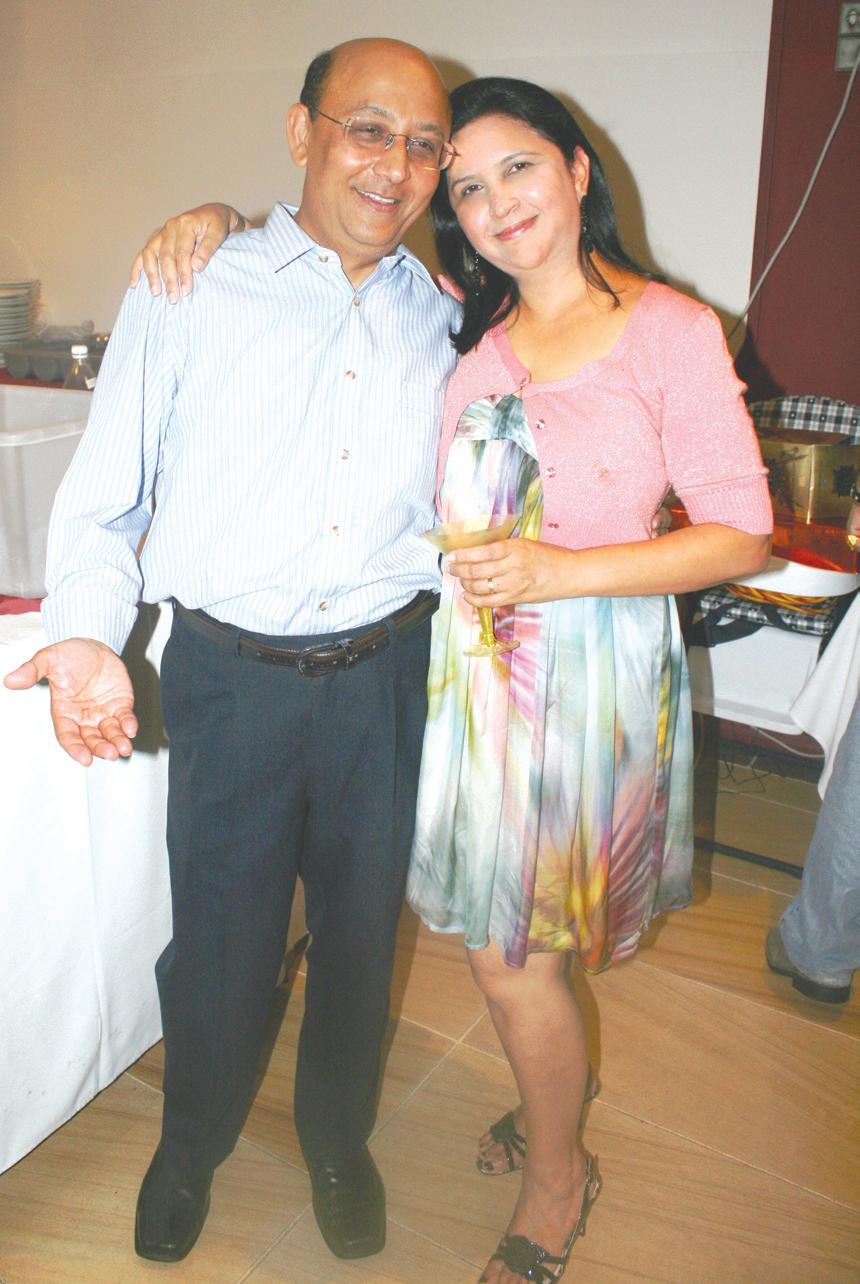
made the most astounding of discoveries –that the best way to teach hoards of student, institution-independent. Codify knowledge in ), pass them on verbally from generation to generation and catch every discipline of knowledge.
teachings) were thus born. When they were about to wither away with the decreasing pool of collective verbal memory, in 800AD Shanakaracharya decided to rejuvenate them by a verbal refresh in four new Universities. A written tradition soon followed, with written scriptures on leaves, metal sheets, stones, cloth and previous incarnations of paper. Some superb concepts were produced by this proliferating knowledge base – the inventions ) and the decimal system; the ); the concept of nuclear weapons (Agnyastra
Knowledge is fast going online, first with online dictionaries, then Wikipedia, and is now open even more with learning and online course material
and Brahmastra); understanding of the solar system and that the earth rotated around the sun by Aryabhatta; the concept and value of Pi; practice of herbal medicines by Sushrut and Charak; anatomical understanding of human and animal bodies and much more –all well codified and well documented.
Now, back to the present and future with the internet. Knowledge is fast going online, first with online dictionaries, then Wikipedia, and is now open even more with learning and online course material like You Tube training videos, free web seminars (webinars) by hoards of companies and product inventors/sellers, video lectures, open Universities, online classrooms and so on. At this rate, within the next 10 years all essential and repetitive education will be free and available online in a whole variety of formats – text, audio, video, online classes, peer-to-peer student and faculty review sessions, Q&A forums by experts, free webinars and class notes posted by students and retired professors from top notch Universities. There will soon be structured and unstructured educational and training material of the highest quality educational levels, celebrity international teachers and institutions webpages with tips and materials for self-paced, self-timed studies with doit-yourself, do-as-you-like and do-as-muchas-you-want-to course materials suitable for every level – novices, quick learners, the brightest and the super dupers, but also for the dumb and the strugglers.
As to the issue of who will pay, first my forecasts and then the reasons: most of this










will be free, made available by many vested interests but also by charitable, philanthropic, governmental, institutional, trade and commercial interests. These efforts will come from absolute top notch experts in every field of education and from experts within every industry, starting from prestigious educational institutions, marketing and advertising executives, employers, current and past students and their organisations, and yes, even from countries and their governments. Why? Remember, this is not all about benefiting parents and students; it is about benefiting whole societies and peoples, so it is of interest to governments, industry, employers, advertisers, marketers and even those within the current education sector. At some point, a whole range of players including governments, charities, NGOs, employers, advertisers and philanthropic educational experts will team up in various ways to sponsor all aspects of such free online education, because it is a classic winwin for all parties. For example, variously, they will provide study-only computers, hardware, software, access to internet and in some cases, all incidentals, course material, free webinars, free helplines, Q&A forums, WIKI style educational resources with “drill-down” knowledge menus. And don’t forget Facebook, Twitter and Google-driven peer-to-peer student support structures from across the world. All this will give the biggest boost to our global knowledge and knowledge-based industry, but also to an available, well-trained international workforce, and thereby to global GDP. Teaching, learning and educating online in that environment could easily be supported by online advertisements for example, or by employer-chosen course materials. One can also think of global, independent examination and certification bodies like those who currently conduct entrance examinations for global admissions. If the emphasis remains on degrees, students may still have to pay for examination and certification of their knowledge. However, the way I see it, employers and governments will soon start calling the shots. Governments benefit by online education because it cuts costs. Large employers will be interested in online education because they are the big end users of educational degrees, and must have a more direct say in all aspects of education. If education was cheaper, faster and tailor-made or cherry-picked by employers, future students will not waste time and money studying courses on geography and history, when their job is about marketing, sales, nursing or accountancy. This will mean that more time will be provided to master courses that the employer wants, rather than what the University decides to teach for a degree. If employers paid for their choice of certification and examination after free online education and free online training of courses they choose for their job positions, they will get wider pools of prospective employees to choose from, and very early on. Lots more could be argued to show that employers and governments have a lot to save and benefit from this process in the future. Online learning will also be the world’s surest insurance against worker shortages in the future. It is a winning idea from the Vedic times. Bring it on!

JULY (2) 2011 <> 39 NATIONAL EDITION INDIANCONSULARQUERIES
As the world expands through the internet, a future of free online learning could well become a reality
www.indianlink.com.au OPINION



40 <> JULY (2) 2011 INDIAN LINK EYES TAR EYEWEAR OPTICAL SHOP IN STRATHFIELD 20 years in optical services L owest prices, High Quality Cheaper then India, very superior quality Optical glasses FROM $ 69.00 Convenient & Reliable All brands available Alrose office Suite 4, Level 1 7-9 Churchill Avenue, Strathfield 2135 50 meters to station, opposite plaza parking Same level as Webstation All about glasses & contact lenses Booking Essential Contact Kim on 8004 0212 Working late nights 6 days a week strathfield optic studio
Utterances of a twisted mind
While the civilised world is waking up to homosexuality, recent comments of India’s health minister reveal that some lawmakers are not only uninformed, they also harbour deep-seated prejudices
BY ROY LANGE
Ghulam Nabi Azad’s startling statements about Indian homosexuals exposes not only an idiot but more importantly the cancerous ‘chamcha culture’ that grips the Congress. I met Azad many years ago at a function hosted by Sonia Gandhi, who had then not even hinted of her ambitions. Azad was

Ministers laughed their heads off and told him he was a chumcha, admittedly an excellent one.

When you are assessed for your ability to kiss royal posteriors and possession of obscure vote banks you will always get an Azad. Individuals who are so removed from reality that you have to purchase tickets to their world to have a conversation.
His statement that homosexuals were hard to administrate because unlike prostitutes they didn’t congregate in readily recognisable areas is sensationally bananas.
Azad, not yet even remotely discouraged, then generously bestowed another profound pearl of wisdom: homosexuality was not only unnatural but that homosexually was brought to India by foreigners.
Bring out the men in white coats with two straight jackets - one for Azad and one for Mrs. Gandhi.
Investing any responsibility that involves anything more complicated than the demands of a rickshaw puller in this incompetent politician is equally mad. Mrs. Gandhi’s constant five cents that the windows to Government need to be cleaned and MPs held accountable is now a further heavily devalued currency. The window has not been cleaned as so much as it has been smashed and we have had an unsettling peek at her bathroom cabinet. Cabinet ministers that could not run a brothel.
If Azad had had the intelligence to remember mid sentence that his Empress
was an erstwhile foreigner he would have died from a major cardiac event. That he didn’t is very unfortunate because he continues to administer the mortally important health portfolio, that he clearly does not, without a pinch of ambiguity, have the marbles for.
This is an utterly obvious conclusion when you consider the statements were made in an HIV conference. The equivalent of rocking up to a Holocaust memorial in a Volkswagen or asking for a jumbo box of condoms at the Vatican gift shop.
Many of my dearest friends - and I am very proud to call them friends - are Indian homosexuals. For six years I lived next to a Delhi Hijira colony full of characters. Their sexuality is only a part of their identity. Though I will indulge in some bigotry.

A gay friend very bravely went back to North Delhi, a bastion of conservatism, and shaking like a leaf told his parents he was batting for the other team. His father’s reaction would have been less violent if his son had told him he was batting for Pakistan.
Indians will forgive you for being gay but they will never forgive you for not procreating. His father’s response, after having a stiff peg and a lay down, “Beta, you have to stop being naughty and get serious”, as his Mother handed him some
pompous to the point of absurdity but when Mrs. Gandhi entered our midst he went from being the sultan of greater India to a groveling buffoon. I have never seen such a change in posture. He nearly head butted the floor with his whimpering bow and I’m sure if I had looked his knuckles would have been bright purple from the force he pushed together his namaskar. It was not dissimilar to someone on the brink of starvation begging at an intersection. When Mrs. Gandhi left our circle his fellow
Mrs. Gandhi’s constant five cents that the windows to Government need to be cleaned and MPs held accountable is now a further heavily devalued currency
My stereotype of an Indian homosexual is quite prejudiced in that I believe they are almost without exception above average citizens. They are high achievers in business and the corporate world with their strong sense of civil behaviour. I also believe in my prejudice that they have a predisposition for getting the job done right.

To alienate this community, which could be at least 50 million Indians, is not the brightest move. Twice the population of Australia could be natural dancers and know their flared jeans from their skinny jeans.
A phenomenon I have witnessed is that a considerable amount of Indian students studying in Australia have come out of the almirah. It is of course much easier to do here rather than Rajouri Garden.
homeopathic medicine and told him about some girls she had lined up.
Azad’s Jurassic attitudes help reinforce these impractical ideas. The Congress leadership needs to purge itself of unqualified dinosaurs living in fractured realities.
Indian gays need to be recognised in a society that badly needs them. They need to be embraced by the State and welcomed to share the exciting burden of lifting India higher and yet higher.
JULY (2) 2011 <> 41 NATIONAL EDITION
www.indianlink.com.au
VIEWPOINT
My stereotype of an Indian homosexual is quite prejudiced in that I believe they are almost without exception above average citizens
Ghulam Nabi Azad
A day in
Seoul
Here’s a ‘one-day itinerary’ for those short on time but keen to experience the city’s enchanting mix of modernity and history


 BY SANDIP HOR
BY SANDIP HOR

The moment you think Korea, names such as Hyundai, Kia, Samsung, LG and Taekwondo come to mind straightaway. These are 21st century links between Korea, I mean South Korea, and rest of the contemporary world. However, during my recent trip to this North East Asian nation, I pleasingly discovered that there is lot more on offer for visitors to this beautiful country than just cars, electronics and martial arts.
Like India, South Korea was born as a nation in 1948, when the ancient land on a peninsula was divided into two, based on political alliances. Today, despite a turbulent political history, it stands as one of the most modern and progressive quarters in the region, enthralling the visitors not only by millenniums of history and traditions, but also by its well preserved and profound natural beauty and cultural relics. That’s why several of their sites of historical and cultural significance have gained a place in UNESCO’s World Heritage list.
Seoul, the capital city is the epicentre of politics, economy and culture. It has
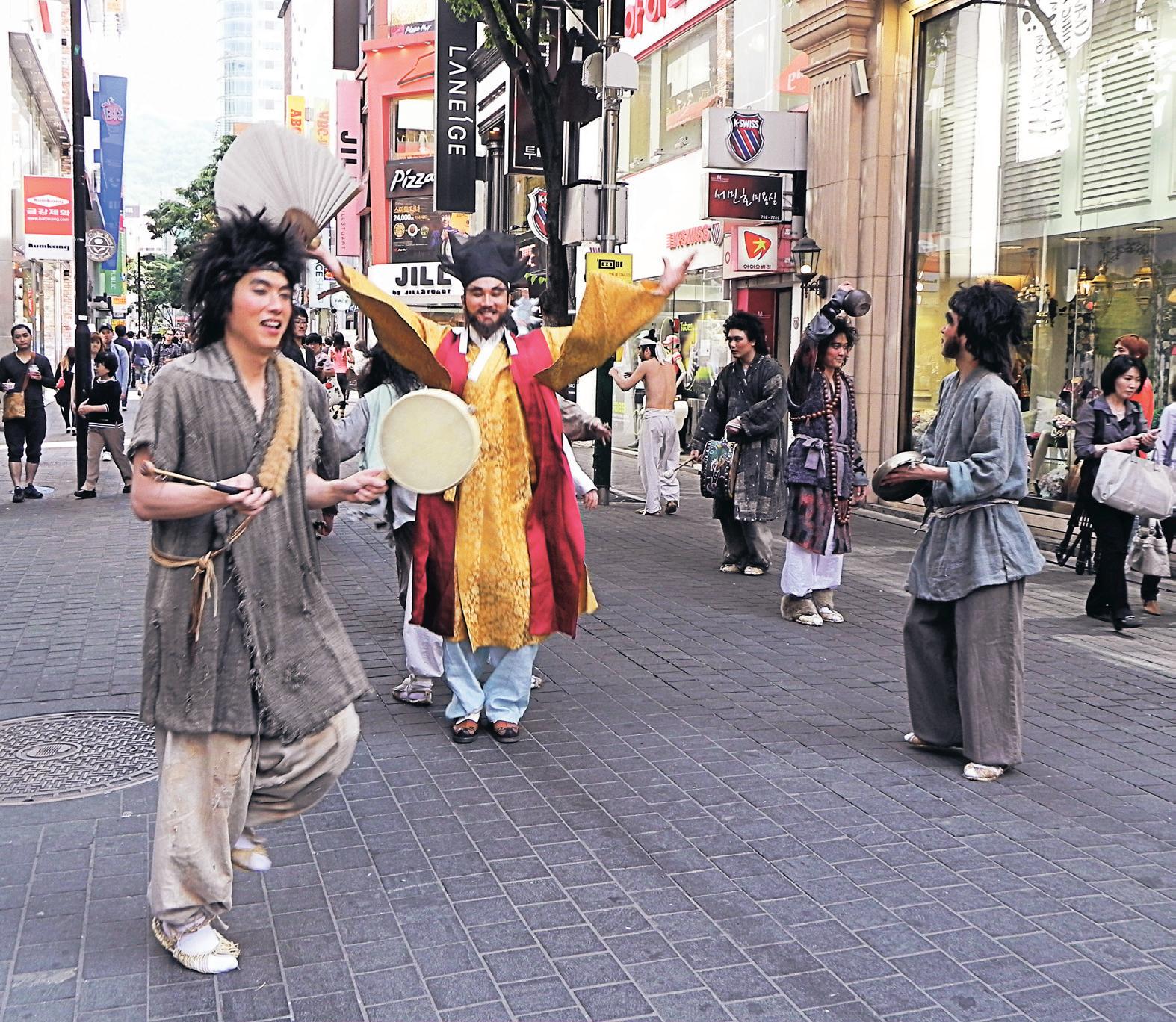
enjoyed that status since 14th century, when it was established as the nerve centre of the famous Joseon dynasty, which ruled Korea for almost six centuries.
Perhaps one needs several days to explore and intensely experience Seoul’s diverse range of attractions, however for those on a tight schedule – like those on their way to the country’s other treasure troves Gygeonju, Daegu, Busan and Jeju, or on a stopover en-route to Europe or other parts of Asia – here’s a one-day itinerary based on my recent experience of spending a day chasing the “best and must” the city has to offer.
9.00 am: National Museum of Korea
The National Museum of Korea is the nation’s largest museum and the best place to visit for those who want to experience comprehensively the essence of Korean history, art and culture, from ancient days to modern era, covering glorious periods of royal dynasties from Gojosen, Goguryeo, Baekjae, Silla to recent Joseon.
Of the 18,000-odd artefacts on exhibit, these masterpieces are a must see: gilt - bronze Maitreya in meditation; gilt incense burner of the Baekje period; silla golden crown; vessels in the shape of warriors on horseback; and the 13.5-metre high Gyeongcheonsa temple ten-story pagoda.
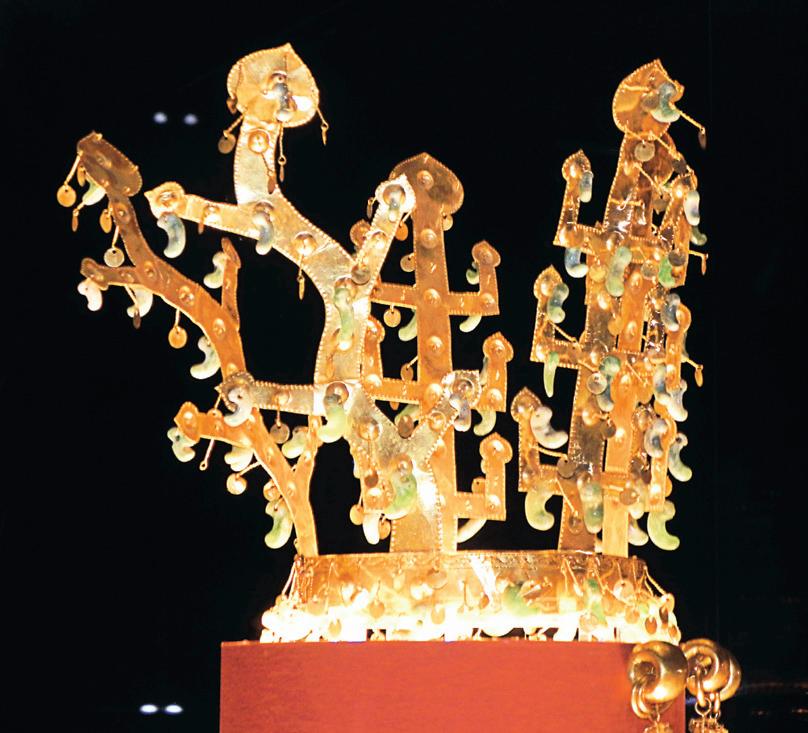
Travel notebook Seoul
GETTING THERE
Asiana Airlines (www.flyasiana.com) from Sydney and Korean Air (www.koreanair.com.) from Sydney Melbourne and Brisbane have regular flights to Seoul.
ACCOMMODATION
There are no shortages of hotels to suit budget; however Best Western Kukdo (www.hotelkukdo. com) offers good value for money.
GETTING AROUND
Use hop on –hop off Seoul City Bus (www. seoilcitybus.com), that will take you to all touristy destinations. However taxis are easily available and cheap and city also has an excellent subway and a bus network.
BEYOND SEOUL
Visit Gyeongju the ancient capital of Silla kingdom, Daegu, the hub of oriental medicine and Jeju Island, a finalist for the new Seven Natural Wonders of the World contest
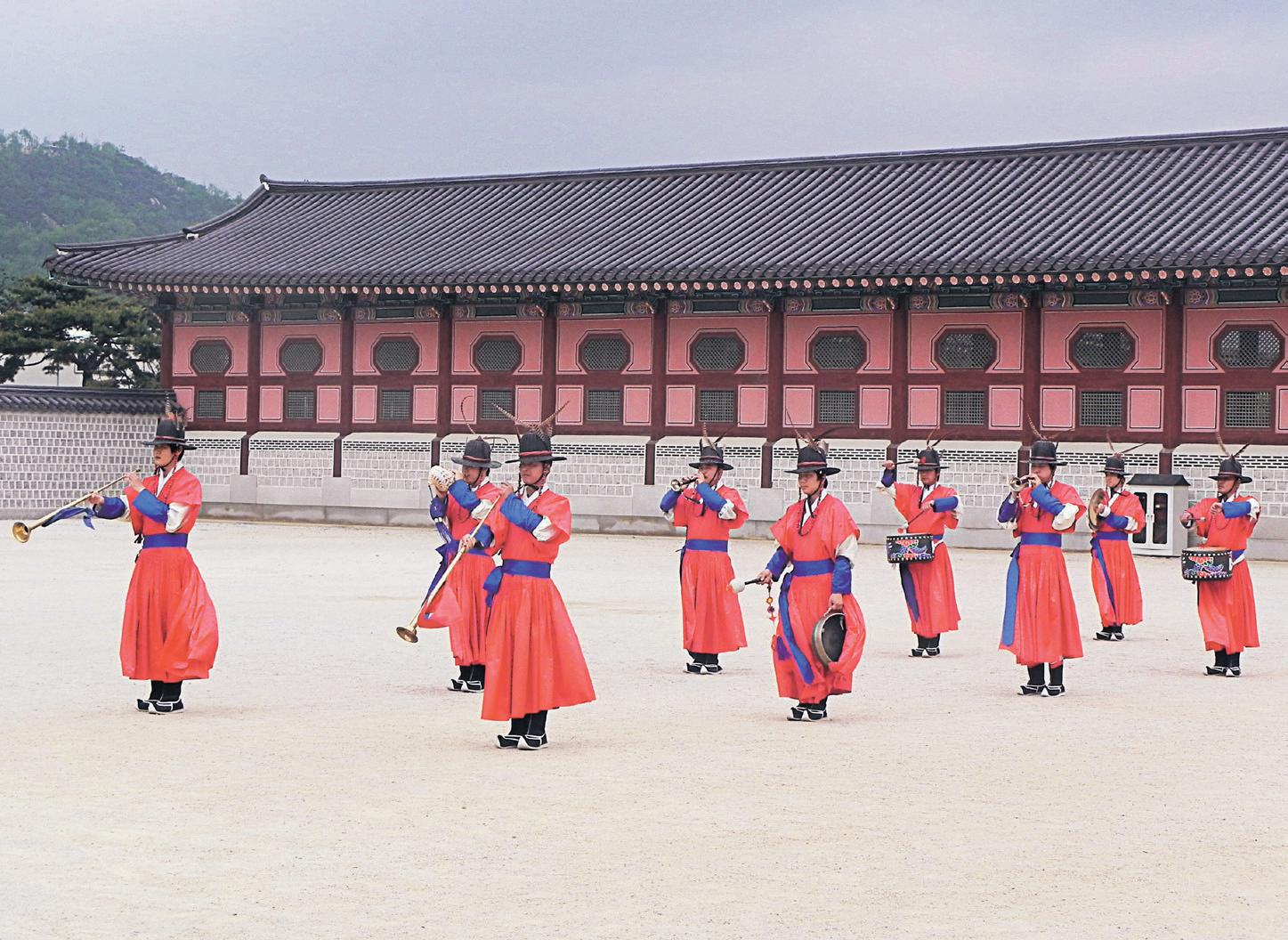
VISA & CURRENCY
Australian passport holders receive tourist visa on arrival at Incheon International Airport. Local currency is WON with 1AUD =1100 WON.
MORE INFORMATION
Korea Tourism (www.visitkorea@knto.org.au)
1.00
palaces
The city proudly boasts of five Joseon dynasty palaces, each of which is an architectural marvel. Geongbokgung Palace, built in 1394 by the dynasty’s founder King Taejo, is the oldest. As the principal residence of the dynasty rulers for centuries, it covers a 40 acre rectangular area dotted with temples, royal quarters, pavilions and man-made water ponds and separated from the cityscape by ornamental gates. Every day at selected times, royal changing of guards takes place at the main entrance when the colourful ceremony filled with pomp and grandeur takes you back in time. The other palaces, build during later period of the dynasty, are Deoksugung, Gyeonghuigung, Changdeokgung and Changgyeonggung.
Dotted with large departmental stores such as Lotte and Shinsegae and myriad shops selling clothes, shoes and cosmetics to cater for every fad and style, Myeon-Dong is the trend-setting hub of Korean fashion and the right place for shopaholics.
3.00 pm: Myeong-Dong
Dotted with large departmental stores such as Lotte and Shinsegae and myriad shops selling clothes, shoes and cosmetics to cater for every fad and style, Myeon-Dong
is the trend-setting hub of Korean fashion and the right place for shopaholics. An architectural highlight of the area is the 1898 built gothic style Myeong-Dong Cathedral, the nucleus of the city’s catholics.
42 <> JULY (2) 2011 INDIAN LINK
pm: Royal
TRAVEL
11.00 am: Insa-Dong

Packed with art galleries, craft stores, antique shops and traditional tea houses, this 700-metre stretch is where visitors experience traditional art of Korea. During Joseon dynasty, the domain was dominated by Dohwawon, a place of study for painters. Old paintings, ceramics, paper crafts and antique furniture are found here in abundance. Queen Elizabeth marked her footprints there in 1999 and was highly impressed by the efforts of locals, trying to keep millennium old artistic flair still alive.
5.00 pm: Nanta performance (www.nanta.co.kr)
Seoul is ranked after New York and Paris, for the number of cultural shows presented in a metropolis.
8.00 pm: Changdeokgung Palace night tour

This night tour is something unique and special. It takes place on selected dates and provides a distinctive opportunity to enjoy the beauty of the illuminated treasured complex, once inhabited by the royals. An expert guide dressed in traditional Korean costume leads visitors through a mystical journey around the palace grounds telling interesting stories about the place, its history and occupants. The two-hour program ends with a traditional concert at the same venue where the erstwhile royals entertained their guests
Here both actors and audiences show great passion and enthusiasm towards performing arts and perhaps would be a great miss if you leave the city without experiencing at least one of them. Exciting non-verbal performances, such as the Nanta, is extremely popular with visitors. Since its first performance in 1997, this amazing show, described as a musical comedy where all artists use regular kitchen utensils to create a high energy performance, never fails to engage audience with infectious rhythms and harmless humour.
Midday: Sampling Korean cuisine
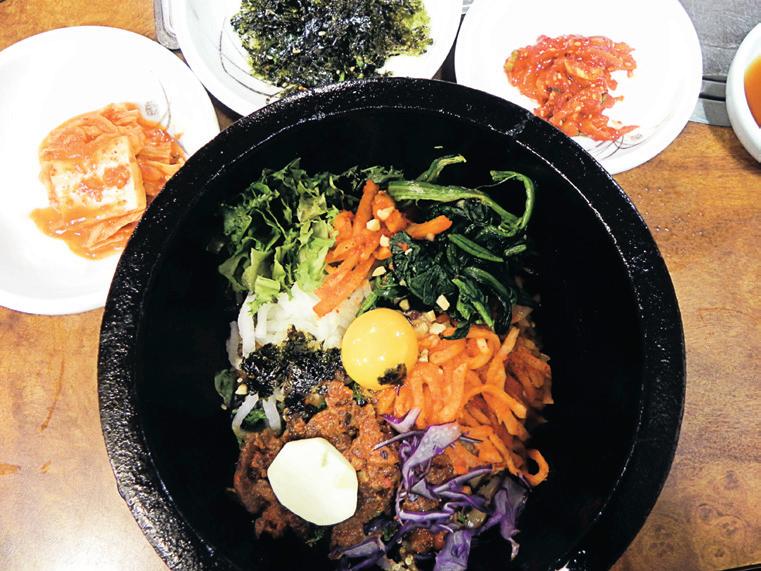
There are several restaurants in the Insa-dong area that provides a taste of authentic Korean cuisine, made up of unique aroma and taste. They are all highly nutritious items, seasoned with ingredients such as garlic, ginger, chilli paste, scallions, soy sauce, fermented bean-paste and sesame oil. Kimchi, a fermented vegetable, generally cabbage, dish is served with all meals; bulgogi, bibimbap and ginseng chicken soup being some of their extremely popular meat dishes.
10.00 pm: Night markets
If you haven’t completed shopping at Meyon-Dong, then visit the markets at Namdaemun and Dongdaemun, which are open day and night and offer a large range of merchandise at bargain prices from clothing to household items, though at night time the wholesalers crowd the shops.



7.00 pm: Dinner
It’s now time to fill up your stomach with something good, authentic and substantial and the buffet at the internationally famous Todai Restaurant at Myeong-Dong is a
great option. The space inside is sprawling, packed with tables and food counters manned by chefs carving, frying, baking and generally cooking up a storm. You can spend the rest of the evening there, eating quality food to yours heart’s content. The menu includes variety of seafood items for which Korea is famous for, along side several other meat and vegetable dishes, soups, salads, fruits and deserts.
Midnight






If you still have energy, it’s time to chill out at one of the city’s many night clubs, for some nice cocktail and hip swinging disco action to the tunes of rock music, lusty enough to get you on the floor, though I returned to the comforts of the hotel room, recounting the day’s actions before falling asleep.

JULY (2) 2011 <> 43 NATIONAL EDITION
www.indianlink.com.au
INCOME OPPORTUNITY

TO
BE THE VERY FIRST PIONEER IN INDIA
Experienced, Successful Network Marketer is looking for business partner to launch Indian Market as a Ground Floor Opportunity. This World-class Fast Growing International Company achieved $5 BILLION sales in 6 years and debt free. This company has just opened In Malaysia and Thailand. Only one product, health beverage, no stocking required.

WE ARE LOOKING FOR 3 PEOPLE TO WORK WITH PERSONALLY.
Must be Ambitious, Hard working, Honest & Teachable. We are only looking for people who are genuinely and seriously seeking opportunity and desire to change life.
Free Sample will be provided, Modern Office in City

To arrange a meeting, contact:

Zan 0414 767 419 (English)
Lithgow

FREEHOLD RESTAURANT PREMISES
• Prominent Main Road position

• 65-70 seat restaurant with bar
• Commercial kitchen & garden flat premises
• Growing regional area
• 2 hours from Sydney
• Premises “ready to go”
Jamie Giokaris 0418 201 028
44 <> JULY (2) 2011 INDIAN LINK
Over open plan offices!
BY SHAFEEN MUSTAQ
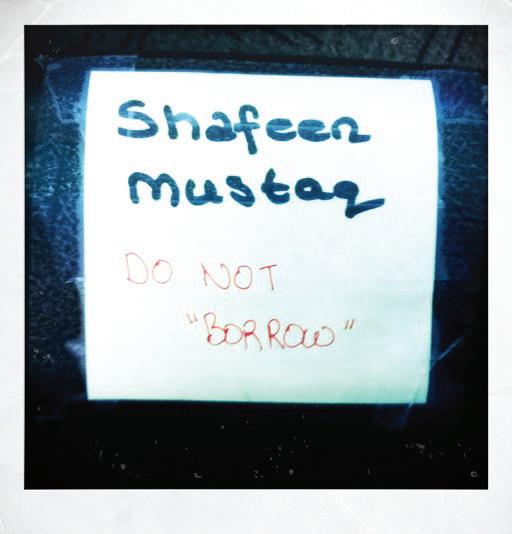

There isn’t much I miss about my previous job. But there is one thing that revives an irrepressible longing - my workspace! I clearly remember my first day in my current job. Walking into the office and stopping dead as my manager indicated a flat table with a chair, and a flimsy 20 cm partition that separated me from three colleagues. This is your desk!
There are days when I am struggling to concentrate on meeting deadlines because all the people around me insist on having little chats with their co-workers or on the phone, and the combined volume makes it impossible to concentrate, let alone get any quality work done
Desk? What desk? It was a long table split in half by plastic two handspans high, separating two people on each side. There was no delineation of boundaries between me and the person sitting beside me. My first instinct was to turn around and walk out. I love my personal space and hate having it invaded. Working eight hours a day with no clear boundaries of where my space is, was or would be, sounded like a nightmare. Suddenly the reassuring walls of my little cubicle at my previous workplace looked so very appealing.
Two years on, I still hate open plan offices. Granted I have now moved to a ‘pod’ where three desks are pushed together to form a pod and I have those great plastic boundaries to mark my space – but I have found so much more to dislike about open plan offices than just the lack of personal boundaries.
Talk about people
More importantly – noisy people! I understand that I work in a big firm with lots of people. I understand that you are a very important person making a very important call. But do you have to speak loud enough for the whole floor to hear what you did on the weekend? I am sick of sitting near people that practically scream out their life stories on the phone, gossip with their neighbours or just sniffle away to themselves, blissfully unaware that tissues have been invented. And even if you are talking about work-related topics, do you have to do it while standing right next to my desk? Meeting rooms have doors – this is so
you can close them and have a meeting without disrupting others, not leave them open and hold loud conversations that frustrate me into getting up and closing your door for you.
Kitchen conferences
I love the kitchen. I love the tea, coffee and the cute mugs. What I could live without is the sudden transformation from tearoom to pub/restaurant/ mates house that happens every lunch time and after 5pm. Suddenly a desk near the kitchen is not convenient – it requires earplugs as every newbie grad in the building seems to congregate in the kitchen, insisting on speaking louder than the person next to him/her.
Take a sickie!
Lovely, congenial, enthusiastic colleagues can turn into pale-faced, red-nosed, tissue-wielding workers from your worst nightmare at the first onset of a cold. I understand the dedication to your job and love for your work that makes you actually come in when you look like death warmed up. Honestly, I do. But do you have to build up that pile of used tissues on your desk? Do I have to bless you while you try and break some world record for most sneezes per minute? Will my ears forever be subjected to the grating live updates of your bodily functions via coughing, sneezing and the shifting of phlegm and mucus? Here’s a thought – stay at home!
Leave mine alone
I have a load of chair borrowers. It took me three months after I joined to find a proper chair at my workplace. Every day I would come in and spend ten minutes trying to work out who had ‘borrowed’ my chair and where they had left it. I didn’t know my Where’s Wally skills would be so useful in my current role. Even after I had laboriously written my name on a paper and stuck it to the chair, I came back from a holiday to find a nice old man sitting three pods across in my chair, which still proudly bore the label with my name on it. I have since recreated the label as below:
back up the way I feel! Two articles indicate that open plan offices make workers sick, say

my earphones all day long!
“The high level of noise causes employees to lose concentration, leading to low productivity, there are privacy issues because everyone can see what you are doing on the computer or hear what you are saying on the phone, and there is a feeling of insecurity,” says the report. Ditto.
Researcher Dr Vinesh Oommen from the Queensland University of Technology’s Institute of Health and Biomedical Innovation, says: The research found that the traditional design was better - small, private closed offices. The problem is that employers are always looking for ways to cut costs, and using open-plan designs can save 20% on construction. Based on these findings, I think employers around the country need to rethink the open-plan environment in their offices.”
Hear, Hear!
Australian scientists*. One of the reports indicate the “overwhelming evidence” that “In 90% of the research (conducted), the outcome of working in an open-plan office was seen as negative, with open-plan offices causing high levels of stress, conflict, high blood pressure, and a high staff turnover. You’re telling me! There are days when I am struggling to concentrate on meeting deadlines because all the people around me insist on having little chats with their coworkers or on the phone, and the combined volume makes it impossible to concentrate,
* Oommen, Vinesh G., Knowles, Mike, & Zhao, Isabella (2008) Should health service managers embrace open plan work environments? A review. Asia Pacific Journal of Health Management, 3(2), pp. 37-43.
JULY (2) 2011 <> 45 NATIONAL EDITION
www.indianlink.com.au
It may seem a practical way to save on costs, but the loss of privacy and concentration can affect productivity
LIFESTYLE
I am sick of sitting near people that practically scream out their life stories on the phone, gossip with their neighbours or just sniffle away to themselves, blissfully unaware that tissues have been invented

46 <> JULY (2) 2011 INDIAN LINK
Tweet Wars
Twittering seems to be the new publicity watchword that’s taking everyone, including Bollywood, by storm
BY SHRADDHA ARJUN
Hootsuite, tweetdeck, oosfoora and the likes, Twitter has invented a whole new coinage of words: Tweeple, Tweetheart, Tweetie pie, and so on.

With the morning cuppa and news updates, people can’t seem to get enough of Twitter. Running parallel with Facebook, this social networking site is here to stay. It only seems to be getting bigger and better in Twitter universe, or should I say Twitterverse? News updates which are quicker than breaking news on
Our B-town A-listers can’t seem to get enough of Twitter, as from the Big B to Junior B celebrities, everyone’s on the site, busy promoting their films and themselves, and in the process, creating a bit of hungama
TV, “personal” tweets from celebrities, events, product launches, you name it and it’s on Twitter! It is indeed the age of communication. Just when one tries to cope with Twitter, Google+ makes a grand entry, and now we have a third social stream to amuse us!
Our B-town A-listers can’t seem to get enough of Twitter, as from the Big B to Junior B celebrities, everyone’s on the site, busy promoting their films and themselves, and in the process, creating a bit of hungama
It begins with the Big B
When it comes to the Shehanshah, he literally seems to be standing by the title of his latest flick, BBuddah Hoga Tera Baap. One is just flabbergasted to see how effortlessly Mr Bachchan is tweeting and blogging away to glory. When he announced the Bachchan bahu’s pregnancy over Twitter, the media lashed out against the method he used to disclose the news: “NEWS NEWS
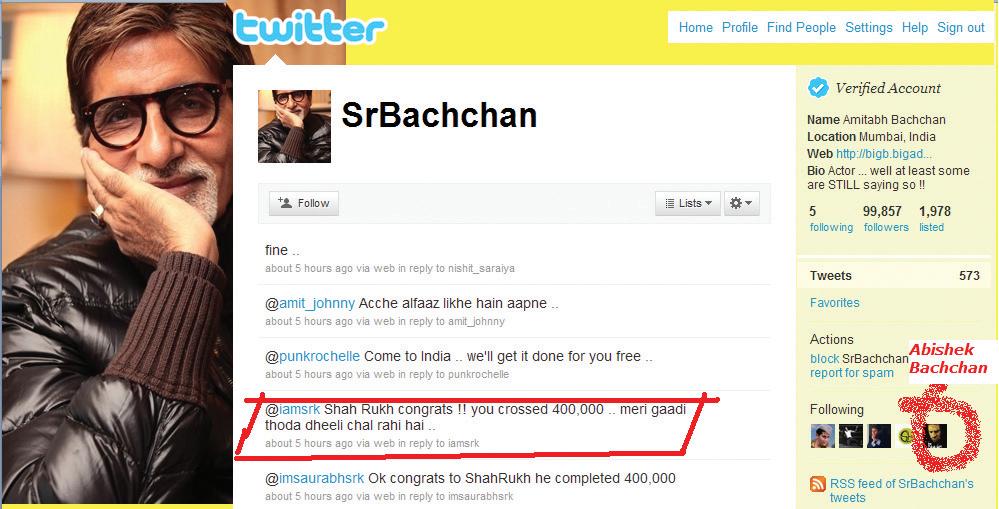
NEWS !! I AM GOING TO BECOME
A GRANDFATHER .. AISHWARYA
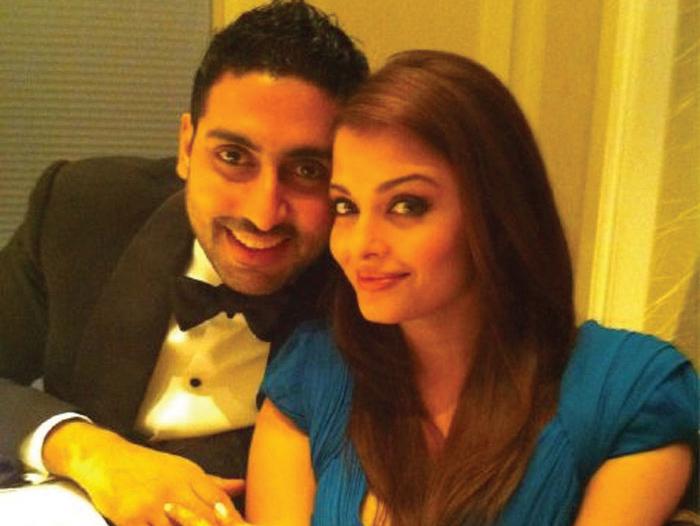
EXPECTING.. SO HAPPY AND THRILLED !!!”
Perhaps they were annoyed that he had revealed the scoop before them.
But the Big B also has an uncanny knack of using Twitter to settle scores, or so it seems, as he took time out to defend son Abhishek’s poor performance in Raavan, blaming the editing instead. Mani Ratnam wasn’t thrilled, however Amitabh Bachchan was quick to do damage control with his next tweet: “Media playing with words. Mani is one of our finest directors.”
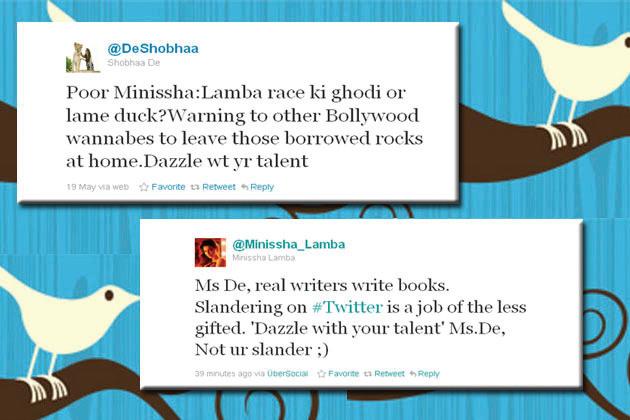
Big B’s tweets are perhaps as entertaining
as his films. His previous tweets about Rajnikanth were also seen flashing on gossip tabloids, as he tweeted: “Someone sent me this on mobile -- When Graham Bell discovered the telephone, he found two missed calls from Rajnikanth!! Brilliant.”
Now Rajnikanth’s diehard fans insisted on a clarification, as only they could. The angry young man of the yesteryears was quick to apologise, tweeting: “Never criticising Rajni ... it’s actually praising him .. his greatness and his power .. love not making fun of him ...praising his status and his greatness ..he is noble successful humble person, and revered like a God.”
Jumping on the tweetwagon
Taking their cue from the top, now stars and starlets are making their presence felt through relentless tweeting.
Ram Gopal Verma (RGV) seems to tweet with the sole intention of seeking all the media attention that he can possibly find. It all started with his remarks about KJo’s (Karan Johar) film K3G in comparison to Rakta Charitra, his film due for release soon. The tweeters took potshots at each other, using tongue in cheek humour to disguise their animosity, and their followers were the most entertained.
RGV was recently in the news for all the wrong reasons when he expressed his interest in signing Maria Susairaj for his forthcoming film. This was completely inappropriate and uncalled for. RGV had to come up with a justification for it, so then he went on to tweet: “If someone has been convicted and the person served a given sentence, she has a right to start her life afresh and that’s a part of civilised society.”
RGV further tweeted: “Maria is not my sister or my girl friend and I don’t even know her... So it’s not about supporting her but about standing for my beliefs…”
He went on to justify his decision, airing gyan about his attitude which made a bit of tedious reading.
Baring the claws
Sometimes 140 characters can be a lot to read and it’s interesting how one can write so much within that space. Gul Panag has suddenly regained her star status thanks to the tweeting, and this self-proclaimed activist has an opinion about everything! However, her tweets aren’t half as sensational as her contemporaries who engage in cat fights on Twitter.
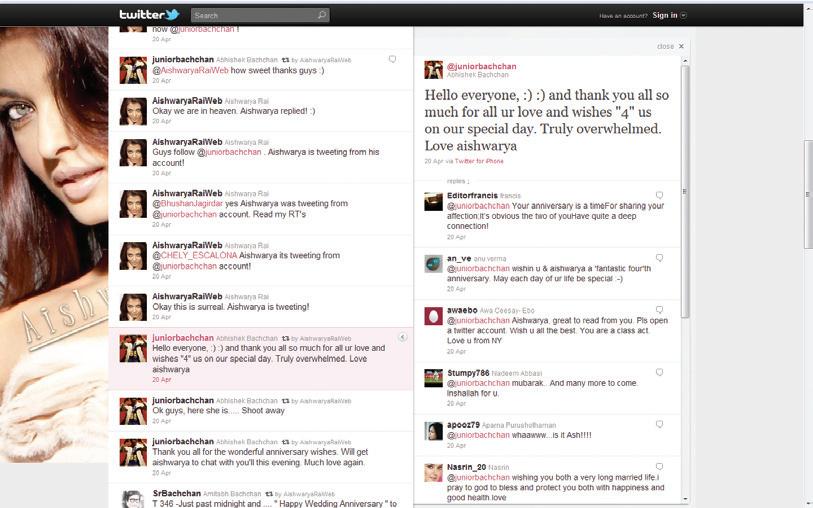
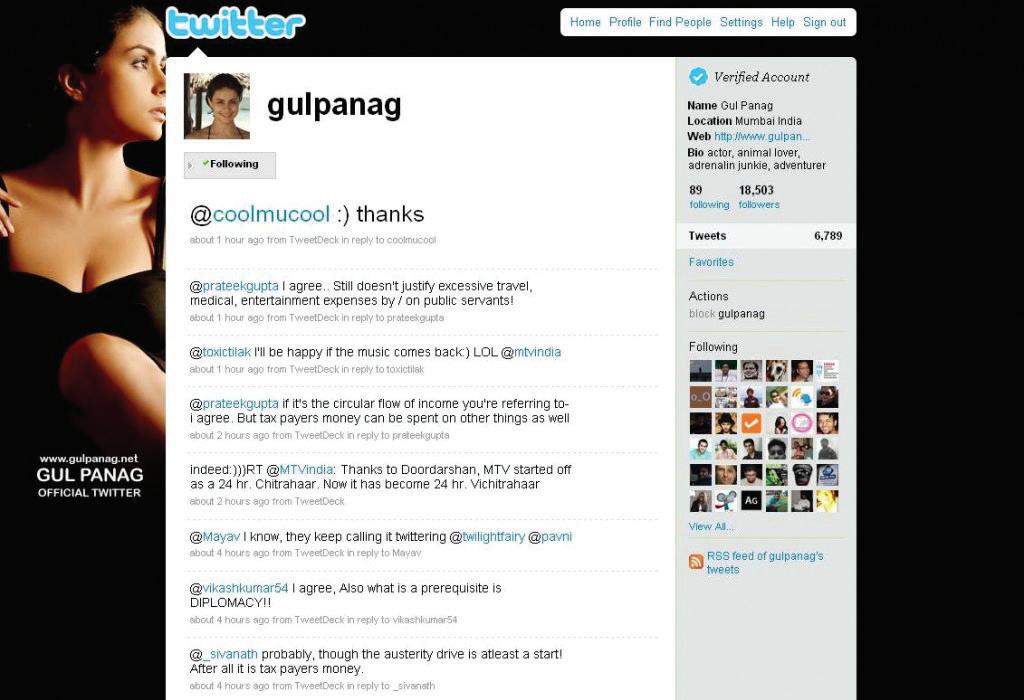
Take Sonam Kapoor for example: with less than 5 films to her credit, she seems to be basking in the reflected glory of Bollywood’s latest export to the west, her dad, Anil Kapoor.
It all started with Shobha De’s blog about Sonam’s film I Hate Luv Stories, in which she wrote:
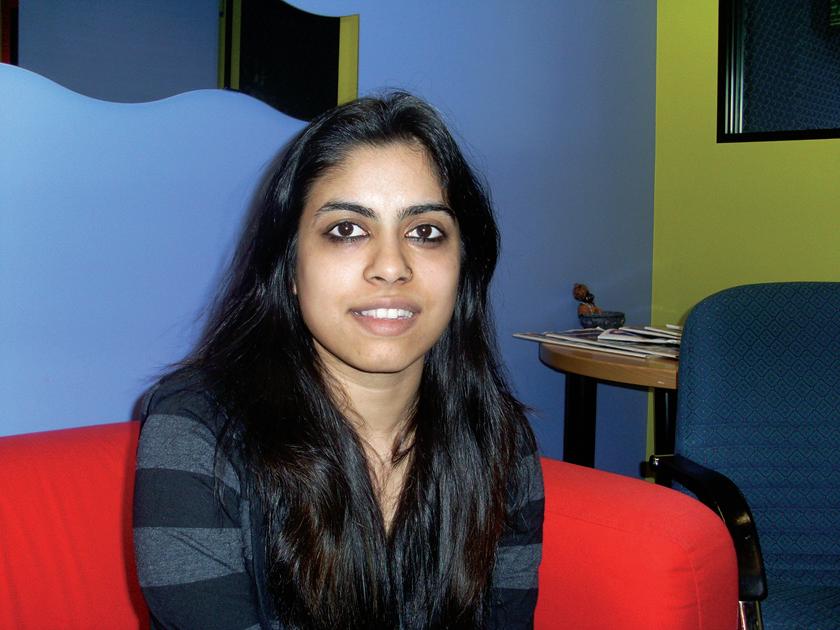
“What an absolute waste casting Imran Khan and Sonam Kapoor in this utterly dull, total dud of a movie which is more a wonky tribute to Karan Johar’s earlier films, songs and screen pairings. …… Come on guys; are you that desperate for original ideas that you have to pack so many reels of a contemporary film with such obvious take-offs? This isn’t clever tongue-in-cheek stuff. It’s plain
unimaginative.”
Sonam couldn’t handle Shobha De’s ruthless criticism, so she re-tweeted director Punit Verma’s tweet which said: “Guys pls don’t take Shobha De seriously. She’s a fossil who’s getting no action and going through menopause. So just for her...”
In this case there was no need for the media to create a spin; the stars were providing them with enough fodder right there. A spate of interviews followed where the topic of discussion was not about Sonam’s films, but about the tweets she seemed to be engaging in.
Now if that didn’t give you a hearty laugh, then you’d probably want to check out what Bollywood’s notorious brat pack (the
Salman seems to be leading the pack with the maximum number of followers on Twitter, a massive 18,833 just within a day of creating his Twitter page, and still counting
Khans) were upto. Aamir, Shahrukh and Salman never miss an opportunity to one-up on each other’s tweets. This space can’t do justice to their tweets, but Salman seems to be leading the pack with the maximum number of followers on Twitter, a massive 18,833 just within a day of creating his Twitter page, and still counting.
Pics n philosophy
Amidst all the hate there seems to be an occasional dosage of love and some sentimental snaps from our B-town stars. For instance, the adorable snaps of Hrithik’s kids, Shahrukh’s cute little boy and girl and ah, yes there are also pictures from the Bachchan’s family outings that make us all go …awwww, cho chweet! There are also some philosophical quotes from the likes of Shekar Kapoor, Anupam Kher and sudden outbursts from Mahesh Bhatt and his daughter Pooja.
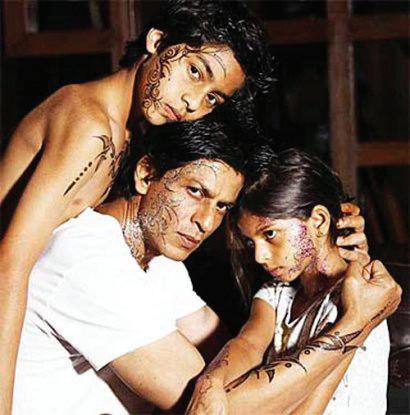
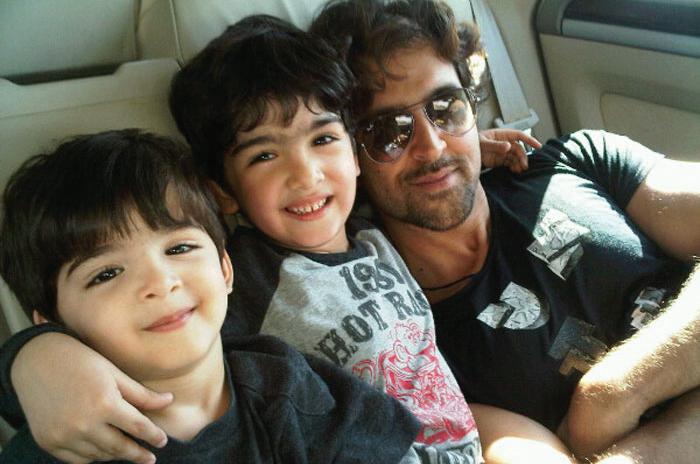
And while Pooja Bedi brags about her lifestyle and fitness regime, Shilpa and Bipasha follow suit.
Exasperated already? Not like we are complaining or anything, but there are times though, when one does cry out loud in frustration “I don’t want to know if your espresso shot woke you up or gave you the jitters!”
Twittering is a bit like any other form of addiction, but you can somehow feel better about yourself by knowing that the stars who once seemed like gods to you are but human, just like the rest of us. (Only a tiny bit richer!) As for the rest of you who think ignorance is bliss, think again. There’s probably a lot out there that you are missing out on!
JULY (2) 2011 <> 47
www.indianlink.com.au
NETSAVVY
















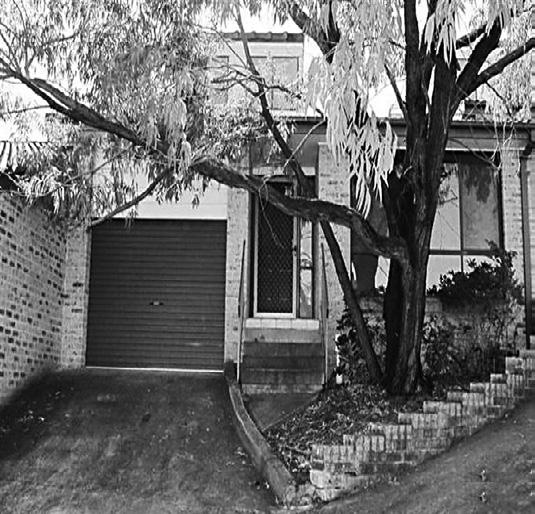

48 <> JULY (2) 2011 INDIAN LINK
Buying property in India
Buying property in India
India is a vast country with diversity in culture, people and attitude towards almost everything. Every part of the nation has a specific trend towards property. Some places consider property as religious and God gifted, while many others look at it with an investment point of view.
The main idea to ‘buy property in India’ is not at all a bad one. In fact, due to this boom in the property market in the country, new people and new cultures are establishing in various areas. When more and more people are investing in property, a large amount of money is constantly rotating in the name of property. And this is a positive trend.
Not every piece of land is meant is meant for construction of a house, or a shop, or any other structure, for that matter. Not every bungalow or house is meant to be lived in. There is one range of property that is purely purchased or invested into for future benefits.
However, whether one lives or uses the property, every purchase is an investment. After all it is a fixed asset that would give you returns in case you ever need to sell it. Just like gold, property is also a wise investment; and any kind of property is not a waste. If used properly, it will give far more than your expenditure on it.

The trend of property investment seems to be increasing, as according to the experts for at least the next twenty years, the country will continue to experience appreciation, with maybe
a few corrective phases of an on when prices maybe on a downslide. Otherwise it’s all on an upward swing.
The numbers of options for investing in the Indian property market are virtually countless today. As per current estimates, the Indian property market will grow at a steady speed of thirty percent per annum. This growth will be more due to the residential properties as compared to commercial estates. The Indian property market today boasts of a very wide range of products and has something for every income group and every utility, irrespective of whether it is commercial or residential.
Speaking of metros and satellite townships, though high end properties like NCR in Delhi, Unitech’s ‘Nirvana country’, Indian bulls ‘enigma’ Hirco’sPanvel in Maharashtra have dominated the scene, it is only fair to give some attention to the development happening within the cities. So has Greater Noida in Delhi Jaypee’s Sports city, with F1 race track, is an infrastructural marvel as is Bangalore’s Palace Gardens Hirco.
Properties with leading builders are recognised for high end construction quality and world class facilities like, heated Swimming pool, health club, meditation huts, Jogging tracks, sports club, café, restaurants, event centers, etc.
All in all, investing in the Indian property market is one of the safest bets today. Even when the economic recession had struck the entire world and almost shattered the real estate markets in many developed nations the Indian market was still going strong.
In this age of property investment in India, “INDIA EVENTS”, is presenting largest property show in Sydney, to offer the opportunity to grow with growing Indian
Real Estate. With the presence of all the major builders and developers like, Indian Bulls, JAPEE, IREO, HIRCO (Hiranandani), Unitech and many more, would be a seamless opportunity to find a suitable investment for everyone with more than 100 projects in PAN India to offer. This show is coming with complete solution to invest in property market under one roof, from excellent projects, banking requirements, home loans to property management options.
Strong dollar value against Indian rupee, equity funds and self-managed super funds have encouraged many NRIs and people of Indian origin to look for investment options in India specifically in property. This show will provide the gate way to step into risk free Indian property market without hassles of lengthy and complex procedures.
The Indian Property Show is hosted in Sydney – 20th and 21st August 2011; Venue – Southee Complex, Sydney Showground, Sydney Olympic Park; Time – 11am to 7pm.
And in Melbourne – 12th and 13th August 2011; Venue – Novotel, Glen Waverley; Time –11am to 7pm.
The increasing demand for the properties in India due to its commercial activities and increasing working population, the prices of property market is bound to rise to the heights never imagined before. This time as considered as the right time to invest because of the recent development & developing project in India, still hold the affordability to a common man. As many consider investing in properties is the safest way to multiply money and ensuring the financial future.

JULY (2) 2011 <> 49 NATIONAL EDITION
www.indianlink.com.au ADVERTORIAL

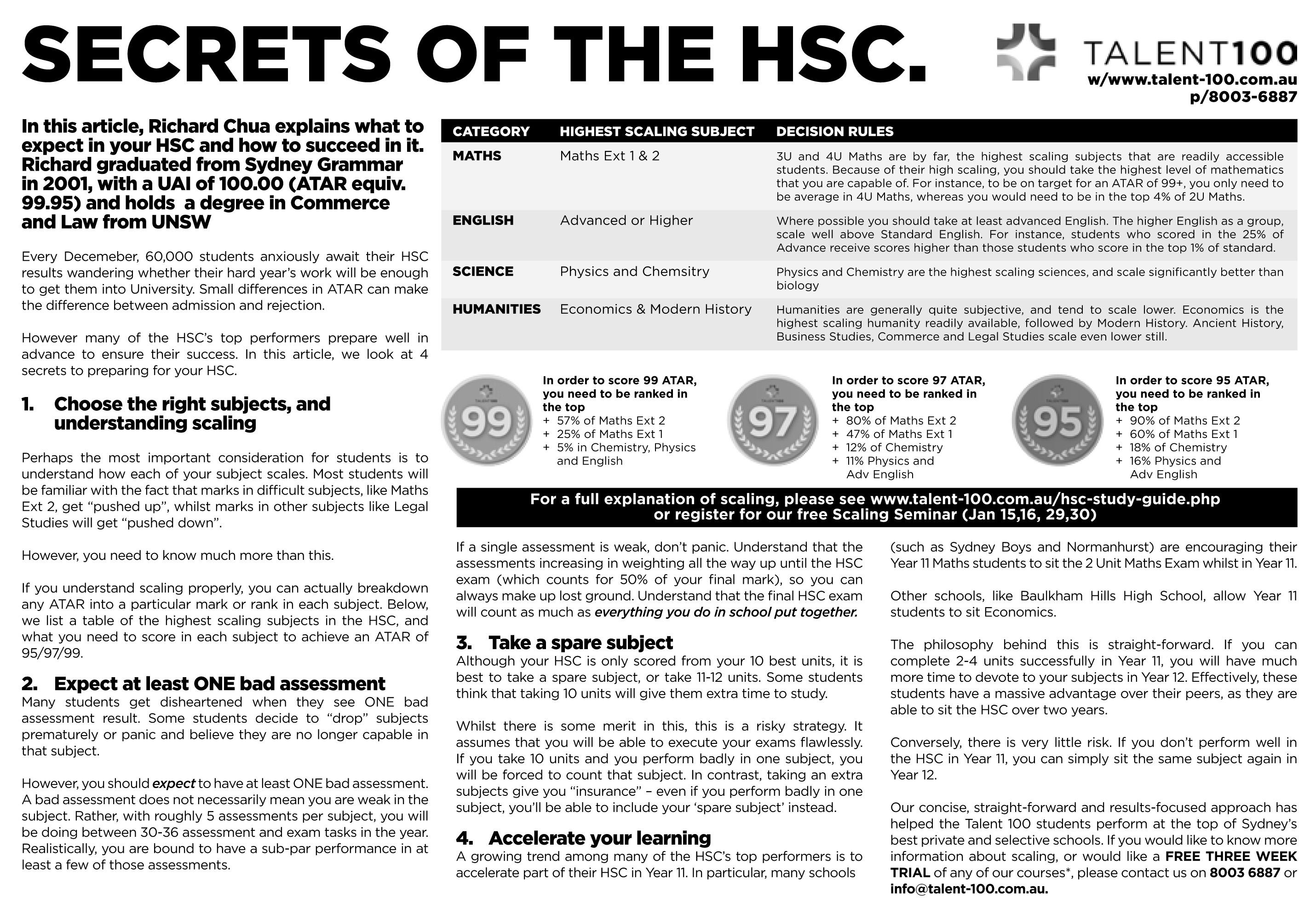
50 <> JULY (2) 2011 INDIAN LINK
The challenge of change
BY SAROJA SRINIVASAN
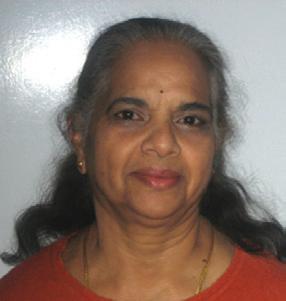
Nothing in this universe stays the same. Change is inevitable. The transience is reflected in the very nature of the universe. Yet, as human beings, we seem to want guarantees that everything will stay the same, be it health, wealth, relationships or whatever else. What is it about change that is so unsettling? Perhaps it is worth understanding the dimensions of change that influence how we cope with it.
The concept of change
If the change is desired or seen as desirable it seems easier, as in following fashions or imposed cultural rules for attire; if it is controllable it seems easier, but if it is uncontrollable as in changes that come with ageing or ill-health, not so; if it is gradual or immediate as in changes in health, we cope with it differently; if it is an important or trivial change as in the decision to migrate versus a dinner menu, the challenge to cope with the decision is different; if it is forced or voluntary as in moving from one country to another as a refugee or a free settler. All these dimensions impose a variety of challenges that influence how we cope with the accompanying fluctuating emotions. When one looks at these dimensions we can see how even within a family, the changes that have to be faced indicate a different dimension for each individual at the time of change. For example, moving from one country to another may be voluntary and desirable and important for one or two members, usually the decision makers, while for another member of the same family it may be important, but not desirable or controllable.
In the eyes of the beholder
Change is often resisted for it would mean moving away from one’s comfort zone, however false this sense of comfort may really be. Perhaps it is a sense of inertia that comes from material comforts or the fear of losing what one has with the uncertainty that change might offer.

Many times we see an almost stoic resistance to change, whatever the issue may be. The importance of the decision given to the change and if it is within their control, seems to influence how one copes
with it. Some will give in to change when it is of less importance to them, almost resigning themselves to it. So if it is important and controllable there is a sense of choice and we cope with it. But if it is important and it is uncontrollable, there is a lot of distress and conflict that may result in unhappiness. Once again, if the change is unimportant but controllable, there is a sense of choice and it becomes acceptable. If the change is unimportant and uncontrollable, the individual may again go along with it even though with some trepidation.
Coping with change
There are some changes that are common to most of us. For example changes in life circumstances such as when one marries or becomes a parent, and the changing expectations that go with them. How one copes with them depends on the amount of choice, the desirability of the change and the preparedness for change.
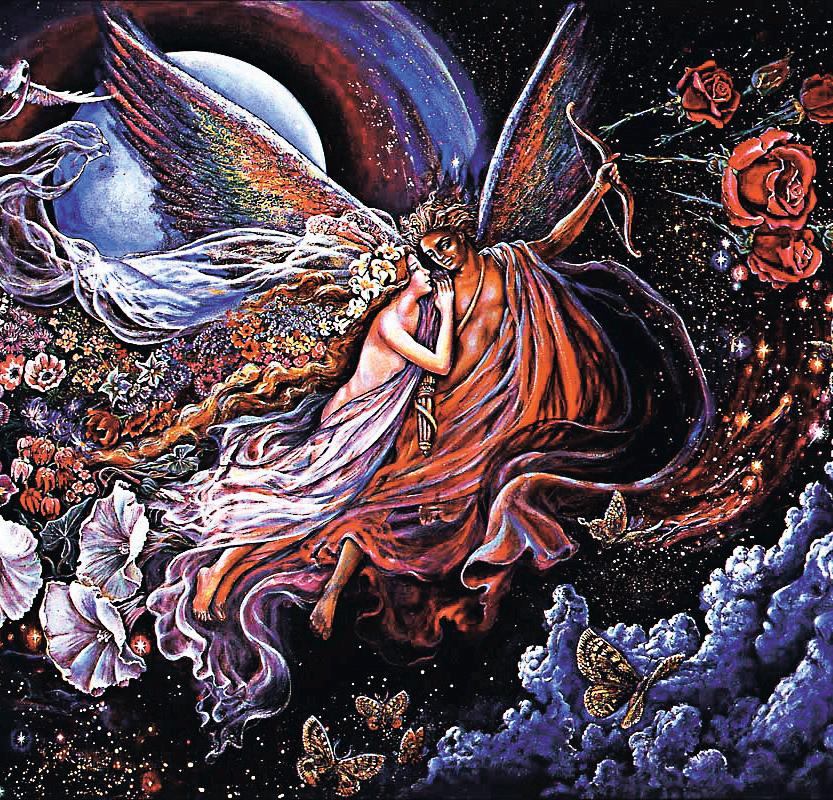
A common occurrence in migrant families is the way some members cope with the changes that accompany the decision to migrate. For example for the older members the generational differences in novel cultures are accentuated. For them, the loss of known emotional buffers and support systems in the new unknown culture becomes a source of distress, for quite often the decision to migrate may not have been of their choice.
So how can we cope with change? Perhaps firstly, we need to develop a good attitude to face changes. Change is a dynamic process that challenges, energises and motivates us and so if we see it as a challenge and not as a problem, we can face it positively. During times of change, most people often go through a feeling of loss followed by denial, anger and feeling out of control. It needs to be confronted and overcome fairly early, beginning with accepting the change and finding ways of dealing with it. One has to move on to a time of exploration of alternatives, perhaps beginning to think that one can cope with the changes. Only then can it be followed by acceptance that the change is here to stay and a strong commitment needs to be made to leave the past behind and find new ways of coping with the present and future changes and challenges.
JULY (2) 2011 <> 51 NATIONAL EDITION
www.indianlink.com.au PSYCHE
It is a part of our lives, but sometimes change can be hard to cope with, depending on one’s situation and attitude
Perhaps it is a sense of inertia that comes from material comforts or the fear of losing what one has with the uncertainty that change might offer
During times of change, most people often go through a feeling of loss followed by denial, anger and feeling out of control

52 <> JULY (2) 2011 INDIAN LINK
The Virtual Robin Hood

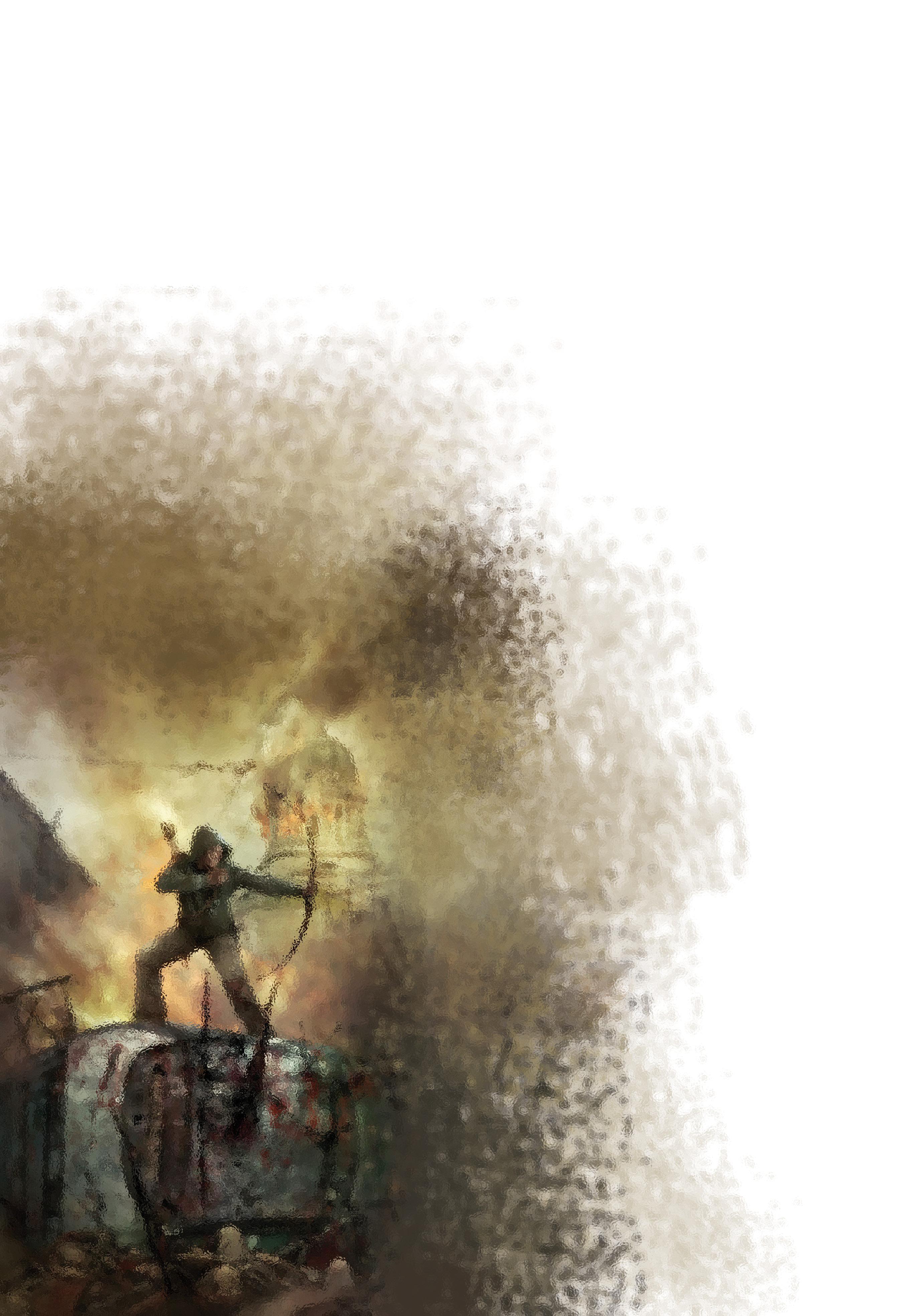
Juggling the roles of mischievous blackmailers and socialist criminals, two disgruntled youth find a way to satiate their material and moral cravings
BY RANI JHALA
My name is best left a secret, for if I give you my name, I will be traced. I will be prosecuted. I was a college drop-out who everyone thought would amount to nothing. For years, it seemed that they would be proven right. At thirty-three I was unmarried and living in the one bedroom apartment that had been left to me by my parents. The small inheritance I had got at their death, paid for my expenses, but, barely lasted for a couple of years. By thirty-five, I was broke and contemplated selling my apartment but finding rental property in an expensive city that was teaming with millions, proved futile and I decided I would keep the only security I had - my apartment.
Finding work was equally difficult. Even a simple job, now asked for a degree as part of the job requirement, and in a country that was churning our MBA students by the thousands, I stood no chance. Penniless but not wanting to ask help from the relatives who had mocked me all my life, I began going to the local temple and lived on the free meal served each night. The meal was made by the priests from donated food and money. Many joined the queue I stood in and each week the line grew longer.
It was some weeks into this routine, that I met a man just a few years younger than me. Unlike me, he held a Postgraduate Degree in Marketing Management. Like me, he too was jobless; always missing out in that last round of interviews, to another, who came with recommendations, the
The temple that once fed us, got 20% of every take. The orphanage from where Alok had been adopted got another 10%. Another10% was given to the homeless. From worthless beggars we became the local heroes
neo- polite term for ‘connections’. Disappointed that he was unable to earn a living or payback the debt his parents had taken on for his education, he had come to the temple to bid farewell to his ‘God’.
As we waited for our meal, we began to talk. Though, we were from different backgrounds, we strangely had shared the same experiences and faced the same fears, mainly of a hopeless future. When we parted that night, both had made a decision. He, that he would not end his life and I, that, I would ask him to share my lodgings. By the end of the week we were roommates. Still penniless but stronger for having found our friendship!
Maybe we were lucky for each other or maybe it was already time for our bad luck to end. Whatever the case was, we managed to get a casual job for the upcoming elections – as data entry clerks. Nine hours every day we sat at the computer and entered details for the electoral. The Electoral department was moving from paper files to electronic ones and hundreds of people had been employed to complete the task. It was mundane
work but it paid a wage and for that, even my over qualified new friend, was grateful.
You will be amazed at what we found out during our time transferring data. The number of people who were duplicating information and distorting facts, obviously for tax evasion purposes shocked us. Owning two or three different properties with slight variations in names and relationships was commonplace. The irony hit us - they seemed to be thriving on cheating while we were struggling to make something of our honest lives.
One night after having one drink too many, we jokingly rang one of these ‘honest citizens’ and again in jest, demanded payment in exchange for silence. We don’t know who was more surprised, the man at being blackmailed, or us, at having our ransom delivered, with no questions asked.

The game had begun. While we entered information, we also monitored and recorded all questionable entries. Soon, the income we made in a week was enough to keep us alive for a year. But greed has an insatiable appetite, and we could not stop the game that had so innocently started from becoming our professional business. As our clientele grew, so did our fortune. A year later we each had bought a 3 bedroom apartment and drove a four wheel drive. Life had become so sweet.
But guilt often ate at our souls. Giving up the game was not possible, so we did the next best thing. We donated some of our ill-gotten wealth. The temple that once fed us, got 20% of every take. The orphanage from where Alok had been adopted got another 10%. Another10% was given to the homeless. From worthless beggars we became the local heroes. No needy person was turned away and no opportunity to increase our wealth was lost. Our material wealth increased in equal proportion to our spiritual health.
We then set up our own detective agency with it chief objective to find more people who were duping the world. Scanning obituaries and the notices section of the newspapers we homed in on our targets. It was during this search that I came across the name of Srimati Seekay Devi in the obituary column. A data match revealed that the woman owned two apartments in a posh
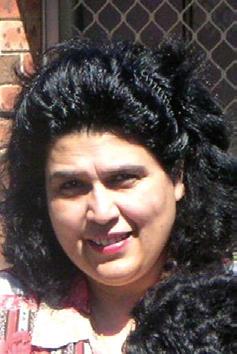
The game had begun. While we entered information, we also monitored and recorded all questionable entries. Soon, the income we made in a week was enough to sustain us for a year
building yet had declared two different men as her husband. What we had earned so far, was small fry compared to what this lady’s estate now offered. It did not take us long to find out which name
www.indianlink.com.au FICTION
www.indianlink.com.au


54 <> JULY (2) 2011 INDIAN LINK
Au naturelle
These beauty rituals and products will make you look and feel your natural best, so that you can exude that no make-up radiance
BY MINAL KHONA
We all love to look our best and pretend we can do so without the help of make-up. Well, research has advanced enough to give you cosmetics that make you look like you are blessed with a naturally rosy complexion and an even skin tone. We share with you some tips on how to have a no make-up look.
Get even
The foundation is what you need to work on first to get an even skin tone. Earlier, one had to apply a moisturiser and then a liquid foundation to get that smooth skin surface.
Tinted moisturisers give your skin the moist look and leave your skin unclogged as they are usually light in texture. It goes without saying that if you have oily skin, choose an oil free one and a cream based one if you have dry skin
Nowadays, you get tinted moisturisers which are a boon for women who have to wear makeup to work as their job requires them to do so. It also works for those who like to look their best at all times and not have to worry about dry skin.
Tinted moisturisers give your skin the moist look and leave your skin unclogged as they are usually light in texture. It goes
without saying that if you have oily skin, choose an oil free one and a cream based one if you have dry skin. Apply a thin layer of the tinted moisturiser with a damp cosmetic sponge or dot your face with the liquid and spread out evenly with your fingertips. You can also use a concealer for problem areas like the under eye or freckles.

Blush right
While one prefers a powder blush at most times, for the natural look it is okay to go with a crème blush. This will blend better with the tinted moisturiser as well. Apply it on the apples of your cheeks and blend with your fingers moving the colour from your cheekbones to the temples. To look natural, go for a light peach or a pale pink depending on what suits your skin tone best. Coat with a light dusting of loose powder, preferably tinted, and do not use the generic talcum powder variety. Dab a little powder on to a puff then dust off the extra powder on the back of your palm and gently pat on your face.
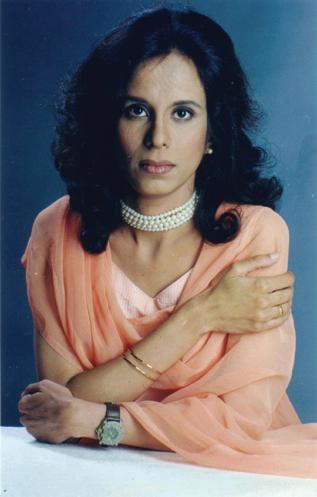
Eye wear
A great way to highlight your eyes is to play around with your eyeshadow. What I have seen many experts do is that they cover the eyelid with one shade of colour that usually complements the colour of the outfit the person is wearing. Then just as you would apply an eyeliner, take a complimentary shade of eyeshadow that matches the colour already applied. Apply with small strokes on the lid just above the eyelashes. You can go with a thin line or a thick line depending on the look you want. If you want a smoky eyed look, then go with a thick line. Top with mascara for the lashes and you are good to go.
Just keep in mind that using shades with too much shimmer in them or shades of greens and blues can look unnatural so apply very little of these shades if you are using them.
Lips don’t lie
This is one part of your face that can look the most natural if you choose the right shade. You get lip glosses that are transparent so your lips have an attractive sheen to them
Lips can look the most natural if you choose the right shade. You get lip glosses that are transparent so your lips have an attractive sheen to them and their natural colour is all the help you need
and their natural colour is all the help you need. But, if you want to use a little colour, choose the shades that belong to the pale pink and nude colour family. Avoid using a lip liner and if you must use one, always do so after filling in the colour and in a shade that is closest to the lipstick or gloss that you have used.
If you have chapped lips, you can also use the coloured chapsticks that are available. They moisten the lips while giving them a hint of colour as well.
If you keep these tips in mind, you can look your best with the least amount of makeup. And the best part is, no one will be able to tell you are wearing any.
BEAUTY

56 <> JULY (2) 2011 INDIAN LINK
Frozen fiesta
A couple of frozen homemade recipe bases can go a long way in preparing a delicious meal on a busy day
BY SHERYL DIXIT
We all have those kind of days when you look into the fridge that’s as bare as the Sahara, and wonder what you’re going to do about dinner?
Anytime tomato spread

I picked up this first idea from a friend of mine who could produce delicious homemade pizzas whenever anyone casually mentioned them at her home. This mix is great, not just because it is homemade and healthy with no preservatives and artificial colours and flavours, but also because it can be a base for several dishes even from different continents. And now, when tomatoes are heading for the $10/kg mark, it helps to be prepared.
2 large onions

3 large tomatoes
1 tsp garlic
1 tsp ginger
Green curry base
I was impressed recently when a snooty delicatessen-cumfruit & veg store advertised fresh coriander at just $3 for a big bunch. Now I’m a coriander freak and it was a bargain too good to miss. So naturally, I bought the bunch and a week later I stared at the barely used, still-fresh leaves reposing in the fridge, wondering what to do with them. It was too much to cook in a short time and coriander isn’t the kind of herb that could take the place of methi or palak. Hmmmm…. And then I hit it! Once again, the freezer offered a solution.
2 big bunches coriander
1 large onion
1tbsp ginger
1 tbsp garlic

3 green chillies (optional, depending on taste)
1 cup fresh grated coconut
1 tsp whole cumin
1 tsp turmeric powder
2 tbsp channa (gram) dal

It’s 6:30pm, you were delayed at work, late to pick up the kids from after school care and are too tired and irritated to go beyond the basics. To make things worse, the kids are already ratty and asking for dinner. It’s a dilemma which would try your patience and knock you off the supermum pedestal….
So how do you handle dinner without pulling out chicken nuggets and curly fries from the freezer without feeling a
3 green chillies (optional)
2 tbsp oil
Chop the onions, ginger, garlic, chillies and tomatoes finely and keep aside, separately. In a kadhai or pan, heat the oil and fry the ginger and garlic together. After a minute, add the onions and chillies and fry for 3-4 minutes, until the onions are softened. Next, add the tomatoes and continue frying on medium flame until the tomatoes are soft and have blended well with the rest of the ingredients. Turn off the fire and let the mix cool down completely. Divide the mix into small portions (normally four with this quantity) and place into small containers or freezer bags. Freeze and use whenever needed.
The good thing about this recipe is that it can work for many different kinds of food, but its best to not use any kind of masala when cooking. The basic ingredients lend themselves to variety so you can thaw out a portion, drop in a bunch of Italian herbs and make a tasty pizza topping to spread over the base. Or use a tadka of turmeric, rye, a couple of dried red chillies, some cumin/coriander powder and toss in a bunch of mixed veggies. Voila, your dinner is ready. Or add a bit of masala to the mix, along with meat or chicken. You can even use this for a quick pulao preparation.
nagging sense of guilt?
But with a bit of hindsight and the use of that same freezer, there could be an easy solution.
Now some of us are still uncomfortable with the thought of freezing whole meals and thawing them a couple of months later, but preparing recipe bases that lend themselves to a variety of dishes is certainly an option.
Soak the raw channa dal in water for at least an hour. In the mixer, add coriander, onion, ginger, garlic, chillies, cumin, drained channa dal and grind coarsely. Add grated coconut and turmeric powder and grind again, until the mix turns into a smooth chutney. Remove and divide into 4-5 equal portions, and freeze in small containers or freezer bags.
I’ve realised that this mix works well as a base masala for green curries of any sort, but a fish or chicken preparation offers the best results. After heating the oil, add a few cloves and peppercorns, then sauté the fish. Thaw a portion of the mix, further dilute with water or coconut milk/cream to form a curry of the consistency you prefer. Once the fish is cooked, turn the flame on low and add the mix, cooking gently until the masala changes colour and becomes slightly darker. Take care to cook on low flame, to help the mix blend with the fish. You can use the same method with chicken, or even fry the masala in the oil before adding the cooked chicken. But best of all, just add salt to the mix in its original form and serve as a spread. You won’t taste a better chutney sandwich with your chai! There are a few things to remember when preparing these mixes.
As much as possible, use natural ingredients and only the ones that are pretty much standard in your cooking. So if you don’t use garlic, leave it out of the combination Try not to use prepared masalas in the mix, as this limits the use of the combination. For example, adding chicken masala to the tomato mix will make an odd-tasting pizza base
Avoid adding salt to the mix as when it is used in its final form, you won’t go wrong in making the dish too salty or vice versa
In the coriander mix, you can leave out the coconut entirely, and still use the mix as a base. Add coconut when cooking, if needed.
Experiment a bit, like add some lemongrass or mint to the coriander mix for a tastier, more exotic option
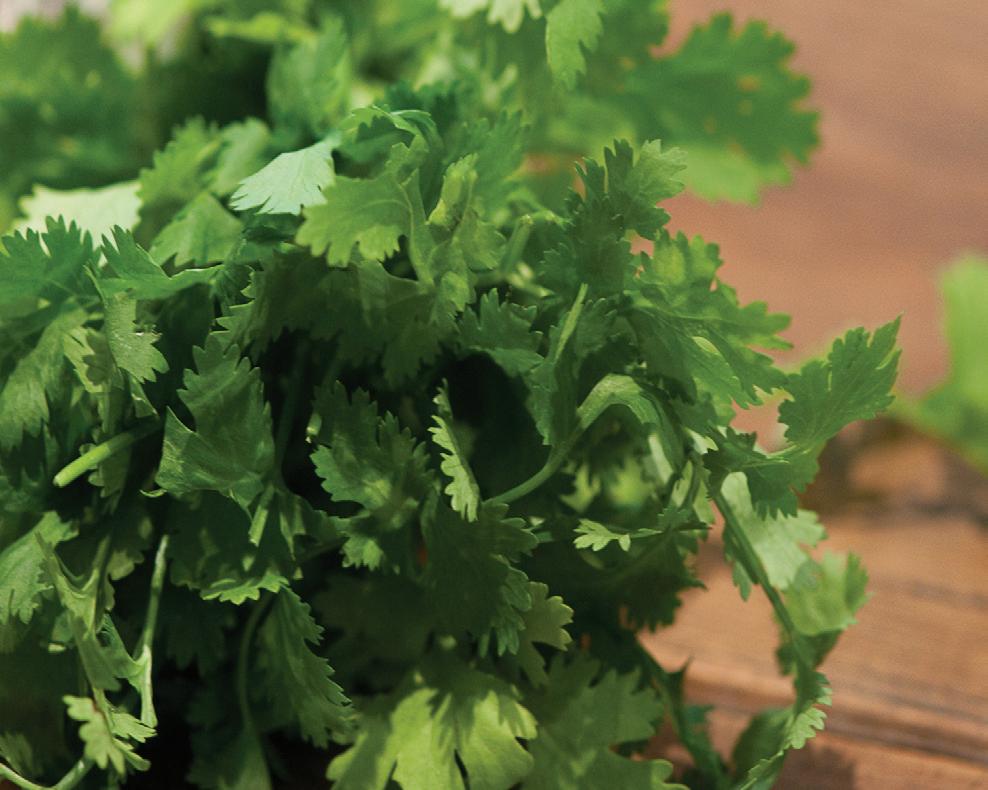
If you’ve opened a full can of coconut milk or cream, freeze the rest in plastic ice cube bags or trays, then use as desired. However, its always preferable to thaw this ingredient when adding it to a dish.
So there you go with a couple of easy fixes to help end a rough day with a delicious meal fit for a gourmand.
Avoid adding salt to the mix as when it is used in its final form, you won’t go wrong in making the dish too salty or vice versa
JULY (2) 2011 <> 57 NATIONAL EDITION
www.indianlink.com.au
FOOD
Now some of us are still uncomfortable with the thought of freezing whole meals and thawing them a couple of months later, but preparing recipe bases that lend themselves to a variety of dishes is certainly an option
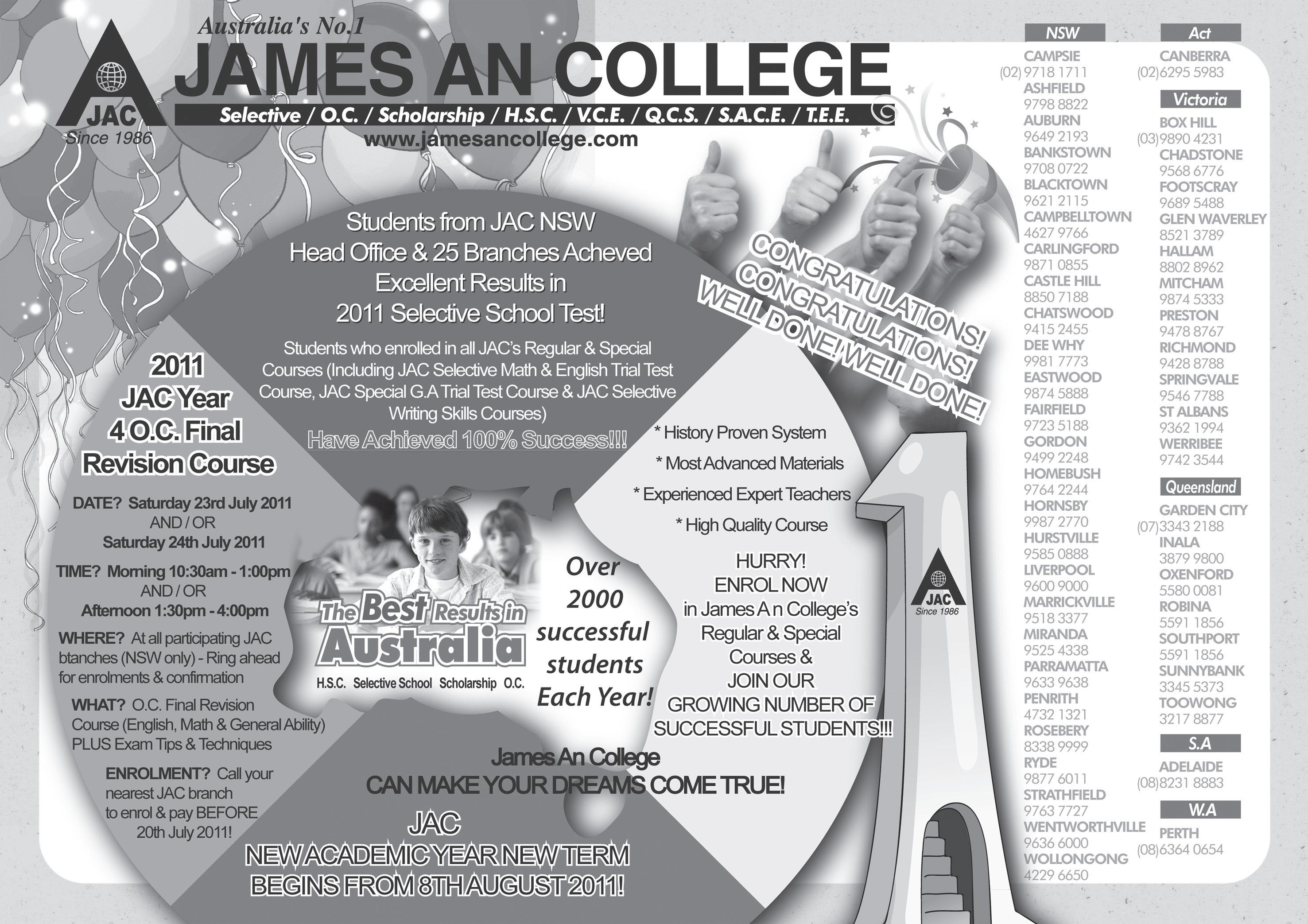


DID YOU KNOW…
1. Australia invented plastic-covered bank notes.
2. The Australian dollar was introduced in 1965. Suggested names for it were: the Boomer, the Roo, the Kanga, the Digger, the Royal, the Kwid, the Dinkum and the Oz.
$
3. Bet you’ve dreamt of trillions of dollars. In Zimbabwe, they actually had this as money – even a 100 trillion dollar note. But it was so miniscule in value (you could barely buy a dozen eggs with it) that in 2009, the use of Zimbabwe’s money was officially ended. Now they use South African or Botswana money, or pounds, US dollars and Euros.

4. More money in the world is spent on weapons than on education or health.
5. Money is the leading cause of disagreements in marriages.

6. Hitachi ATM machines in Japan actually launder the money. They briefly press the notes between rollers at high temperatures to kill most bacteria.
7. Paper currency was first developed in China in the Tang Dynasty during the 7th century.
8. Banknotes are made from cotton paper mixed with linen or other textile fibres.
9. A third of the world’s people live on less than $2 a day.
$ $
MONEY MONEY MONEY
FUNNY MONEY


Whoever said money can’t buy happiness simply didn’t know where to go shopping.
Bo Derek
MONEY QUIZ
Money is not the most important thing in the world. Love is. Fortunately, I love money.
Anonymous
Money, if it does not bring you happiness, will at least help you be miserable in comfort.
2. England b. Manat
3. Denmark c. Yuan
4. Kazakhstan d. Riyal
5. Poland e. Ringgit

6. Malaysia f. Zloty
7. Saudi Arabia g. Tenge
8. China h. Krone



$ £ ¥
Helen Gurley Brown
Money isn’t everything but it sure keeps you in touch with your children.
J. Paul Getty
9. Azerbaijan i. Pound Sterling
10. Bulgaria j. Peso
CONVERSATIONS
Devna: Manan, I’m writing something for the Kids’ Page. So tell me, what have you been doing in the holidays?
Manan: PS2, 3DS, DJ Hero, Guitar Hero, Xbox, FIFA11, Skyped my friends, saw Kungfu Panda, Harry Potter 7, Simpsons, Masterchef…

Devna: Mum’s going to read this you know…
¥ ¢ ¢
No matter how rich you become, how famous or powerful, when you die the size of your funeral will still pretty much depend on the weather.
Michael Pritchard
What’s the use of happiness? It can’t buy you money.
Henny Youngman
Why is there so much month left at the end of the money?
John
Barrymore
I’m so naive about finances. Once when my mother mentioned an amount and I realised I didn’t understand, she had to explain: ‘That’s like three Mercedes.’ Then I understood.
£ $
¢ £
Brooke Shields
£
PEARL OF WISDOM: I don’t care too much for money – money can’tbuymelove. The Beatles
A penny saved is a penny earned.
PEARL OF WISDOM: If you want to feel rich, just count the things you have that money can’t buy Unknown
PEARL OF WISDOM:
Benjamin Franklin
Match the countries to their currencies 1. Chile a. Lev
1j, 2i, 3h, 4g, 5f, 6e, 7d, 8c, 9b, 10a.
Answers
¥ ¥
Manan: OK then put tennis, piano practice, maths, 100 jumps on trampoline daily, washed the car, unloaded the dishwasher 3 times, cleaned my room, walked the dog. ¢
£
Help Required
Restaurant for Sale
Well organise Indian restaurant in a Highly Posh area (Hunters Hill).
Very good location with the Water view.
• 2+3 yr lease • Fully licenced and B.Y.O
• Open 7 nights and can open for lunch and breakfast
• 60+ seater • Take away and home delivery as well
• Plenty of free parking • Close to city • All new utensiles
• Newly renovated Kitchen • Heaps of regular customer
Urgent Sale due to family commitment.
Asking price around $ 42,000 (geniune offers only) Price is negotiable.
For any other inquiery Call at 0430 482 786


I Syeda Falak a Karate kid pursuing the art of karate for the last five years , from Hyderabad India.
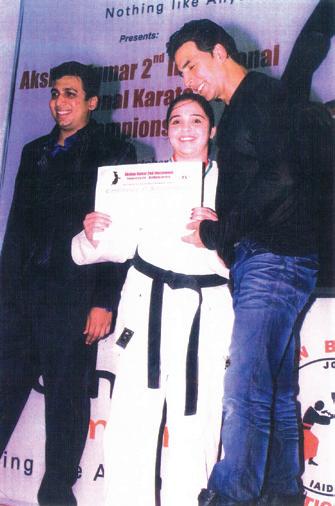

I am selected by All India Karate Federation to represent India ,to be held at Witlam Leisure center Sydney Australia 26th to 31st july 2011.
As the whole expenditure is estimated to a tune of $2000.00 Australian dollars it is highly required to seek sponsorship from the corporate sector or available resources.Therefore I my sincere request to sponsor me for the event in order to bring fame pride and fame and respect to India and the sponsors through my possible success in the Common Wealth Championship.
Interested may please get in touch with Mr.Shaw on 0426239991
email id: shawminfeedback@hotmail.com.au
Disclaimer
:
Indian Link takes no responsibility for the content or claims made in any advertisements in the print, radio or online editions of the media group. We strongly urge that you verify the claims made in the advertisements prior to using any services.
If you are not happy with any of the services provided, please use the relevant consumer laws to protect your interest.
60 <> JULY (2) 2011 INDIAN LINK

JULY (2) 2011 <> 61 NATIONAL EDITION
BUZZThe
Amrita shoots for PETA

ABHILASHA SENGUPTA brings us up-to-date on
hot and happening in Bollywood
After Shahid Kapoor, Amrita Rao has now shot for a new pro-vegetarian advertisement for the animal rights organisation People for the Ethical Treatment of Animals (PETA) India. The 30 year old actress and proud vegetarian looks casual in a pair of shorts and a clingy T-shirt that reads “Powered by Tofu” in the ad, through which she proclaims: “I Am Amrita Rao, and I Am a Vegetarian”.

“I call being vegetarian the Wow Rao diet. Wow because I know that being vegetarian is the best thing I can do for myself, the animals and the environment,” said Amrita said in a statement.
“Pulses can get pulses racing, while corpse cuisine slows you down. Kick the meat habit and you’ll look and feel better than ever,” added the actress, who featured in films like Main Hoon Na and Vivaah.
Freida n Franco
Apni desi Freida Pinto seems to be going places in Hollywood, starring opposite a whole range of exciting actors. The latest in the bandwagon is none other than James Franco, who, Freida says, has a distinctive style of acting. The young actress says she was taken aback by co-actor James Franco’s style of acting. The two are working together on Planet Of The Apes, where Pinto plays a scientist and girlfriend of Franco’s character in the upcoming prequel.
AMRITA RAO ? GUESS WHO
She started her career inPunjabifilmsbefore makingamemorable Bollywooddebut in Dev D
“He’s got his own unique and distinctive style of acting. It’s not conventional at all. It does take you by surprise initially, but it’s all about being flexible and trying to understand how another actor works. I found a lot of things in his acting style that I could pick up and learn from,” she said. Well now Freida, we’re all waiting n watching, so don’t ape him but do us proud!
Oh brother, its Zafar!
Pakistani pop star and actor Ali Zafar is mighty excited these days. Can’t blame him, particularly as he’ll be sharing a live stage with the gorgeous Katrina Kaif and eyecandy Imran Khan. The trio will perform live to promote Mere Brother Ki Dulhan and they’re set to burn up a lot of energy at Zafar is a seasoned stage performer, so the producers have asked him to help Kat and Iran acclimatize themselves to live performances. “Maybe my USP is live singing. But they will take to the stage quickly. I know we’ll have fun,” said Zafar Zafar was recently voted the hottest male actor of 2011 in a survey, and will soon be returning to India to star in another film.
“Before I do David Dhawan’s Chashme
I’ve signed another film in Mumbai. As for being voted the hottest star, I’m grateful to all my fans who have voted for me,” said the actor. Now with three hotties on stage, wouldn’t that be a show worth
Like father, like son!
Farhan Akhtar is riding the wave and enjoying every minute of it. The just-release Zindagi Na Milengi Dobara (ZNMD) has been hailed as a hit, and he plays one of the three key leads in the film. But Farhan Akhtar credits his lyricist dad Javed Akhtar for writing some impeccable dialogues laced with poetry for the movie, which is coincidentally, directed by sister Zoya. “It’s so fantastic that everyone loves the poems in ZNMD. Thank you pa @Javedakhtarjadu for injecting soul into the film with your gifted hand,” Farhan wrote on his Twitter page.
Rao joins a growing list of celebrities like Lara Dutta, Pamela Anderson, Shahid Kapoor, R. Madhavan and Anil Kumble, who have teamed up with PETA to promote a healthy vegetarian diet. And looks like the actress will soon have a lot of converts to the cause. ?
The movie is a delight, not just because it is easygoing and stars Hrithik Roshan, Katrina Kaif, Farhan Akhtar, Abhay Deol and Kalki Koechlin, but also for its stunning cinematography. It has already picked up fans in Bollytown, as filmmaker Karan Johar seems to have liked the film so much that he is asking everyone to watch it. “Please go watch ZNMD....now!!!! Zoya has pulled off a tough genre with utmost sincerity and flamboyance...zoya is the hero of the film!!!,(Sic)” Karan posted on microblogging site Twitter. Well, it certainly seems like talent runs in the Akhtar family….
Hints from Harman
Up there among Bollywood’s tall, lean and tasty, is actor Harman Baweja who admits that he follows a fitness routine, but he doesn’t believe in bodybuilding.
“Normally, I give myself 40-45 minutes a day in whatever form I can. I have pretty much given up on proper workout in a gym because now I believe in fitness and not in
body building,” claimed the actor.
“Definitely, when I will do an action film or something similar, I will require hardcore training and I will go back to bodybuilding. But right now it’s more about being fit and lean so I play tennis often, that’s good enough to burn calories,” said Harman who has mainly been a sportsperson. “I like sports, and I have resorted back to being a sportsman rather than just running on the treadmill. I’m more of an outdoor person,” he added.
Harman, who has been part of films like Love Story 2050, Victory and What’s your Raashee? is also a self-proclaimed foodie.
“I eat anything under the sun. I’m a foodie, so I don’t work on my diet but I burn out according to what I have eaten,” he specified. Thanks, hunky Harman, for letting your fans in on your fitness mantra.
Only Hashmi!
Vishal Bhardwaj has made his decision and he’s sticking to it! The film-maker has cast Emraan Hashmi for his forthcoming flick Daayan, and he doesn’t care if some actresses will not work with the star. Clearly, Emraan is his top priority. “Both Vishal and (producer) Ekta Kapoor believe Emraan is the fulcrum of the script and the only non-negotiable member of the cast,” claims a source. “Vishal thinks Emraan has huge potential. He wanted to cast Emraan in 7 Khoon Maaf in the role that Irrfan Khan eventually did, but it didn’t work out,” added the source Emraan’s going to be busy over the next few months. He’s pretty much in demand
62 <> JULY (2) 2011 INDIAN LINK
what’s
ENTERTAINMENT
with several topnotch filmmakers like Rohan Sippy, who will cast the actor in his next flick. Apparently Dibakar Banerjee chose Emraan at the cost of losing Katrina Kaif in his new film Shanghai.
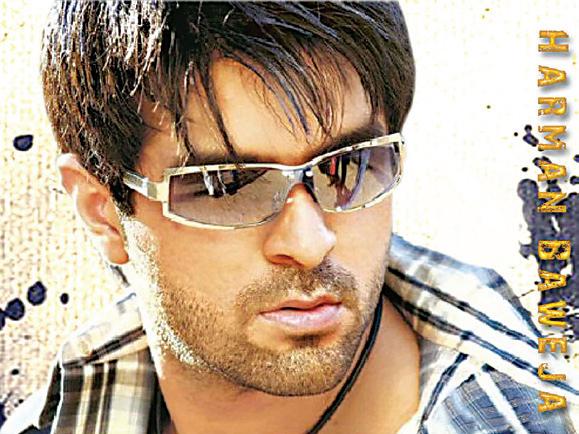
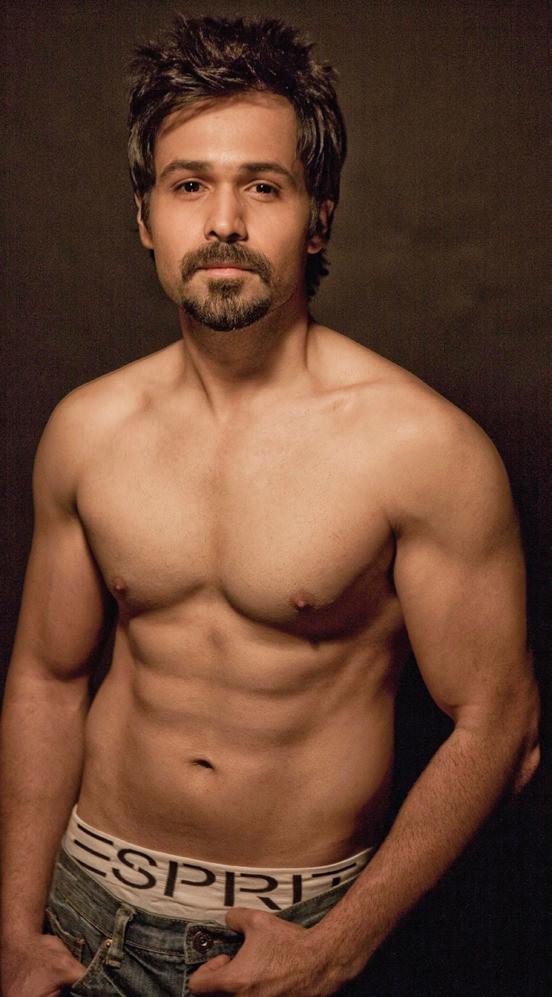
Vishal will shoot Daayan soon, and his hunt for the three leading ladies is almost over. The buzz in Bollywood is that Jacqueline Fernandez, Chitrangda Singh and Mahie Gill have been shortlisted for the three parts. Lucky Emraan, seems like he’s finally in the cream of the crop!
Kashyap’s tribute
Filmmaker Anurag Kashyap, who was co-producing late director Mani Kaul’s unfinished projects, is determined to complete them.
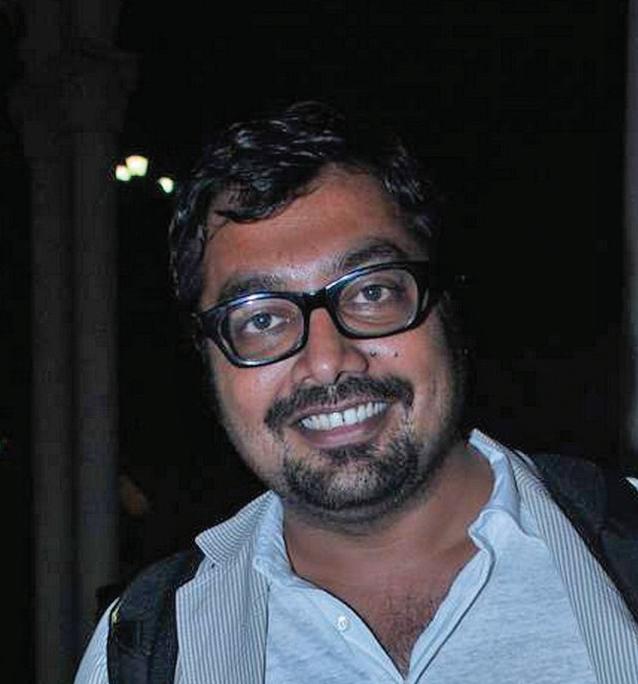
Kaul, who was believer of “new and bold cinema”, passed away July 6 in Delhi following prolonged illness. He was 66.
“One is She Under Her Spell, the other is Deewar Mein Khirki Rehti To. He also wanted to work on another book Rossilline. I was producing the films with NFDC (National Film Development Corporation of India) and other three four producers abroad, Kashyap, who is known for co-producing internationally accalimed Udaan, said. “I want to do those films, but I have to sit with everyone to decide how to go about it. But Rossilline would be surly made.”
Remembering his days with Kaul, Kashyap said: “I can’t believe that he is no more. He was just an incredible teacher and a great friend and someone who never looked down upon anyone.”
Kashyap, known for directing movies like Black Friday and Dev D, confirmed the theatrical release date of his much talked about film That Girl in Yellow Boots, in which his wife and actress Kalki Koechlin plays the protagonist.
“That Girl In Yellow Boots is releasing on 2nd September,” he said.
The thriller traces Ruth’s (Kalki) search for her father, a man she hardly knew but cannot forget.
Kashyap’s other two films, Gangs of Wasseypur and Michael, are in the post-production stage and he said that they would release this year.
Kirron rues the fame game
Kirron Kher has a strong viewpoint about the name-fame game. With the epidemic of reality shows on television, people the world over appear to have been infected with the fame disease, said the versatile actress who will be seen judging the third season of Colors’ reality show India’s Got Talent.
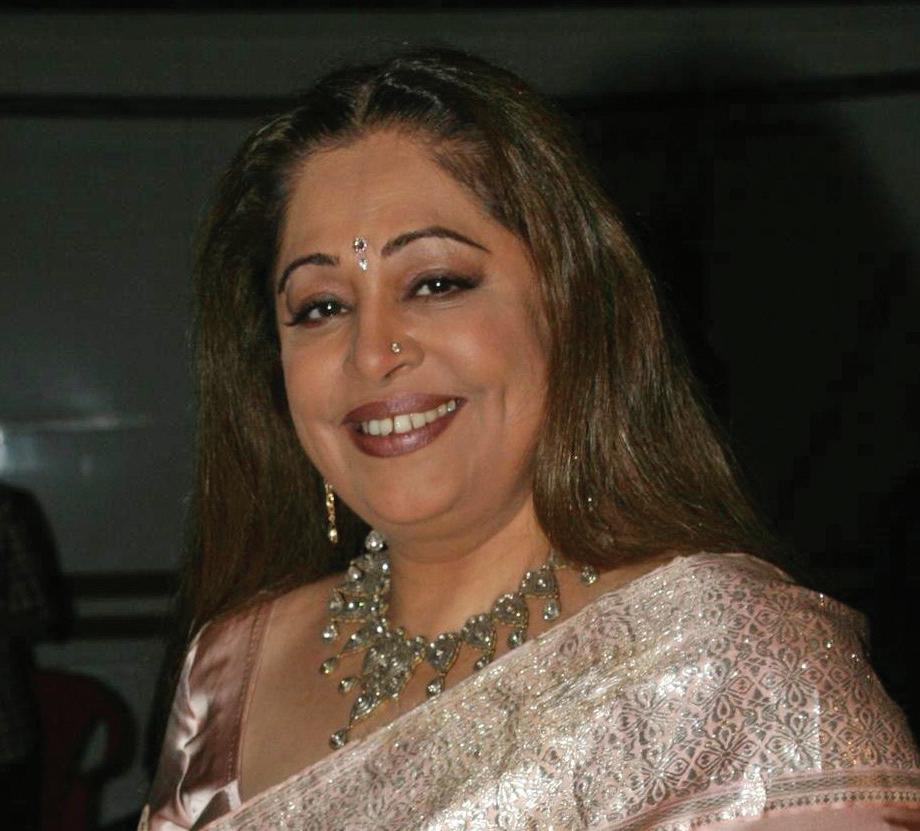
“Right now there is an epidemic of reality shows and also of talented people across the world. People have been affected by the concept of ‘one minute fame’. This is actually a problem with television. The whole world is getting crazy about coming on television for some reason or the other,” said Kirron in an interview.
Declaring the trend a tragedy that has hit television, she said: “It is not only in India but even in the west you have these crazy shows like ‘Jerry Springer’ where people come and abuse, they take off their clothes, do everything possible just to become famous and known.”

It is a world that has become very celebrity conscious, she added.
The 56-year-old, known for her powerful performances in films like Sardari Begum (1996) and Bariwali (1999) and also in mainstream films like Dostana (2008) and
Devdas (2002), feels the “page 3” lifestyle has given rise to this trend.
“It started with page 3 actually, where everybody who is a nobody wanted to be somebody and the only way that they could be was by getting some photos in the paper... and now everybody wants to be on the screen for the same reason. That has become a disease not only here in India, but everywhere across the world,” she said.
Ironically, Kirron’s show seems to have opened doors for rural India.
“But it also opens the window for us as well. I feel privileged to sit there and be part of the diversities our country has. It’s an eye opener to see people coming with the wide variety of art forms which I would not have had the privilege to see otherwise,” she said. “They come from little, little cornersdistricts. It’s a vision of glory and, honestly, it opens a window for them to reach mainstream and for mainstream India to see what India is all about,” she added. The actress, however, feels that sometimes over-ambitious parents force their kids into doing something they have not been able to do.
“Everybody is looking for immortality. Over-ambitious parents come, make their children go through drills to perfect their act, but they forget what their child actually wants to do and where his interest lies. They only make him do things that they couldn’t do due to some reason. It is very sad for children. It’s ridiculous; whom are they giving birth to, zombies?” she said emphatically. Kirron admits that working on the small screen is way more exhausting than working in films. The actress who will next be seen in Dostana 2 said, “In TV one has to give 13-14 hours of your day. It makes you dead tired. At times, we are so tied up that we don’t even get time to go in our vans and relax. With cameras on your head all the time and photographs being clicked it becomes really tiring. In films, our shoots are distributed in such a manner that we don’t feel pressurised. But here you can’t take it lightly because the show has to go on air. You can’t afford to skip even if you are unwell. This is one of the biggest drawbacks of television,” she explained ruefully.
Kirron has received several national and international awards for her acting skills and continues to do well. We wish her all the best in bringing India’s talent to the fore
Rakeysh Mehra’s next
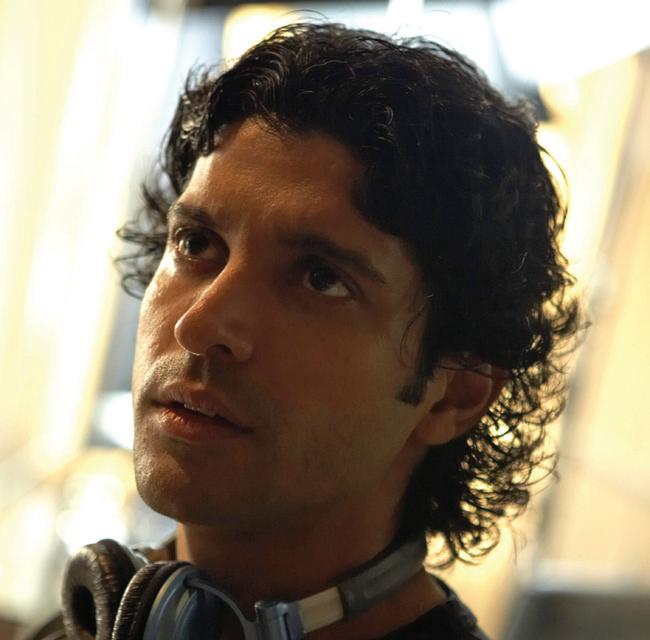
Filmmaker Rakeysh
Omprakash Mehra says he is working on several scripts, but his next will the film on iconic Indian athlete Milkha Singh.
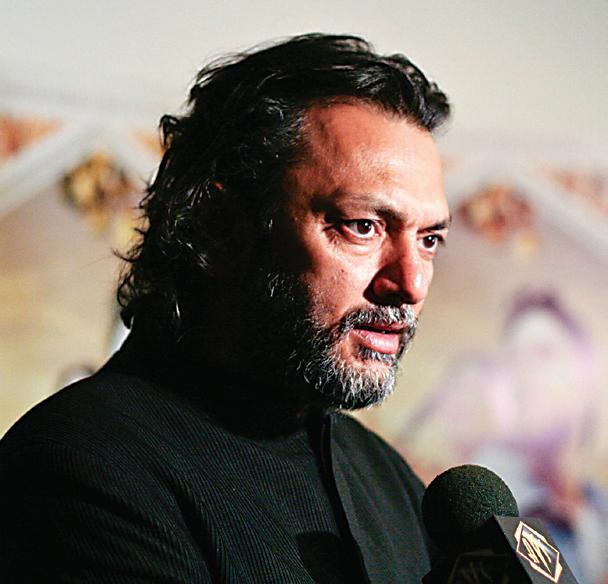
Milkha Singh came fourth in the 400 metres at the 1960 Rome Olympics. He also represented India in the 1964 Tokyo Olympics.
“I am writing a few scripts but my immediate next film is Bhag Milkha Bhag. I would start shooting it now. It’s on Milkha Singh the athlete,” Mehra revealed.
Soft-spoken Mehra refrained from divulging any other details, saying, “It’s a secret”.
Mehra, after directing numerous ad commercials like Coke, Pepsi, Toyota, American Express and BPL, made his directorial debut with megastar Amitabh Bachchan starrer Aks in 2001. The film was not a big success, but he rocked the box office with his 2006 release Rang De Basanti. His last was the 2009 movie Delhi-6 starring Abhishek Bachchan-Sonam Kapoor.
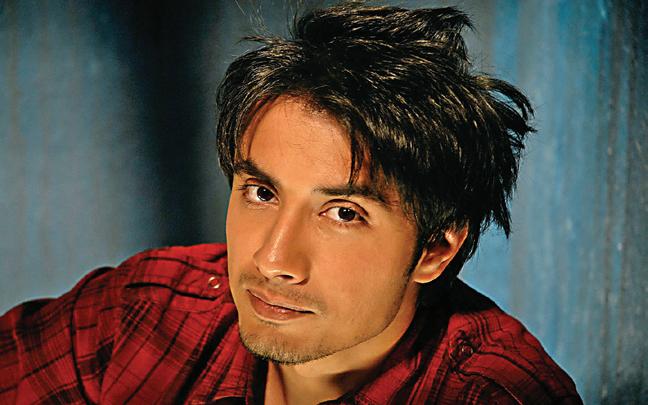
CAPTION CONTEST
What did Salman say to make Lara break into a smile?
Send in your responses to info@indianlink.com.au and win a surprise prize
Last issue Caption Contest winning entry
What’s the chitchat here between Salman and Karisma?
Karisma: “I’ll dance with anyone who can help me resurrect my career”.
Salman: “I’ll dance with any good-looking babe, period”.


Rupinder Sahni West Ryde NSW
Rupinder wins a free ticket to new release Singham
JULY (2) 2011 <> 63 NATIONAL EDITION
www.indianlink.com.au
GUESS WHO :ANSWER Mahie Gill
EMRAAN
FARHAN AKHTAR
FREIDA
RAKESH
KIRRON KHER
ALI ZAFAR
HARMAN BAWEJA
ANURAG KASHYAP
Cine Talk
Desperately dark film
Film: Murder 2
Cast:Emraan Hashmi, PrashantNarayanan, JacquelineFernandez, SulagnaPanigrahi
Directedby: Mohit Suri
The sequel to Murder is nothing like the first part of the frenetic franchise. And Jacqueline Fernandez who has been built up in Murder 2 as the next Mallika Sherawat is nothing like the overrated Mallika….thank God for that! Fernandez exudes an unbridled sunniness even when pouting in the bare minimum. Alas, she doesn’t have much to do in Murder 2 except swathe the dark drama in a spot of sunshine.
God knows this film about the devil-unleashed, surprisingly written by a woman (Shagufta Rafique) needs that little of sunshine. It is a desperately dark film. The characters are wretchedly unhappy. No matter which side of the moral line they are positioned they are standing screaming into the abyss that is suburban life. These people need serious help.
This then, is the world Mahesh Bhatt has bequeathed to us. Take it and bleed it.
Director Mohit Suri who earlier took us on a jolting trip through the world
of prostitution, pimps and desperate cops in Kalyug takes the same route again. On this occasion the journey is far more ruthless and rigorously implemented to create horror repugnance and hatred for a word that we’ve created for coming generations.
In the typical Mahesh Bhatt style Murder 2 doesn’t waste time in back-projections and story build-up. He goes straight for the kill. With trenchant immediacy director Mohit Suri (back in Kalyug form after the misfire that was his last film Crook) tells us the story of a psychopathic killer who kills prostitutes with the pleasure that makes your stomach churn and look anxiously towards the future about your daughter who is just stepping into the big wide world.
Who knows if the man sitting next to her in the movie theatre is a closetnutcase with a collection of hacksaws in his house, and not to carve up the Christmas turkey.
Prashant Narayanan as the psychopath plays the character at such an even pitch he makes your blood freeze in fear and revulsion. Here’s a man who could be that ghoul who butchered all those kids in the Nethra killings and then ate them up without a burp.
The ‘hero’ in Murder 2 is a burn-out suspended cop who makes money out of criminals, stays sullen and haunted throughout the film except when he goes for the kiss, and offers
his girlfriend a wad of notes after making love. To buy the fridge, he says. Naturally the lady freezes.
Force of habit, we say. Hashmi has done this kind of a role repeatedly. The kissing and vigorous bedroom activities are quickly taken care of in the first 15 minutes. Wouldn’t want the lovers of the serial kisser to feel they’re being cheated in favour of the serial killer.
The wacked-out killer in Murder 2 doesn’t eat his victims. He just cuts them down to sighs…and groans and shrieks of pain and records their dying voices to get his rockers off….
The plot seems original. The narration is clenched and the characters driven by a desperate urge to assert themselves before death rings their doorbell.
The savagery with which the college-going call girl (Sulagna Panigrahi) is brought to her gruesome death becomes a metaphor for the
loss of innocence and the triumph of diabolism that is often garbed in designer labels these days.
Murder 2 is not a pleasant film to view. The psychopath’s killings are done in graphic detail. The storytelling offers no respite from the brutality. Most of the time we are looking at happenings that we would rather not see. But see, we must.
Murder 2 is a mirror of our amoral venomous times when no relationship is sacred anymore. Mohit Suri remains in command of the murky material and traumatized characters. While most episodes hold together in a riveting rhythm of life’s most unsavoury truths, the sequences featuring Prashant Naraynan work better than the rest of the film. He lends the proceedings a credibility that is unsettling.
 Subhash K Jha
Subhash K Jha
Small film, huge heart and talent
Film:ChillarParty
Cast:Irrfan Khan, Sanath
Menon and Naman Jain
Directedby:Vikas Bahl, Nitesh
Tiwari
At one point in American history, dogs and blacks were not allowed in public places. During the British occupation of China, it was ‘dogs and Chinese’ while at the first Mumbai marathon the rule was against dogs and wheelchairs. A dog has thus become a metaphor for seclusion, for denying someone their fundamental rights.
Chillar Party uses this metaphor in a brilliant, but hilariously entertainment manner to make a statement against those who seclude, be it Shiv Sena in Mumbai, fanatic Hindus who want Muslims out of India, or upper class Hindus who refuse lower caste people basic rights etc. That it does so while making you laugh, is its greatest strength.
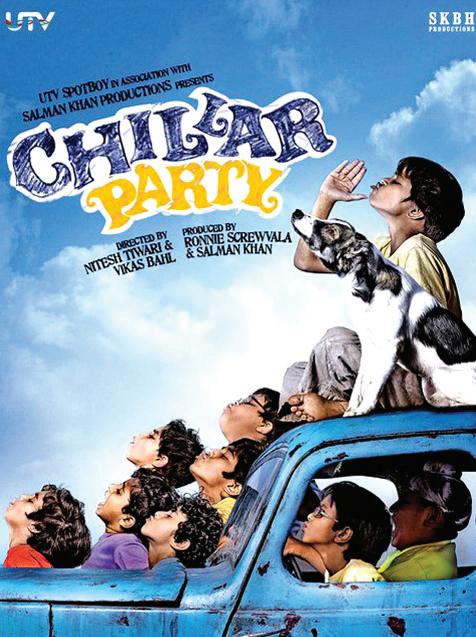
After a street kid Phatka (Irrfan Khan) and his stray dog Bhidu begin cleaning cars in a rich locality, the rich,
school going kids first try to fend him off, but later become great buddies. When a minister offended by the dog passes a law to ban all street dogs from Mumbai, the kids resort to some unconventional activism to save their beloved dog. But is it even possible for the powerless kids to take on a high and mighty minister?
Chillar Party, in essence, is a children’s film. But those who can read between the lines and see between pictures know that the most brilliant, imaginative and metaphorical literature and cinema in the world, are for kids.
Thus in literature you have your The Prince and Gulliver’s Travels, while the films of Iranian auteurs, though simple and innocent, attack an unjust system. Chillar Party is a welcome addition to these greats of world cinema.
Yet, what does a children’s film need to be good? A simple story, good metaphor, oodles of cuteness and innocence, fun and humour and a band of actors to carry it all off. If you have these, any other drawbacks can be excused. Chillar Party has these and much more.
The film is filled with observations and idiosyncrasies that will leave you laughing your guts out. Every child in the film has acted with such restrained understatement that they give your popular stars a run for their money. And yet, beyond all these beautifully working elements, it is the metaphor of the dog that takes the cake.
Unlike nature, the world of humans is full of seclusion. Thus a Bal Thackeray in the 1960s wants the South Indians, in the 1990s the Muslims, and now the North Indians out of Mumbai. Fanatic Hindus want Muslims out of India. The Americans wanted blacks out of America. The Australians want Indians out. The Sri Lankans want the Tamils out. The list is literally endless. But as the film so valiantly, sincerely and emotionally argues, what is needed is inclusion.
Chillar Party is filled with allegorical moments that hint at how the poor, the disenfranchised, the adivasi, the handicapped, the minority survive. When the rich kids take away his cleaning cloth, Phatka has no qualms about washing cars with his only tshirt. The rich consider poor to be pests and want them out, but the poor
strive and ironically serve the same rich. Some, pushed to the edge, take up arms against mighty odds, like in the tribal belts of India.
Besides saluting the creative genius of writer-director Vikas Bahl and Nitesh Tiwari, one has to bow to UTV and Salman Khan, for flexing their muscles for something so beautiful. Chiller Party may be a small film. But as cinema goes, in its adroitness, it is much more mature than 99 percent of the films ever made in India. And that, you’ll reckon, is no ‘small’ achievement.
Satyen K. Bordoloi
64 <> JULY (2) 2011 INDIAN LINK
www.indianlink.com.au
Male bonding taken to another level

Film:ZindagiNaMilegi
Dobara
Cast:Hrithik Roshan, Katrina Kaif, Farhan Akhtar, AbhayDeol,KalkiKoechlin

Directedby:ZoyaAkhtar
Some movie experiences can be summed up in a few lines. Others can take longer. This one would be hard to define. And to try to slot it or give it shape in any other form but the visual, would take some doing.
The witticism, of course, flows. With Farhan Akhtar around, what else can we expect? But the spoken lines (a brilliant fusion of the colloquial and existential) are so doggedly wedded to the visuals that we come away with a complete and satisfying cinematic experience, so replete with life’s most luscious home-truths that we want to carry the plot’s bumper-sticker wisdom in our hearts forever.
Farhan Akhtar did it ten years ago, in Dil Chahta Hai. He got three friends on the threshold of a career on a roadtrip and let them come to terms with their own weaknesses and insecurities, even as Farhan, that wily filmmaker, discovered his own strengths as a storyteller.
three male friends on a journey to selfdiscovery. Suffice it to say that Zindagi
Na Milegi Dobara (ZNMD) takes the theme of male bonding to a more illuminating plane than Dil Chahta Hai
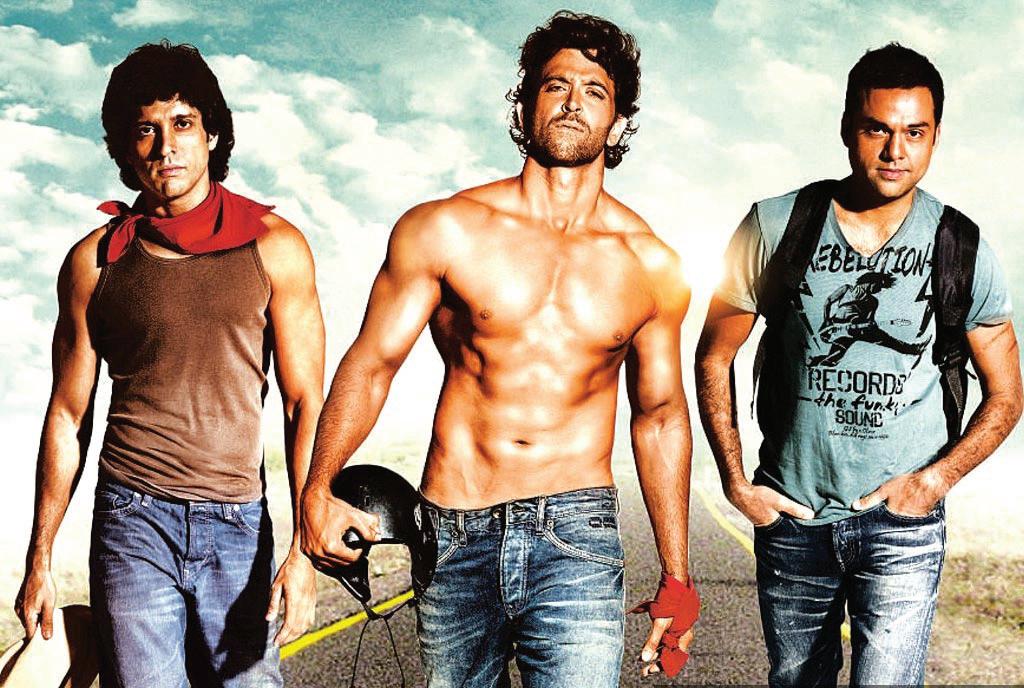
As the workaholic money-obsessed stockbroker (Hrithik Roshan), the happy-go-looking-for-his-dad prankster (Farhan Akhtar) and the about-to-be-married-nice-guy (Abhay Deol) set out on trip through locationally lush Spain (ummm, full marks for seductive eyecandy visuals) we follow right behind.
Without trying to set up dramatic road-blocks and U-turns in the road journey, Zoya Akhtar gets us so involved in the drama and adventure of the threesome we gradually forget the actors and see only the characters that they so fluently and robustly play.
Oh yes, the ladies take the backseat. Nonetheless Katrina Kaif’s Laila, a gorgeous diving instructor who teaches Hrithik to dive into soul, makes such graceful space for herself among the boys that we wonder how she managed to make herself heard in a film that celebrates the spirit of male bonding in all its robust colour splendour and noise.
Oh yes, we forgot! This guys’ film is directed by a woman! The feminine touch is nowhere evident in Zoya Akhtar’s direction. She leaves you wondering if delicacy femininity and the opposite of a snobbish misogyny that our desi female directors have been seen to follow, vanished while we were not looking.
ZNMD is a coming-of- age film on many levels. It celebrates the sheer beauty and physicality of location and their deep connection to the characters’ state of mind, without apology or explanation. Trust me. I looked. I couldn’t spot even one unpleasant face or topography in the entire length and breath of this beautiful film.
Now it’s Farhan’s sister Zoya Akhtar’s turn to take that road trip.
Some day we need to figure out the Akhtar siblings’ affinity to films about
Yes, the surface is lovely. But so is the soul. Zoya, God bless her aesthetics, sucks us into the beauty of the moment, not giving us any reason to believe that life’s most precious
truths are swathed in squalor. ZNMD celebrates splendour. Underwater or up in the air thousands of feet above sea level, the moments of tenderness are not stapled into the climate of camaraderie. They just happen. The moment when Hrithik discovers love under the stars with Katrina, or when Farhan Akhtar finally meets his biological father (Naseeruddin Shah, in a naturally compelling cameo) or that breathtakingly blistered moment of reckoning when after a bout of male backslapping in the initial episodes, we suddenly realize the cause for friction in the Hrithik-Farhan friendship… These are masterstrokes of muted drama not written in to impress, but simply as an integral part of that journey which we undertake so enthusiastically and willingly with the threesome. Technically the film wears its art on its sleeve. Carlos Catalan’s cinematography captures the pain and the fun in Spain without letting the touristic urge take over. Yeah, the film looks fetching. But not at the cost of the characters’ search for bearings in a world that mocks at the beauty of Nature. Editor Anand Subaya doesn’t cut the film. He carves the material in
shapes that a jeweller would probably like to imitate if he only knew how.
Every actor seems to the character born. Hrithik’s stuffed-shirt act would have been almost self-parodic were it not so sincere. Abhay Deol is a naturalborn reactor. But it’s Farhan Akhtar who steals the best role, lines and moments. He is in his element and the character that evolves in the course of the journey. Oh yes, he gets to mouth his father Javed Akhtar’s evocative poetry.
Katrina Kaif’s Laila is a kind of synthesis of mystique and sincerity that we had seen long ago in Leela Naidu. This film marks the coming-of-age of the Kaif. Kalki in a relatively brief role brings a kind of snide cuteness to the proceedings. Her character is sometimes the brunt of ridicule. She takes it in her stride.
Every major character at some point, appears ridiculous. That’s the beauty of the askew world that Zoya Akhtar and Reema Kagti’s script tries to make sense with doses of humour and warmth.
Subhash K. Jha
JULY (2) 2011 <> 65 NATIONAL EDITION ENTERTAINMENT
Are you using a registered migration agent?
In Australia, it is illegal for anyone to give immigration assistance without being a registered migration agent.
Christine Sykes, CEO, Office of the Migration Agents Registration Authority warned, ”For your protection, make sure your agent is registered with us. We ensure only fit and proper persons are registered migration agents.”
There are over 4,400 registered migration agents in Australia and overseas who can provide immigration assistance.
Ms Sykes also advised that, “They must keep up to date with migration law, abide by the Code of Conduct, maintain proper communication records and pass police checks.”
If you are considering using a migration agent:
- Check if the person is registered by going to www.mara.gov.au and clicking on ‘Find an agent’
- Always look for the unique Migration Agents Registration Number (MARN) – this number is issued to all registered persons by the Office of the MARA
- Lawyers or education agents must also be registered if they are providing you with immigration assistance
Remember: no one can guarantee you will get a visa – even if you use a registered migration agent.
The Office of the MARA also handles complaints about registered migration agents.
Ms Sykes suggests, “If you are unhappy with the services of your registered migration agent, you can complain to the Office of the MARA.”
“Making a complaint will not affect any visa application you have with the Department of Immigration and Citizenship.”
For your free copy of the brochure ‘Your rights – tips on using a registered migration agent’ visit Office of the MARA’s website at www. mara.gov.au or call 1300 226 272.
Phone the Translation and Interpreting Service first on 131 450 to speak to someone in your own language.
Matrimonials
SEEKING GROOMS
Match for Indian lady, early 50s, slim and good looking, 5’3”, no liabilities, Australian citizen, brought up in India with strong family values, loving and easy going, seeking honest and well settled man in view of marriage. Contact 0404 616 463 Email: k.rani134@gmail.com
Parents seeking suitable match for divorced girl (married for few days only), Hindu Punjabi Khatri, vegetarian, slim, beautiful, fair, 5’6”, B.Sc, B.Ed, PR status, Sydney, 08/12/1985, profile in SH82540957. Boy preferably settled in Australia. Contact 0450 761 716 or vkm5556@gmail.com
Seeking a suitable match for young looking, very fair Hindu lady, 53, 5’2, living in Australia for 25 years, works in government department. Groom must be between 47-55, well qualified, non-smoker, occasional drinker and vegetarian. Contact sydaus@hotmail.com.au
Seeking match for 39/165, unmarried, fair, slim, beautiful Indian Punjabi girl, family oriented and responsible, traditional values, IT professional, brought up in India. Australian citizen. Early marriage. Can relocate. Serious enquiries only. Caste no bar. Email with photo: sydgirl09@gmail.com
Punjabi Hindu Khatri, good looking, smart, homely girl, never married, 33, 5‘11”, looks very young, seeking tall Indian boy settled in Australia. Two brothers well settled in Sydney, caste no bar. Contact with photo and details on 0425 910 007 or ricky.bhalla@ gmail.com
Match for 30-year-old Manglik Hindu Khatri girl, 5’5”, fair, slim, well educated with moderate values. Innocent divorcee, has a son (no legal issues). Brother settled in Sydney.
Looking for a well settled and educated boy, 32-38 years old. Min 5’ 6”. Caste no bar. Interested contact with bio-data and photo. Email: matrisyd@gmail.com or call 0418 770 827.
SEEKING BRIDES

Well settled family in Australia invite alliance for 27-year-old, 5”11, Sood Punjabi boy, B.Software Engineer (honors), working as a senior IT consultant for the Australian govt on high income. Seeking Indian girl, caste no bar. Please call 0414 518 312, email aumohindra@gmail.com
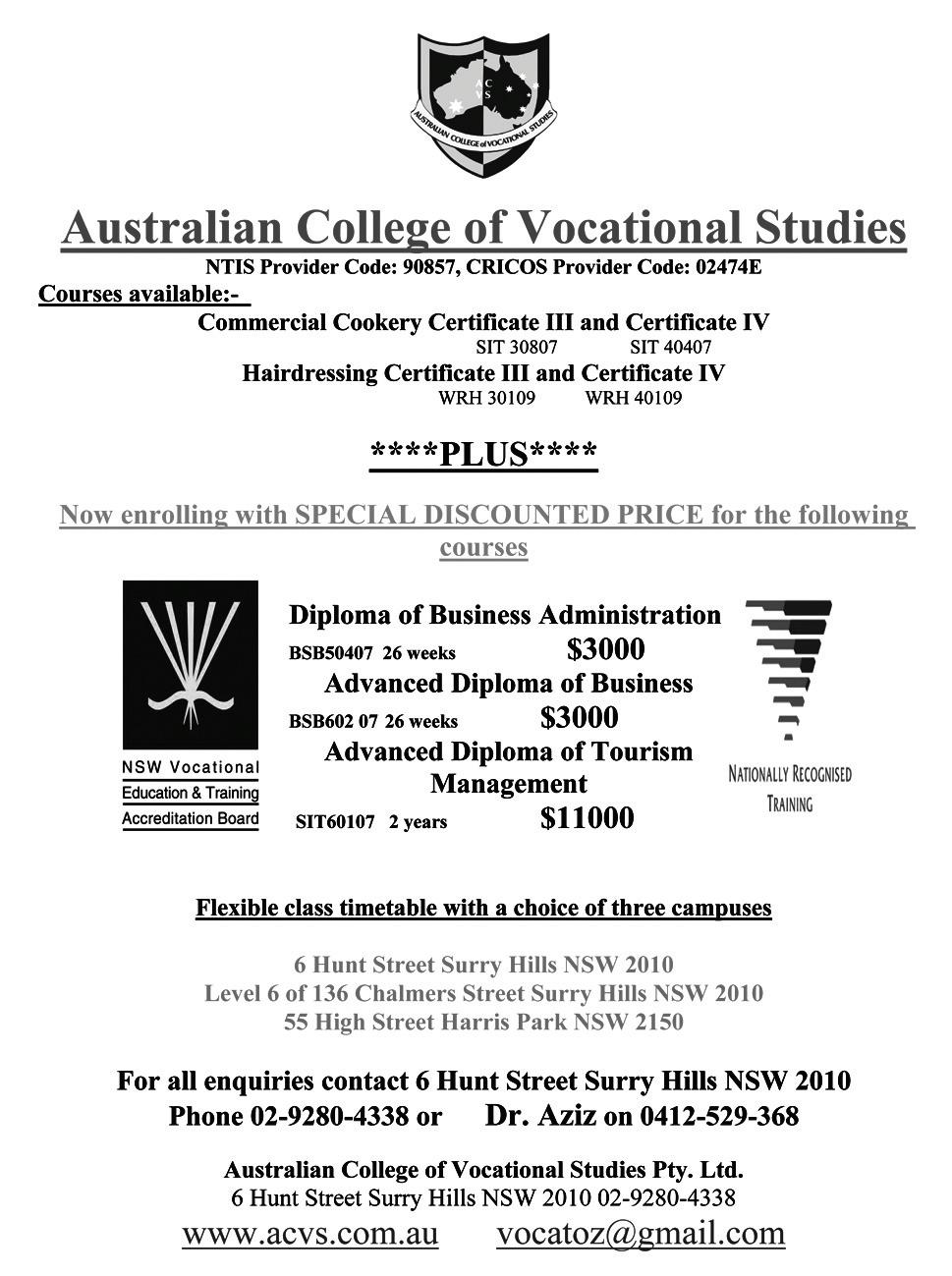
Aussie ocker Christian seeks Christian bride. I am in the fifties, 5’10”, 115 kg, own home, a full head of hair, pensioner. Contact 0459 919 717 or nottattached@aol.com
Hindu Punjabi business parents invite alliance for a beautiful educated girl for their highly qualified son 30/6’3”, a very well placed financial consultant with a leading MNC in UK. Will be in Australia in July. Caste no bar. Send bhp to ukshaadi@hotmail.com
Match required for an Australian citizen, Sydney resident, north Indian, 26 years old, 5’7”, slim, handsome and very fair engineer boy from Kayastha family. Looking for a suitable well educated Indian girl with family values. Caste no bar. Please send details to akhilsns@gmail.com or contact 0412 487 801.
Alliance invited for clean shaven Sikh/1972/5’11”/ very decent, responsible, handsome/BE/MBA boy, working as head of marketing in a software company in India, issueless divorcee. Kindly contact Manisha Bakshi on 0401 542 550 / manishabak@gmail.com
66 <> JULY (2) 2011 INDIAN LINK



JULY (2) 2011 <> 67 NATIONAL EDITION
Ask Auntyji
Give the kid a break!
Dear Auntyji
So what do you think, will Ash Rai Bachan have a girl or a boy? And are you willing you put money on the outcome?
Auntyji says
Oh, you shaitaan! Who places bets on the gender of a child who is no bigger than my thumbnail at the moment? Have you no sharam at all? And why all this fascination with the Bachchan baby? Let the poor mite be born, after all, this pitiful kid will have to live under the massive shadow of his or her dada and world’s most beautiful mother. Whether it’s a boy or a girl, it is bound to have a complex. So spare a thought for the child – it will not have an easy ride in life. And let’s all take a moment to wish Ash a safe pregnancy.
Racism without rancour
Dear Auntyji
I am an Australian and I work in IT with a lot of people from the Indian subcontinent. I used to think that Aussies were racist, until I met these Indians. Thiru from Bangalore does not like Ankit, a Punjabi from Jalandhar, while Hemant from Mumbai does not like Rohit from Hyderabad because he belongs to a different caste. Meanwhile, no one likes Nadeem because he is from Pakistan, but Neel is liked by all because he is from Fiji. While they are all professional and get the job done, sometimes I hear them talking about each other and I can’t understand all the rivalries. Once or twice they have asked me to adjucate on some matter and I always feel that I will make at least one person in the group unhappy. So what is your solution, auntyji?
Auntyji says
My, what an interesting conundrum you pose for me. I am indeed perched on the horns of a dilemma. Well, my first piece of advise to you is this. Much in the same way that Aussies dump all over the Kiwis or the Irish or whoever else takes
their fancy, let’s accept that folks from the Indian subcontinent are the same. If they are intelligent people, which they seem to be because they are professional, despite their differences – then these petty differences are just that. They might talk about these things, but it is not a problem. Of course, if you were in the Hindu quarter of Sikandar Alley in downtown Delhi and a riot was about to commence while you were visiting Nadeem’s Indian relatives, you might have had a real issue to deal with, but here in Sydney, this is nothing. So, celebrate the differences with the one thing that brings all Indians and Pakistanis together – and this is either Bollywood or cricket. Each time a petty squabble breaks out, use cricket terms to ask the team how Sachinbhai would deal with it. Each time they make reference to their differences, just quote Amitabh from just about any one of his movies – by saying – zindagi to bewafa hai. Of course, this will have no relevance to any argument taking place, but it will help diffuse the tension and deflect the topic. Tell your colleagues to do what
Amitabh would have done in Sholay, Deewar or Namak Haraam. They will be so impressed by your knowledge of these references to pop culture that they will immediately stop arguing and start discussing the merits of the respective films. If they don’t, just do a search for a clip of any of the Big B’s shows on YouTube and organise a 2-minute bonding session. All will be well after that. Yes, I am quite aware of how ludicrous my suggestions may seem, but you will be surprised at what brings Indians together. This is the glue that bonds them tight. Bollywood and cricket! And speaking of cricket, Nadeem was probably named after the great evergreen Pakistani actor. And wasn’t Wasim Akram in Delhi just the other day? Now Imran Khan – wasn’t he just a dish? Are you getting my drift? Let me know how you go. If things don’t improve and they all continue to get on your nerves, then you are well within your rights to stand up one day and declare that these people should go back to where they came from. This will definitely shut them up and give them all a common enemy – you!
YOUR CHANCE TO HAVE A BUSINESS IN INDIA
Experienced,successful network marketers who are looking for a ground floor opportunity with a large, debt free international company soon to launch into the subcontinent. This company is present in 19 countries. Only one product, No warehousing, Health beverage. We are looking for 3 leaders. Must be ambitious,Hard working,Honest and Teachable. I am only looking for people who are genuinely seeking their big chance in life and are prepared to work hard to get it.
Call Kevin on 0414012007
INDIAN GROCERY SHOP FOR SALE
68 <> JULY (2) 2011 INDIAN LINK BACKCHAT www.indianlink.com.au
Do you have a question for Auntyji? Send it in to GPO Box 108 Sydney 2001 or email it to info@indianlink.com.au
LOCATED WESTERN SYDNEY: Located in the fast growing suburb of Western Sydney in the heart of Indian/Sri Lankan/ Fiji community.
Long term lease and cheap rent (Less than 350 per week & 80 sqm) 2 minutes walk from station with 6 parking space Price: 35,000 - 45,000 negotiable Please contact: 0488038639 Email: slcstores@gmail.com



JULY (2) 2011 <> 69 NATIONAL EDITION

70 <> JULY (2) 2011 INDIAN LINK

JULY (2) 2011 <> 71 NATIONAL EDITION

72 <> JULY (2) 2011 INDIAN LINK

























































 BY SHERYL DIXIT
BY SHERYL DIXIT









 BY RAJNI ANAND LUTHRA
BY RAJNI ANAND LUTHRA











































 Ritam Mitra
Ritam Mitra


 Saarangan Arvind
Saarangan Arvind

 Varsha Srinivasan
Varsha Srinivasan






 Noopur Singhal
Noopur Singhal



 BY NOEL G DE SOUZA
BY NOEL G DE SOUZA













 BY SANDIP HOR
BY SANDIP HOR







































































































 Subhash K Jha
Subhash K Jha














